
Conversation

How can I assist you today?

No results found
Try adjusting your search terms or check for typos.
The Tactics Vault
Each week we spend hours researching the best startup growth tactics.
We share the insights in our newsletter with 90,000 founders and marketers. Here's all of them.

A Familiar Growth Story
A founder spots an opportunity. They go heads-down building. They launch to see if they have product-market fit.
Most never pass go. They deem “no PMF” and move on.
(Whether that’s actually true is a topic for another day. Plenty of startups declare no PMF when they never got the right people into the product to begin with. Talk about a false negative.)
But let’s say you’re one of the lucky few who sees signs of traction. Users are sticking around. Retention looks promising. "Jackpot!" Time to scale this puppy.
So you jump into channel experimentation. That’s what we’re told to do, right?
You try Meta ads. Doesn’t work.
You try cold outreach. Doesn’t work either.
You start posting on social. No one’s paying attention.
You keep testing channels, waiting for something to click. This cycle continues until you run out of cash or, by some miracle, you do find at least some semblance of channel traction.
The Hidden Problem
Here’s what’s actually happening.
In the traction phase, your early users found you through your network, through niche communities, through word of mouth (WoM). They’re the savvy, risk-tolerant part of the market. They like the product despite its rough edges.
And critically: they’re telling your story for you.
That's the beauty of WoM. Your early users "get it." Their friends are people that get it, too.
And this masks your foundational weaknesses.
You can get away with a mediocre brand, an unclear story, and a clunky value prop because your early users are papering over it with their own credibility and context.
Then you enter “growth mode.”
You start running Meta ads to cold audiences. People who’ve never heard of you. Who have no reason to trust you. Who don’t know what you do.
And suddenly, nothing works.
The False-Negative Trap
When those first campaigns flop, founders almost always blame the channel.
“Meta ads don’t work for us.”
But Meta may not have been the problem. More likely, the problem was that your story, which your early users had been telling for you, now had to stand on its own.
"Our story isn't the problem."
Ok. Well, did you engineer your product specifically for Meta Ads? Meta is what we call a 'low-context channel.' Low-context channels must be paired with low-friction product experiences. Did you tailor the product to align with the mindset and context-state people are in when browsing Facebook or IG?
Did you reverse engineer your pricing strategy to account for the inherent costs baked into Meta Ads for your product category? Or did you just roll with the pricing you threw together a few days before launch day?
No matter how you slice it, these aren’t channel failures. They’re system failures that were hidden during traction and exposed during growth.
We see this constantly. Founders come to us after months—sometimes years—of running in place. Blind experimentation. Channel after channel declared dead.
And more often than not, when we do eventually unlock growth, it’s through a channel they already tested and dismissed.
The Five Foundations of Growth
Growth isn’t built on product. It’s not built on distribution. It’s built on a system of five foundations, and the alignment between them.
1. Market — Who you’re serving
2. Product — What you’re offering them
3. Model — How you monetize
4. Brand — Your story and message
5. Channel — How you reach your market
Product-market fit is the alignment between #1 and #2. That’s one pairing.
One pairing out of the ten pairings that make up a full growth system.
The traction phase pressure tests almost none of these. Growth mode exposes all of them at once.
Which is exactly why we developed our Foundational Five Framework to represent that full growth system and help founders and growth teams master theirs.
How to Apply This
Before you give up on a channel, ask:
- Is this a Product-Channel problem? Has my product been designed to match the context, intent, and culture of this channel?
- Is this a Model-Channel problem? Can my unit economics actually survive this channel’s CAC?
- Is this a Brand-Channel problem? Does this channel give me the room I need to convey our story?
- Is this a Market-Channel problem? Is my market even reachable via this channel?
Different diagnosis, different solution.
The channel you abandoned might be your best channel. You just haven’t aligned the foundations around it yet.
Your Growth Foundation Is Never "Done"
Markets shift. Products evolve. What aligned last quarter might misalign tomorrow.
This isn’t a one-time exercise. It’s a living system for diagnosing where the constraints and opportunities exist within your growth system.
And it's the missing link that separates those who take a reactive, trial-and-error approach to growth vs. those who engineer it.
A Familiar Growth Story

Single vs. Double Opt-In: What Actually Works
Insight from Drew Price — VP of Growth Marketing at BryteBridge
Last week, we brought Drew in to help provide clarity on a classic question within the world of email marketing: "who should our emails come from — a person or the company?"
We received a ton of positive feedback on that edition, and quite a few requests to hear what other knowledge bombs Drew has to drop. So, we're tapping Drew once more to tackle another email marketing conundrum: opt-in methods.
It’s a common belief that double opt-in is the best way to collect emails, but that deserves a closer look.
Before we get into it, here’s the difference between a single opt-in and double opt-in process.
- With single opt-in, anyone who signs up in your email capture form or popup is immediately added to your list.
- With double opt-in, people need to confirm that they do indeed want to sign up in a confirmation email before they can be added to your list.
Many marketers recommend using a double opt-in by default because it brings in more genuinely interested people.
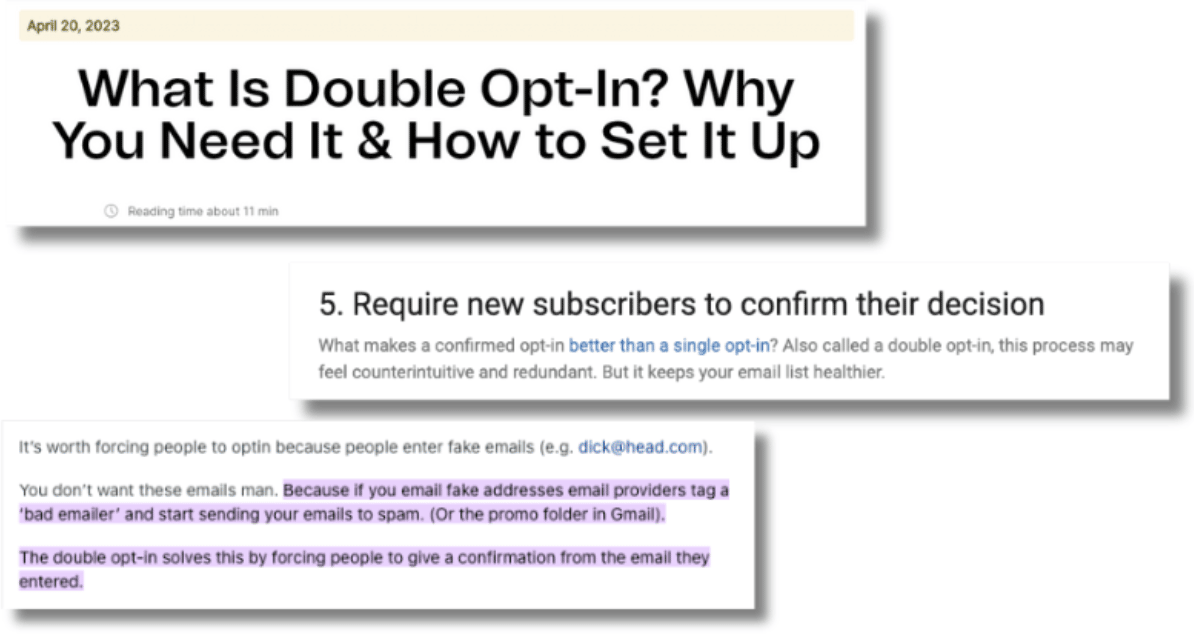
It’s a fair point: double opt-in processes do prevent fake email addresses and bots from getting added to your email list. But...
Double opt-in also comes with leakage.
That means:
- You’ll always have a percentage of people, even highly qualified leads, who miss your confirmation email. So you lose them for good. (Maybe they moved on with their day or are too busy using your amazing product to click on that confirmation email.)
- The confirmation creates a moment for an otherwise would-be subscriber to second-guess your intentions from a marketing perspective. So instead of confirming, they decide to ignore it.
Simply put, there will always be some good leads who ignore a double opt-in confirmation email.
Here’s a chart to help visualize that lost potential.
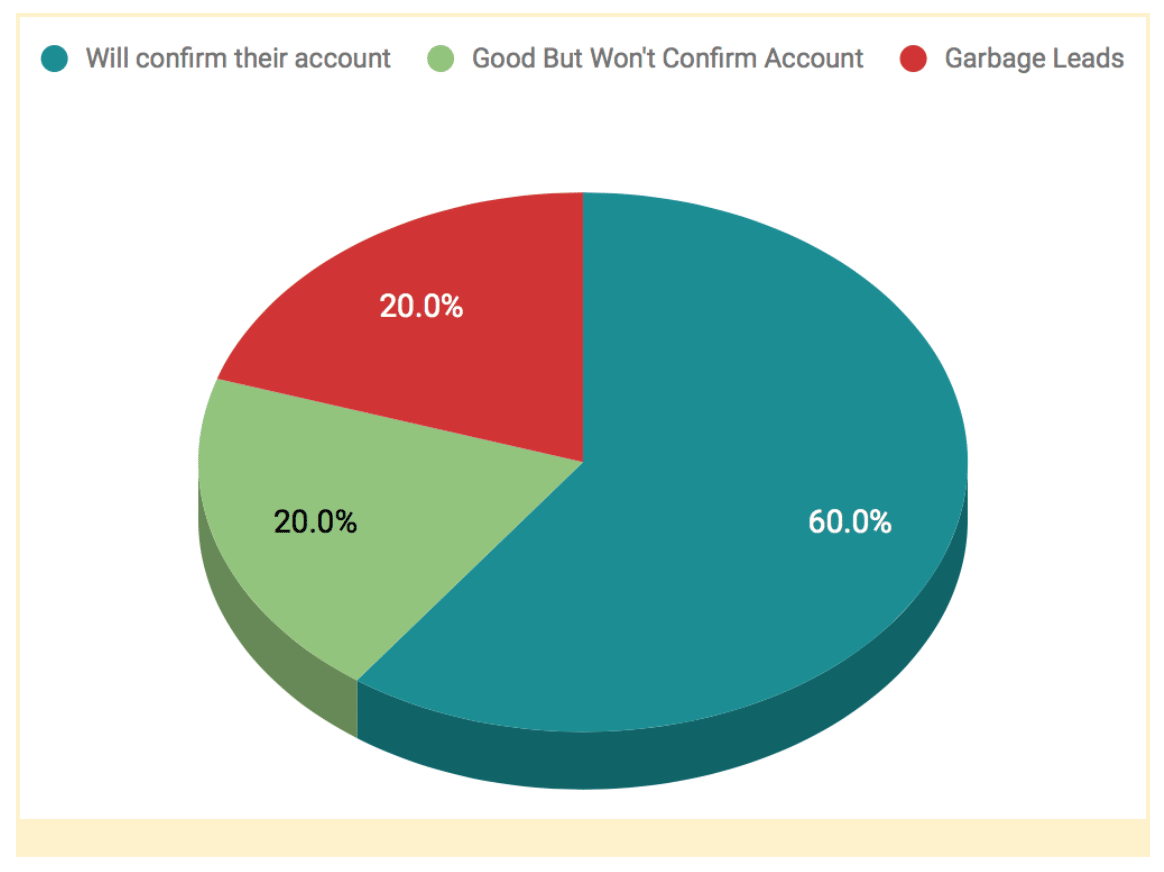
A single opt-in avoids this. One click and Voilà! That person is on your email list.
Yes, the single opt-in is inherently riskier because you’re inviting everyone to the party, even people who aren’t sure that your product is a good fit for them. But it comes with a higher ceiling of leads, a.k.a. greater potential for more revenue.
Deciding between the two feels like a case of "quality vs. quantity", but there’s actually a little more to it. If you’re not sure whether you’re better off using a single or double opt-in, consider these three variables:
- Your team bandwidth: Do you have a dedicated email marketer? Or is email juggled alongside other marketing priorities?
- Your email performance: How are your engagement metrics?
- Your reputation as a sender: Without diving too deeply into the technical topic of deliverability, have you ever noticed your emails didn’t make it to recipients? Like if someone told you they never received them or only saw them in their spam folder.
Who should use single opt-in?
You’re in a good position to use it if:
- You have a dedicated email marketer who’ll monitor your email performance. Someone who knows how to adjust your email targeting and suppression lists.
- You have a solid track record of strong email performance, like consistently high opens and engagement.
- And you haven’t faced deliverability issues in the past.
Who should stick with double opt-in?
Here are a few signals that you’re better off requiring that extra confirmation step in your signup process:
- No one on your team is focused solely on email. It’s low-priority, or something juggled between several other marketing priorities.
- You’ve seen a prolonged dip in your email engagement before, maybe in the last six months or so.
- You’ve been hit by an email penalty, like a blacklist, in the past. (If you don’t know this for sure, a prolonged dip in your email engagement could be a warning sign.)
Bottom Line
Implementing single opt-in is naturally riskier than using double opt-in. But the payoff is that if you do it well, you’ll actually have a higher amount of quality leads.
The point isn’t that every company must use single opt-in. But rather, we should simply stop romanticizing the double opt-in. Don’t think of it as the default in email collection. Choose based on your team bandwidth and email track record.
— Drew and the Demand Curve Team
Single vs. Double Opt-In: What Actually Works
Insight from Drew Price — VP of Growth Marketing at BryteBridge

Pick Your Sender: Brand, Human, or Both?
Insight from Drew Price — VP of Growth Marketing at BryteBridge
I remember seeing a Reddit thread asking for advice on what to use as the “from” name. A lot of people advised using the name of a human—real or fake—rather than their company’s name.

The idea behind this is to make your email more personal. This way, people are more inclined to read it. After all, people generally prefer to interact with other humans, not faceless corporations.
That said, using a person’s name can also backfire.
Imagine signing up for emails from a big-name company like Airbnb or Spotify. Unless you work for them, I doubt you know many people on their team. So when you get one of their emails with the name of a real person attached, you may not recognize it as coming from that big-name company.
As a result, you ignore or delete it. You might even mark it as spam.
In this scenario, using a brand name as the sender name would’ve had the opposite effect. You’d have known the business reaching out—not a stranger—and probably felt more inclined to read the message. The instant brand recognition creates a foundation of trust.
This is especially true for automated emails related to your product, like a bank transfer or service alert. In these cases, you could use your company and a specific department for extra clarity on what a message is about. Something like “Shopify Support Team” or “IKEA Shipping” or what you see below:
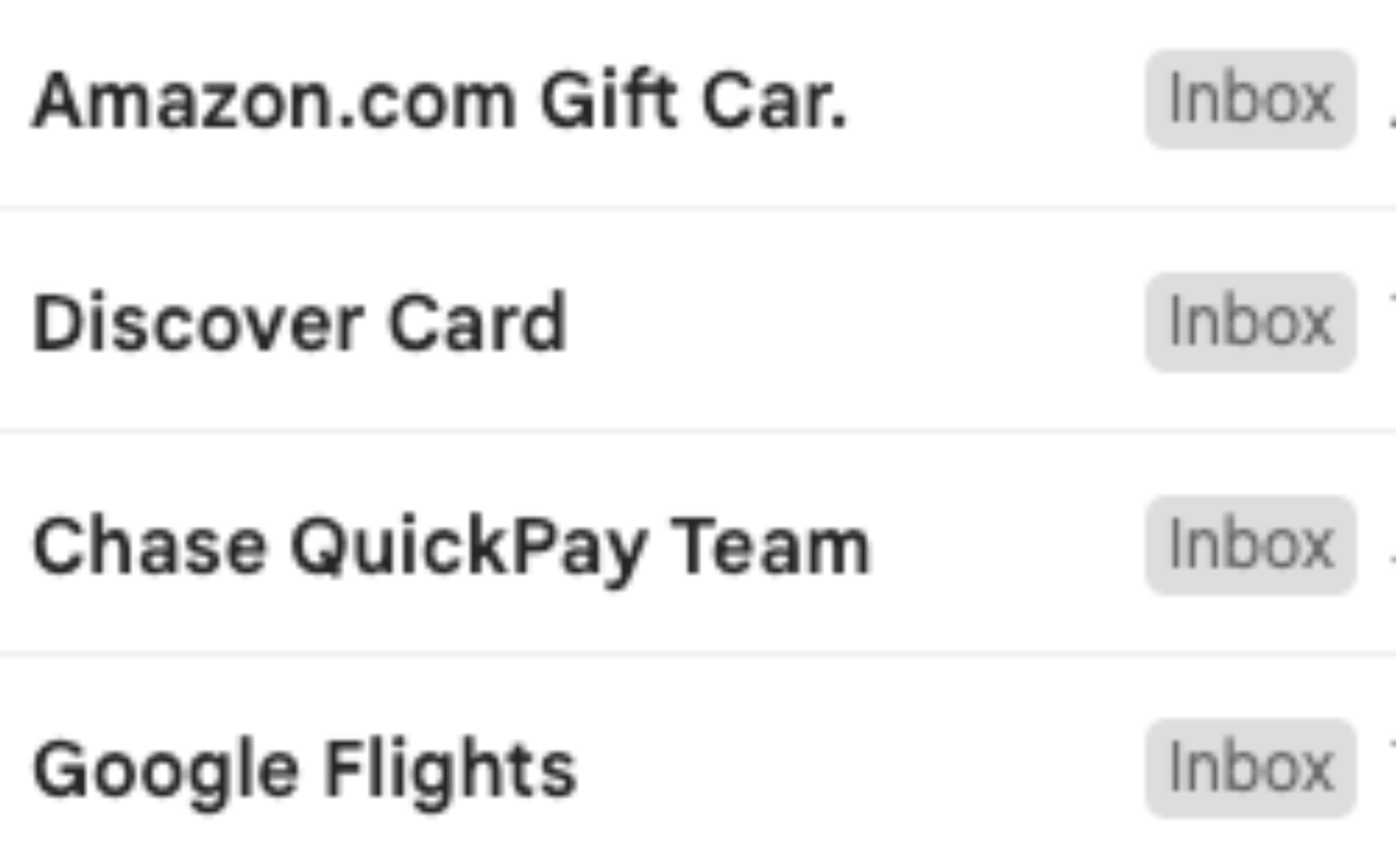
That doesn’t mean brand names always win out over human names, though. If your business is your personal brand, it makes perfect sense to use just your full name. For example, any entrepreneurs publishing their own newsletter.

And there’s also the hybrid approach:
- [First Name] at [Company]
- [First Name] from [Company]
- and so on!
These are a nice in-between, and ideal for relationship-based emails like your newsletter or customer support messages. However, since email sender names can be cut off, you need to watch out for long names.
Otherwise, they’ll look like these:

A simple antidote to long names: Drop your last name or leave it at just an initial. And instead of writing out “from”, try using “@” or a comma.
There’s ultimately a time and place for each type of sender name. And it’s important to choose carefully so that your contacts know who’s reaching out.
A quick recap:
- Use brand names for transactional emails like order confirmations, promotional campaigns, and automated alerts. If space allows, include the name of the team/department to give more clarity.
- Use a real person’s name only if you’re an influencer or thought leader, or your business is built around your personal brand.
- Use a hybrid for emails that focus on more building a relationship, even if they’re automated. Like a newsletter, product update, or sales outreach.
That's the sender name breakdown. It's one of those things that seems small but quietly influences whether your emails get opened or ignored. Worth getting right.
— Drew & Demand Curve Team
Pick Your Sender: Brand, Human, or Both?
Insight from Drew Price — VP of Growth Marketing at BryteBridge

Psychology of Conversion: 3 Tactics Worth Revisiting
Don't be logical, be psycho-logical
Insight from Rory Sutherland and Demand Curve Team
We decide with emotions.
Logic is often what we use to convince ourselves that our emotional decision is the right one, or to justify a past emotional decision.
Rory Sutherland shares a prime example in his book Alchemy. One of his clients was sending out physical letters asking for donations. Like all good marketers they A/B tested several different variations to see which brought in the most money:
- Control. The regular letter asking for donations.
- Donation matching. They highlighted that the government would match their donations, effectively doubling the impact of their donation.
- Heavier paper. They put the letters on higher quality, thicker paper.
- Hand delivered. They highlighted that a volunteer hand-delivered to their door.
- Horizontal opening. They used a special envelope that opened on the end, not on the typical long side of the envelope.
Variations 3 through 5 seem rather weird and extraneous to the whole point. And logically, the variation that highlighted the donation matching should do the best, right? You tell people that a $10 donation is actually $20, isn't that more motivating?
Wrong.
Variation #2 (donation matching) did worse than control. Variations 3 through 5 all beat the control, and the best was variation #5 (horizontal opening).
But if you asked those people why they donated, they'd probably say "it's a worthy cause, blah blah blah" and not "the weird envelope got my attention."
This is what Rory calls psycho-logical—logical in the context of human psychology.
An ad example
We used this principle 6 years ago for a client of ours that sold powerful computers for machine learning/AI purposes. We made an ad variation that made no sense:

You wouldn't assume sloppily adding dog ears and nose onto a $10,000+ work computer would make it more likely that someone would purchase it.
Yet, this became one of their best-performing ads at the time.
It stopped the scroll and made them look a little closer. And no one else had done it.
So be a little crazy with your ideas.
Sometimes eye contact isn't ideal
Insight from Katelyn Bourgoin.
In a previous newsletter, we shared an AI tool that maintains eye contact in videos.
But eye contact isn't always the best option.
Studies show that ads using averted gazes lead to more attention toward the product, and more memorable ads.
We're hardwired to notice faces. And when you see eyes looking over at something else, you're naturally drawn to look, too.
See for yourself 👀

This same tactic can be used on landing pages and product photos. Use your models' eyes to make people look where you want them to—your product, your CTA, or where you want them to go next.
This can also apply to social media profile photos. The direction your profile photo faces can make it either feel like you've got your back to your post, or like you're facing it.
Which of these looks better? I bet you it's the first one.

Be like Beyoncé: motivate with mystery
Insight from Neal O'Grady.
Would you rather win a trip to Hawaii? Or a ✨mystery prize✨ of the same value?
Turns out that people are more motivated by a mystery prize than they are when they know what the prize is.
People love to dream.
Beyoncé knew this when she released her album, Renaissance. She gave people the option to buy a $40 "mystery box."
People were generally told what was inside:
- Collectible box
- CD
- 4-Panel Softpak
- T-shirt
- Photo booklet
- Mini poster
They also had the option of choosing between four different "poses." This was Beyoncé's pose on the T-shirt—but there was no way of knowing what that meant!

What could a loyal Beyoncé fan do but to buy all four?
That means loyal fans ended up buying four copies of her album for $160, when her album normally sells for just $18. That's a 9x increase in order value.
She sold out of all of her mystery boxes in under two days. And the album ended up being one of the biggest of the year, and one of her biggest of all time.
Use mystery to motivate your customers.
We did this with our course, Un-Ignorable. During the early bird sale, we promised a "mystery bonus." And we sold out 50+ seats for the course in less than an hour.
Psychology of Conversion: 3 Tactics Worth Revisiting

Is multitasking back?
Insight from Kevin DePopas — Demand Curve Chief Growth Officer
If you were job hunting between 1997 and 2001, you probably listed “multitasking” on your resume. It was the era of always-on work culture and the first BlackBerrys. Being "busy" was a status symbol.
Then research started coming out that killed the party. A widely-cited 2001 study from the University of Michigan found that task switching creates measurable "switch costs." Every time you shift between tasks, your brain stumbles and you lose time and mental energy getting back into what you were doing.
Another blow came from Stanford in 2009. A team of researchers studied heavy multitaskers and found they were actually worse at everything. Worse at filtering irrelevant information. Worse at task switching (despite all that practice). Their memorable conclusion was that heavy multitaskers are "suckers for irrelevancy."
By the early 2010s, the conventional wisdom had flipped. Multitasking became shorthand for distracted, ineffective work. And since then, most of us have adapted. Single-task. Deep work. Batch similar activities. Block out distractions.
For 15 years, that advice mostly held up.
When Multitasking Became Productive Again
Last year, OpenAI released ChatGPT o1 with extended "thinking" time (they've since rebranded it as ChatGPT 5 thinking, but same concept). Claude followed with their own extended thinking mode. These models often take 10 to 60 seconds (sometimes several minutes) to process complex requests.

Most people frame this as a limitation. "ChatGPT 5 thinking is slower." "Claude extended thinking takes forever."
In my actual workflow though, I've found a way to make use of the downtime. When I send a prompt to ChatGPT thinking or Claude's extended thinking mode, I'm not the one holding the cognitive load anymore. The AI is doing the heavy lifting on that task. My working memory is free.
So instead of staring at a loading bar, I'll switch to something else. Reply to an email. Edit a doc. Review a piece of copy. Then when the AI finishes, I come back and review the output.
Unlike traditional multitasking, I'm not trying to hold multiple complex problems in my head simultaneously. I'm acting as a router. I have two AI systems handling complex, independent tasks, and I'm structuring what I want them to accomplish. It turns anyone into a manager, orchestrating the work rather than doing it. When I return to review each AI's output, I'm evaluating and refining rather than creating from scratch.
Don't get me wrong, this workflow is susceptible to producing work and analysis for the sake of it. You still have to gut-check yourself, just as you would if you were managing an employee.
Is it worth having your AI work on this task, or are you just creating busy work?
The Parallel AI Workflow
Here’s my current pattern when I have multiple AI-heavy growth/marketing tasks:
- Fire off the first complex prompt to ChatGPT thinking (ad research, competitor analysis, whatever)
- While it thinks, open Claude, Gemini, or another LLM reasoning model and start a second task (landing page feedback, email draft, etc.)
- When ChatGPT finishes, I review and refine its output (this takes maybe two minutes)
- Send the follow-up to ChatGPT, then return to your second AI tool
- Repeat with staggered timing across both tools
I’m basically orchestrating parallel AI workflows. The “wait time” between sending a prompt and getting results becomes productive time for other work.
I tried to find examples of other people writing about this pattern. Simon Willison and Gergely Orosz have both written about running multiple coding agents in parallel, but most of the discussion I found focuses on the agents themselves.
What I’m describing feels slightly different. The human is genuinely multitasking during the AI processing time. And because each AI holds the cognitive burden of its own complex task, the context-switch penalty seems way lower than traditional human-only multitasking.
For Discussion
I'm curious whether you're experiencing this too.
When ChatGPT or Claude is processing a complex prompt, do you wait? Or have you started working on something else? Have you noticed the context switch feeling different than it used to?
Hit reply and let me know. Am I genuinely unlocking efficiency through multitasking or am I just another "sucker for irrelevancy?"
Kevin DePopas
Demand Curve Chief Growth Officer
P.S. Any Stanford researchers reading this? Might be time for a follow-up study.

Why Unsubscribes Aren’t the End of the World
Insight from Drew Price — VP of Growth Marketing at BryteBridge
Here’s a little analogy to help explain the difference between unsubscribes and spam complaints: If your email is a party, then an unsubscribe is someone leaving. And a spam complaint is someone calling the cops about it. 😱

Because when someone reports your email as spam, email service providers take that to mean your message was low-quality or unsolicited, maybe even malicious.
Not the case for unsubscribes. People usually unsubscribe because they’re no longer interested in hearing from you, even though they once were.
Yes, this could be a sign of poor content on your end—or it could simply mean that your recipient’s mind has changed. And if that’s happened, there’s no point in continuing to contact them. You’re better off focusing your communication efforts on only those who are highly interested in what you have to say.
With that in mind, it’s in your best interest to make it easy for people to unsubscribe. If you don’t, well, they’re much more likely to click the spam button.
The norm is including your unsubscribe link in your email footer. But we’ve also seen a few other unique spins on unsubscribe links.
Julian Shapiro, for example, places an unsubscribe link at the top of his emails, and Christopher Penn uses a giant GIF so readers can’t miss it.
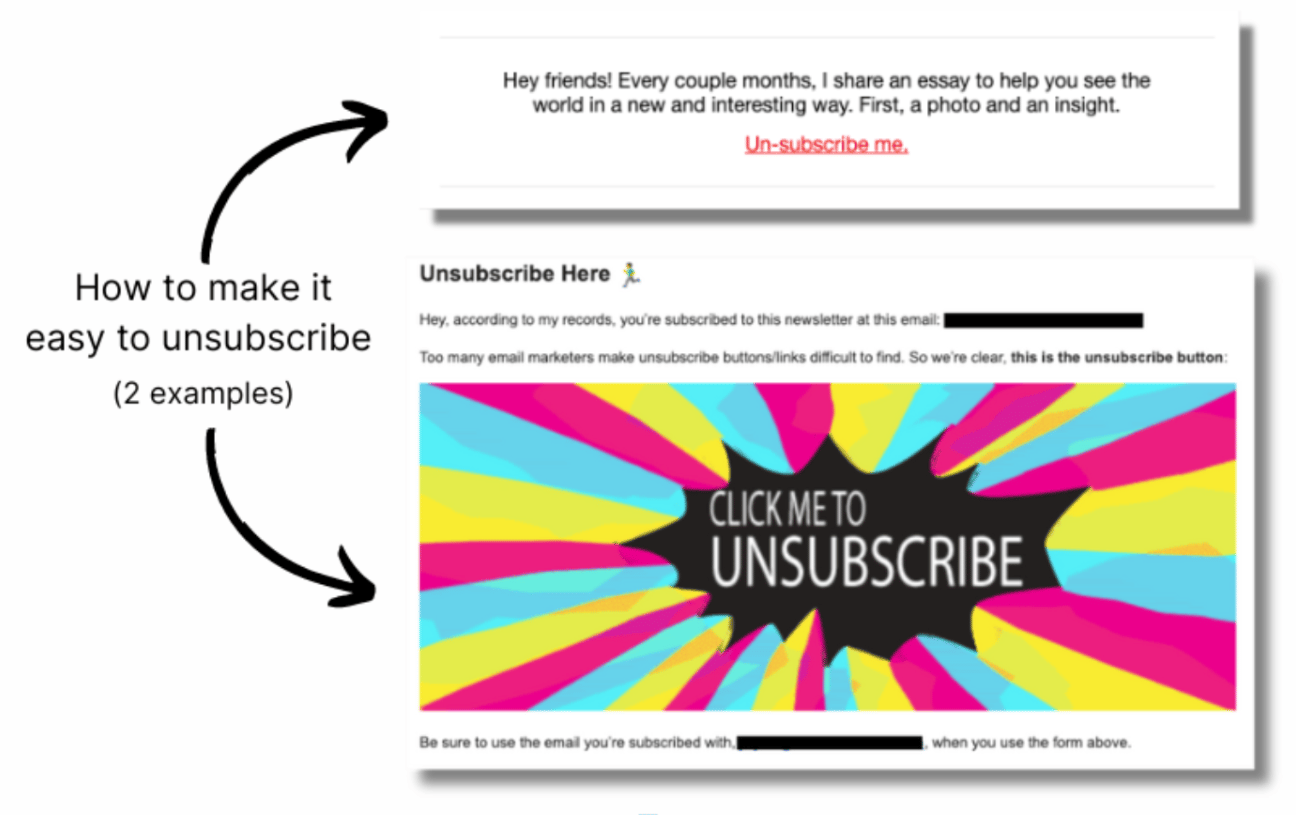
Okay, so unsubscribes aren’t all that bad. But certainly, a high unsubscribe rate can’t be good. So is there an unsubscribe rate you should aim for?
Yes—0.5% or less. Anything higher may be a sign that:
- You’re attracting the wrong leads, aka people who aren’t in your target audience. Or, if you are attracting the right leads…
- Your content isn’t resonating. Lots of possibilities here. Maybe you’re not really speaking to your reader’s concerns or you’re not segmenting your audience.
(These issues are a whole ‘nother conversation. Instead of taking this email on a long tangent, I recommend checking out these two blog posts to learn more: this one about growing your email list and this one about segmentation.)
Making it easy to unsubscribe from your emails doesn’t mean readers will drop off in big waves. It’s really more of a kind courtesy. Going back to our email as a party analogy, you’re just letting guests know where the exit is.
You’ll also be doing yourself a big favor in the long run. An email list with a lot of deadweight—inactive people who delete your emails without a second thought—will inevitably have low opens and clicks. Better to let them unsubscribe so they don’t:
- Make a spam complaint; or
- Bring down your email engagement metrics.
To recap:
- Compared to spam complaints, unsubscribes aren’t all that bad.
- A healthy unsubscribe rate is 0.5% or less.
- You should make it easy for people to unsubscribe from your emails. Besides a link in the footer, consider adding another link at the top of your message (scroll to the top of this email for an example).
So next time you see an unsubscribe notification, take a breath. It's not a rejection, it's just someone clearing the way for the people who actually want to hear from you. And that's the list you want anyway.
– Drew
Why Unsubscribes Aren’t the End of the World
Insight from Drew Price — VP of Growth Marketing at BryteBridge

Why Curiosity Beats Convincing in Founder Sales
Insight from Kevin DePopas — Demand Curve Chief Growth Officer
When Sales Conversations Matter (Even If Sales Isn't Your Growth Engine)
If you're building a $20/month app with low contract values, you probably can't support the time, energy, and overhead that comes with a traditional sales process. Those economics typically work better for companies with high annual contract values and high lifetime values (think enterprise SaaS, not consumer apps).
But even if sales isn't your primary growth engine, direct sales conversations are often the fastest way to validate your concept.
For example, what's the fastest way to get your first paying users for that $20/mo app idea?
Is it building the entire PLG stack? Spinning up paid ads? Creating a survey to blast out to random people?
In most cases, no. It's finding 50 potential buyers on LinkedIn and striking up conversations with them.
You'll likely learn more in two weeks of direct conversations than you will in two weeks of surveys, landing page tests, or building features in isolation.
Why Founders Avoid Sales (And Why That's Costly)
The resistance to sales conversations isn't just "I don't like selling."
It's usually deeper than that. These are the things founders tell themselves:
- "I need to know more about sales first"
- "I need to build out my CRM"
- "I need automated sequences"
- "I need to understand AI sales agents"
- "I need to finish that sales book on Audible"
- "My product isn't ready yet"
- "I need a slick slide deck first"
- "I need a sweet website"
- "I need to hire a sales person"
- And the list goes on...
I've found that you can start building momentum through sales with virtually nothing. No deck. No website. Just you, a clear understanding of the problem you're solving, and a list of people who might have that problem.
But there's a trap.
If you approach these conversations in a "salesy" way (pitching, pushing, trying to close), you risk getting false negatives. People don't respond. You conclude you're on the wrong path. You assume you need to build more before going to market.
When in reality, the issue wasn't your product or your timing. It was your approach.
When trying to get early traction, your initial goal (counterintuitively) isn't to close deals. It's to start conversations. And the way you start those conversations determines whether you get real validated learnings.
The Mindset Shift
For me, the single most powerful reframe for early-stage sales conversations was this: curiosity beats convincing.
"When you're selling, you're not selling. When you're not selling, you're actually selling." - Me
Sounds like some nonsense Ricky Bobby would say, but let me explain.
The more you push, the more people feel sold to. Your prospect's guard goes up. They start looking for reasons to say no. Your close rate drops.
But when you lead with curiosity (when you're genuinely trying to understand their problem), something changes. Their guard comes down. They open up. They start to trust you. And your close rate typically goes up.
This applies whether you're selling a product to a potential customer or selling your vision to a potential investor or strategic hire. The mechanics are the same. Lead with curiosity.
Here's what that looks like in practice.
Ask for advice, don’t pitch
An investor once told me:
"If you want feedback, ask for money. If you want money, ask for advice."
It didn't make sense at first. But here's what he meant. If you tell an investor you're raising and want their money, they'll give you the realest feedback on every reason your idea might not work. They start poking holes. It puts them in a defensive stance from the outset.
But if you ask that same investor for advice on your concept, you've created a low-stress opportunity to just talk.
Next thing you know, you're 45 minutes into a 30-minute conversation, digging into the nitty-gritty details of your business, and they're arriving at the conclusion that your concept is a good one, rather than you convincing them.
This works because you're appealing to a fundamental human desire: people love to help and share what they know. And it works in any “selling” situation.
In sales:
❌ The pitch approach: "Hey Kevin, as a growth leader at Demand Curve, you've probably tried scaling DC's growth agency through outbound sales. My company's new AI SDR booked 6x more meetings than a human for half the cost in a single week. Worth a chat?"
✅ The advice approach: "Hey Kevin, how are things going with Demand Curve's growth agency? I just launched an AI SDR that's pretty damn good at booking meetings. I think agencies could be a fit, but I’m not sure. If you have a sec, do you mind if I ping you a few questions so you can pick this apart? Feel free to be brutally honest."
The second version doesn't feel like a sales pitch. I'm being asked to help. If I was a betting man, I’d bet the response rate on the second version is dramatically higher.
In fundraising:
❌ The pitch approach: "Hi Sarah, I saw you invested in [similar company]. We're building in the same space and are closing out our seed round led by [VC firm]. We're opening up our cap table for a few strategic angels. Would you be interested in hearing our pitch?"
✅ The advice approach: "Hi Sarah, I saw your investment in [similar company]. We're building something in this space and are at a crossroads with our go-to-market strategy. I'd love to get your take on our approach if you have 15 minutes. Mind if I ping you a few questions?"
Same dynamic. You're not asking for money. You're asking for wisdom. If they're interested in what you're building, the conversation naturally evolves. If not, you've still built a relationship and learned something.
When you hit resistance, lean into it
Throughout your entrepreneurial journey, you're going to come across people who disagree with your approach.
Sometimes, the natural inclination is to get defensive (even if it’s done in a professional manner). But this can make each party dig in their heels. And news flash, it's really hard to convince people of things they don't believe.
If you've ever gotten into a fight with your partner and made the mistake of defending your logic before trying to understand how they felt, this might resonate with you.
You might find that when you ask a clarifying question, they actually misunderstood your approach to begin with. You might uncover a simple work-around to what was previously a deal-breaker. Hell, you might even uncover the pivot that becomes your core business through this line of questioning.
Here are some common areas where you might hit resistance and how to handle them:
In sales:
You don't need to have answers for every objection. When someone asks, "Does your product do X?" and it doesn't, just say:
"That's really interesting. Our initial feature set doesn't include that. But tell me more. How do you envision using that feature? Could [this workaround] be a temporary solution?"
You've turned what could be an objection into learning more about the problems your users are trying to solve.
In fundraising:
When an investor says, "I'm not sure about your CAC assumptions," don't get defensive. Get curious:
"That's fair. Walk me through what you're seeing. What CAC would make this compelling to you, and what would need to be true for us to hit that number?"
Now you're in a conversation instead of a confrontation. You're learning what would actually make this investor excited rather than trying to convince them with your existing model.
In both cases, be transparent: "I'm trying to learn if we can help. Where we can help today is X, and what we cannot do is Y."
If a conversation gets contentious, take the stance: "Look, I'm not trying to convince you of anything. I'm just telling you what we have. If it's interesting, great. If not, it sounds like we're not ready for you right now, but we should circle back once these features are in place."
The Takeaway
I think the mindset shift that matters most to be effective at sales is to be infinitely curious.
When you enter into conversations with this lens, it allows you to be authentic and gives you permission to not over-prepare or feel like you need to know everything before starting.
So next time you're nervous going into a sales conversation remember, when you're selling, you're not selling. When you're curious, helpful, and genuine, you're doing your best job selling.
Start today. Send a dozen connection requests on LinkedIn. Ask for their advice, not a sale. See what happens.
Kevin DePopas
Demand Curve Chief Growth Officer
Why Curiosity Beats Convincing in Founder Sales
Insight from Kevin DePopas — Demand Curve Chief Growth Officer

10 Tactics for Customer Reviews That Drive Sales
Insights from Science Says (formerly Ariyh) and Gil Templeton (Demand Curve Staff Writer).
Just to ground us before getting into tactics, remember, garnering great reviews for your business starts with your product.
Without a quality experience there, there’s virtually no way to foster great reviews (at least in an ethical or accurate way).
Only once you have a product that people genuinely enjoy or find useful will any of these tactics truly move the needle.
Now, assuming you’ve got your product down pat, let’s look at the tactics that can turn customer reviews into conversion fuel.
Tactic 1: Encourage Comparisons in Reviews
Strangely enough, whether it’s a positive or negative review, one that compares your product to another tends to be far better than a regular review that doesn’t compare it to anything else.
- Positive reviews that compare your product increase sales by up to 26%. They anchor your product as being better than competitors. For example, “The iPhone 17 has a better camera than my friend’s Google Pixel 10” is more persuasive and effective than “The iPhone 17 camera is really good.”
- Negative reviews that compare are up to 47% LESS harmful. We attribute their dislike to their personal preferences. Example: “The iPhone 17’s battery life isn’t as good as the Pixel 10’s” is actually less harmful than “The iPhone's battery life sucks.”
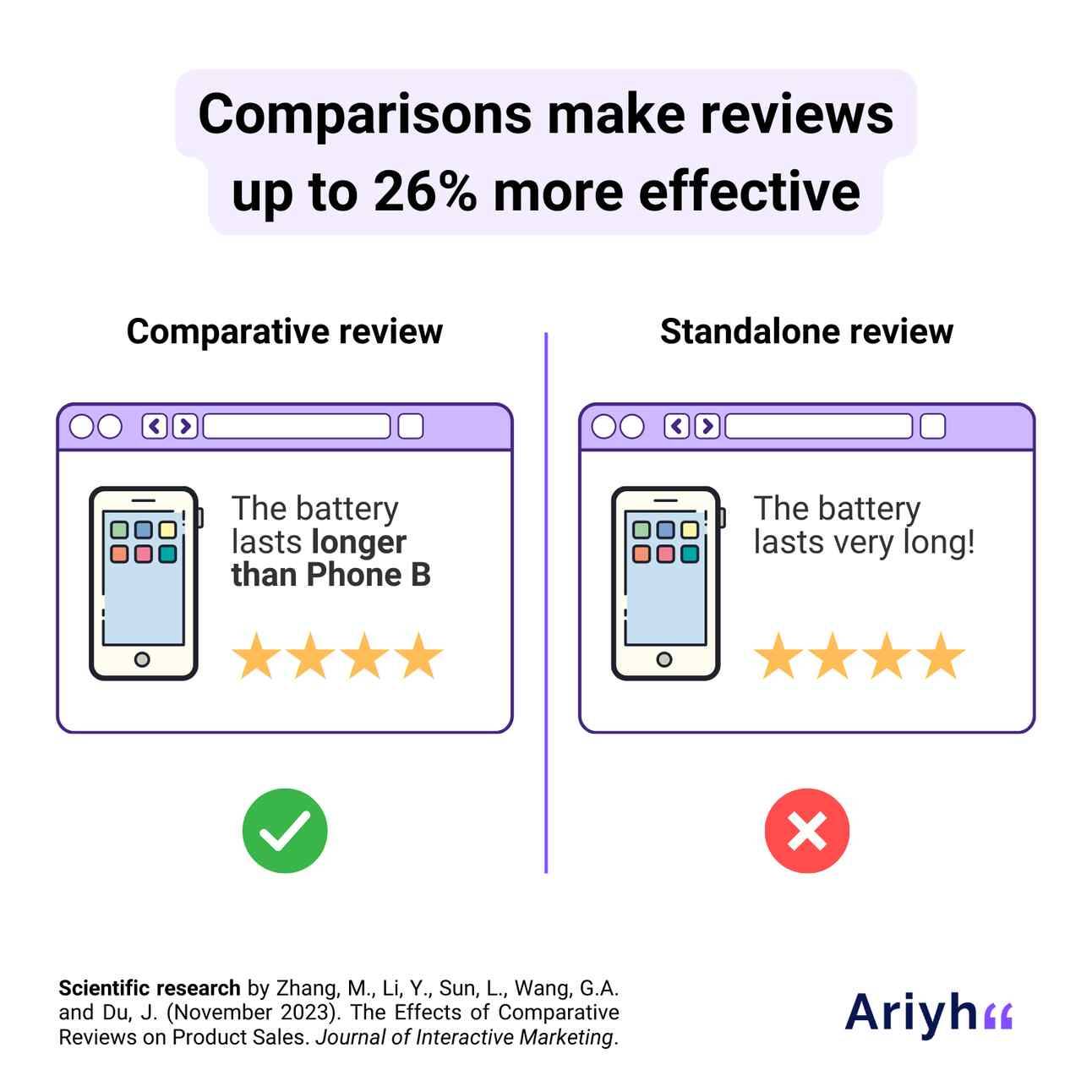
💡 You can seed reviews like this by pre-populating text fields or prompting people by asking: “How does (our product) compare to a similar product you’ve tried?”
Tactic 2: Know When to Display Expert Recommendations vs. Customer Reviews
Sometimes it’s better to display a few recommendations from experts instead of a boatload of simple customer reviews. This all depends on how easy it is for the average person to judge your product’s quality.
- If it’s easy for anyone to judge the quality of your product, then go with customer reviews. (Examples: T-shirts, food, hotels.)
- If it’s hard to judge and requires expertise, roll with expert recommendations. (Examples: insurance, dentists, educational institutions, software, agencies.)
💡 Think about it like this: Would you trust “Bob Smith” to recommend a heart surgeon? Or would you trust a doctor’s endorsement more?
Tactic 3: Boost Reviews With Incentives
The truth is, most happy customers will never bother to leave a review, even if you ask them to outright.
However, incentivizing them with free products, cash, gift cards, or contest entries makes it much more likely they’ll leave a review, and it’s also more likely to yield a positive review. Let’s take a look at some data via an example:
- A home improvement store's product reviews were 83.4% more positive when incentivized via sweepstakes entries.
- Even a modest $0.25 incentive paid immediately for rating and reviewing a video proved effective, leading to a 20.6% increase in positivity.
💡But remember: don’t explicitly ask for a positive review. That might backfire and come across as disingenuous or deceptive. It’s also against Amazon’s Terms of Service.
Tactic 4: Wait for a Bit to Ask for Reviews
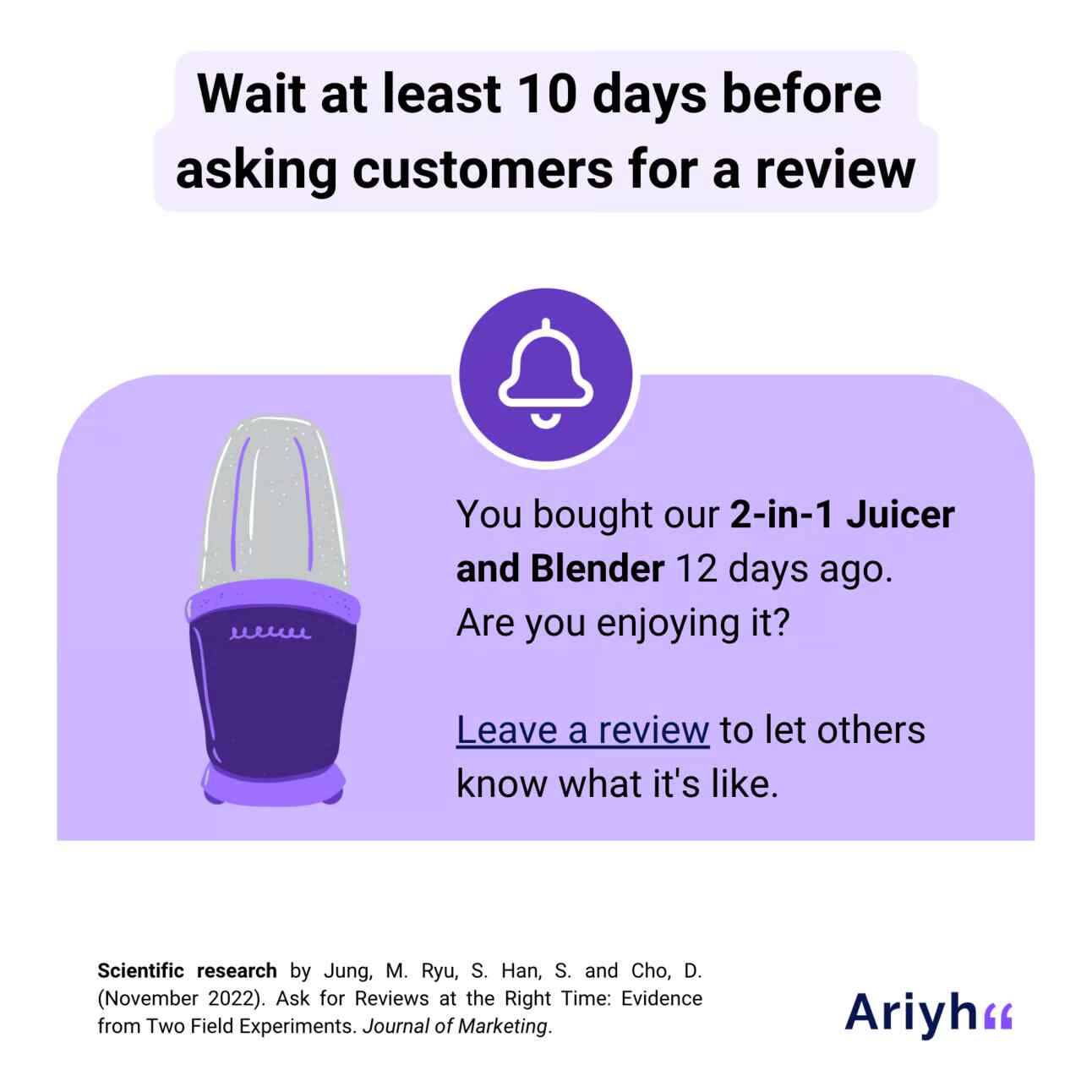
Getting asked to review a product you just got is a bit like a popup modal asking you to subscribe or book a call before you even know what the company does.
💡 Recommendation: Wait at least 10 days before asking for a review to increase the chance they review by 40-60%.
Additional recommendations for software reviews:
- Don’t do it based on time after signing up; do it based on milestones of usage (for example, they just hit their “aha” moment with your product.)
- Don’t ask them for a review when they’re clearly in the middle of something.
Tactic 5: Embrace the Occasional Negative Review
Let’s say you see a 4.9-star-rated espresso machine and start reading the reviews. They’re all resoundingly positive…to the point where you start to get a little suspicious they’re fake.
Then, you check the 1-star reviews and see: “There’s a considerable difference in taste when mineral or filtered water is used rather than tap water.”
You laugh and say, “That has nothing to do with the machine, you bozo! Well, if that’s all people have to complain about, then it must be good.”
Oddly enough, a low, fairly irrelevant review will improve your perception of a highly-rated product by ~15%.
💡 Takeaway: Don’t hide negative reviews if they’re irrelevant or just suggest a difference in taste/opinion with that customer. You might even consider showcasing reviews like this.
Tactic 6: Show “Likes” on the Product Page
Leverage the engagement your business or product has received on social media (the ultimate channel of social proof).
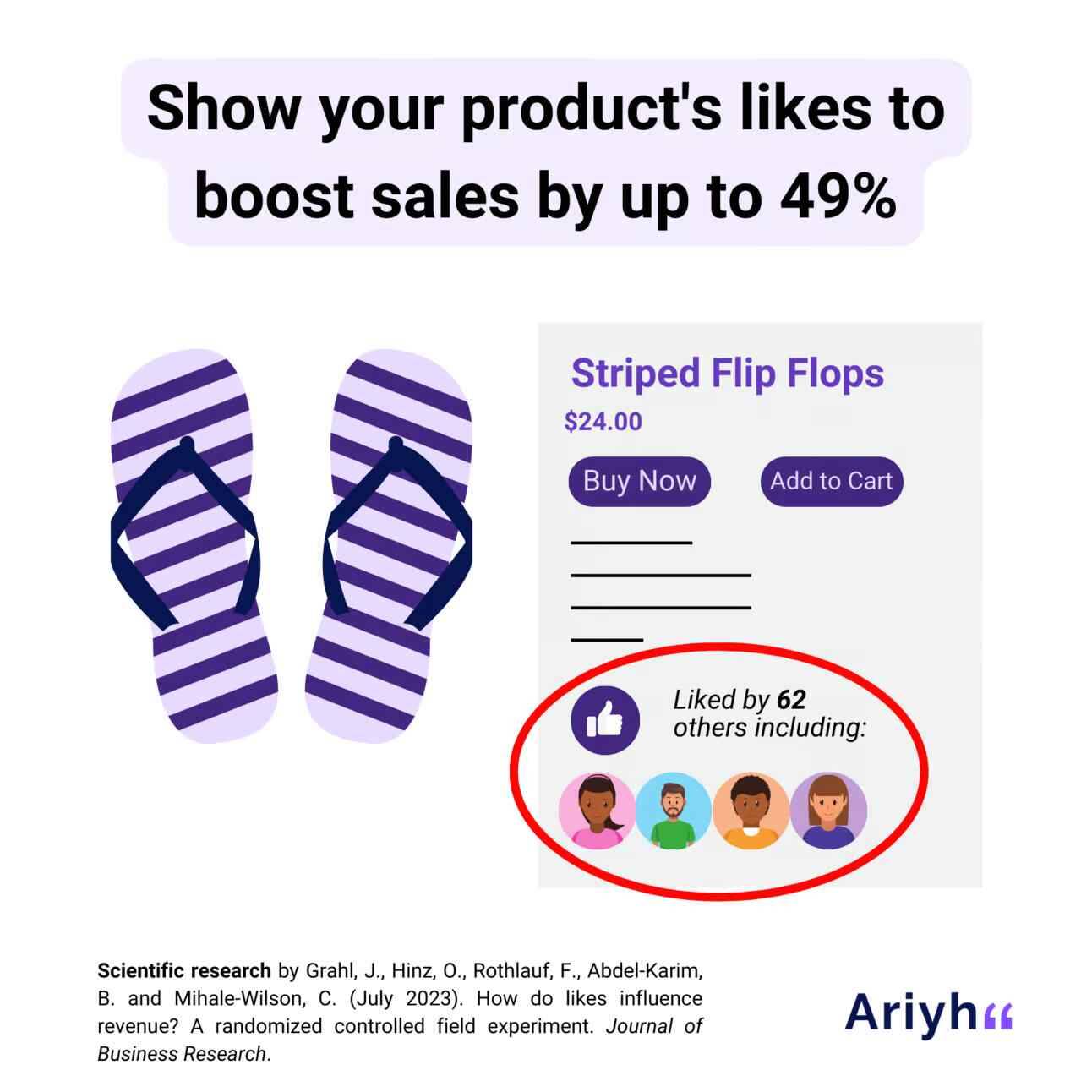
💡 Takeaway: Show a product’s likes and a few profile photos of people who liked it. There are web-builder apps and embeds that can pull these in automatically to your product pages.
Tactic 7: Set the Tone With a Strong First Review
Humans often fall victim to the Primacy Effect, a cognitive bias where people give disproportionate weight to the first information they encounter, which shapes how they interpret everything that follows.
So if the first review is negative, you’ll likely face an uphill battle with fewer sales, fewer reviews, and reviews with a more negative sentiment. And this effect can last for 3 years or more.
But the opposite usually happens if the first review is positive.
Here are some recommendations:
- Launch products to a select group of customers who are most likely to rate it highly.
- Launch on new marketplaces (like Amazon or Walmart) the same way.
- Reach out to early customers you think are happy and incentivize them to write a review.
- If you get a negative review early, do everything you can to make things right with the reviewer, hopefully steering them toward a positive outcome and updated review.
Tactic 8: Be Intentional About the Order of Your Reviews
Sales can be up to 84% higher if the first review is 5 stars versus 1 star, and we rarely read more than 10 reviews before deciding.
💡 Takeaway: Display at least one positive review first before displaying others. Never display a negative review first.
Tactic 9: Aim for a Great Aggregate Rating, Not a Perfect One (If It’s Your Own Website)
Oddly enough, sales peak between 4.0 and 4.5 stars and dip down at 4.5 to 5.0. At really high ratings, we become skeptical and assume the results are manipulated (note: the study referenced here focused on specific retail websites and not a third-party marketplace, like Amazon.)
💡 Takeaway: Don’t delete or hide all reviews lower than 5. Some honest 3’s and 4’s can help you come across as more credible.
Tactic 10: Reply to All Reviews
Replying to reviews can yield a handful of benefits:
- It can make an upset or disaffected customer change their mind and increase their rating (and maybe even stay a customer). For example, if they used the product incorrectly and got bad results, you can educate them on what to try for a better experience.
- It signals to people that you care about customers.
- A study showed it increased the number of reviews by 12% and increased the average rating by 0.12 stars.
The Takeaway: Reviews are the Currency of Trust
The internet has given us nearly unlimited options, along with nearly zero certainty. Reviews can act as a bridge between these two forces.
Good reviews can cut the distance between “This might be a good choice” and “I’m almost certain this will be a great choice” but only if they feel real, and not cherry-picked or forced.
Earning trust in the minds of prospects doesn’t come down to being perfect; you build trust through patterns of truth. The businesses that understand this earn compound interest on their credibility, using reviews as a rising tide that lifts all ships.
Gil Templeton
Demand Curve Staff Writer
10 Tactics for Customer Reviews That Drive Sales
Insights from Science Says (formerly Ariyh) and Gil Templeton (Demand Curve Staff Writer).

How to Make Quality “UGC” Ads Using Only AI
Insight from Kevin DePopas (Demand Curve Chief Growth Officer) and Gil Templeton (Demand Curve Staff Writer). This newsletter is part of a paid partnership with Arcads.
First, if you're still skeptical about the quality of AI UGC, watch these two videos made with Arcads. Can you tell these aren't real people?
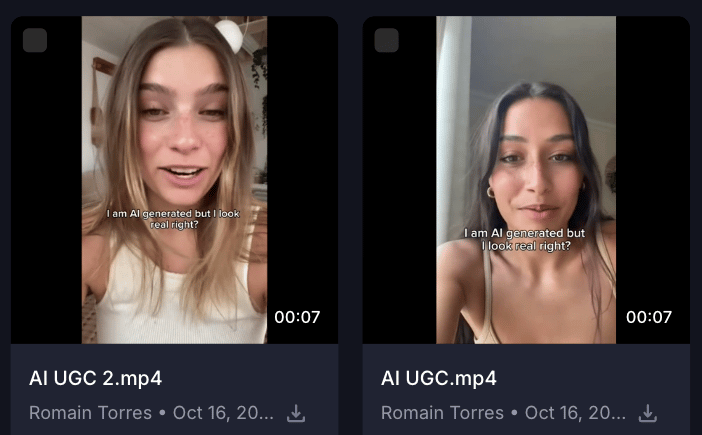
Everything from the camera shake to the mouth syncing to the AI audio is insanely good.
Which, for me, naturally raises the question: is this ethical?
During our meeting with Romain at Arcads, I pressed him pretty hard on this. His response challenged my perspective. He asked, “Is Photoshop unethical?” In other words, where’s the line?
Is it ethical for McDonald’s to painstakingly create the perfect-looking burger at a photoshoot (carefully applying ketchup with a syringe), then Photoshop that image to use on marketing materials, all to sell you a compressed, depressed burger in real life?

Is it ethical for George Clooney to be the face of Nespresso when I’d bet he enjoyed a different type of coffee when he woke up this morning?

Is it ethical for a pizza ad to mix glue in with their cheese to create the illusion of the perfect “cheese pull” when an actor pulls a slice out?

Is it ethical for a paid influencer to gush about how life-changing a product is when they don’t really feel that way in their heart of hearts?
Romain made the point that consumers aren’t easily fooled. They know advertising is “packaging” and they frequently suspend their disbelief, but what they want is to be entertained, and understand the ethos of what they are buying.
The regulatory reality: Yes, the FTC and “Truth in Advertising” laws still exist in the AI era. Therefore, you (and your AI avatars) can’t create misleading testimonies like “I used this product and it helped me do X, Y, and Z,” if it’s not true.
Therefore, much like Photoshopping a burger or a bikini-clad model, the responsibility to wield this tool ethically lies with the advertiser.
On its face, AI UGC isn’t inherently more deceptive than the tactics we’ve used for decades. (After all, most TV ads are scripted and delivered by paid actors.)
The key is transparency where it’s required and following the same FTC guidelines that govern all advertising (at least in the US.)
Common Misconceptions About AI UGC
Let’s take a look at some of the common hang-ups and misunderstandings people have around this type of approach.
Misconception #1: The False Negative Effect
This is the biggest barrier to full adoption, and it has more to do with impatience and unrealistic expectations than the videos themselves.
Marketers might create a couple AI UGC ads, test them for a few days, see no tangible results, and come to the conclusion that “It didn’t work.”
Romain was all too aware of this roadblock. He said you usually need to test 10–20 ads minimum to unlock a real winner. The best performance-marketing brands test hundreds or thousands of videos in a month, helping them drive results in competitive channels.
Arcads’ client Learna didn’t hit $2M monthly revenue because their first AI ad went gangbusters. Since starting with AI UGC, they’ve literally tested 10,000+ variations. This insight isn’t unique to AI, it’s just good testing discipline. But people mistakenly think AI is a magic bullet that works instantly.
Romain’s advice: If you’re not willing to create and run 50–100 ad variations over three months, AI UGC probably isn’t for you yet.
Misconception #2: AI Eliminates the Work
As a creative by nature, I know this one all too well. People tend to assume AI is a magic “make it” button, which it’s not…at least if you want to make something decent.
In this case, AI requires quality input from you, then often requires additional steps for a thoughtful assembly.
Here are the types of shots you can create purely inside of tools like Arcads:
- Talking head videos
- Gesture clips (celebrating, embracing, etc.)
- “Show your product” scenes
- B-roll elements
After generating these assets, you’ll still need to stitch them together and finesse further using editing tools like CapCut or After Effects.
Romain estimates that his platform takes production from 3 weeks to 3 hours (but not 3 minutes), so video editing remains a bit of a bottleneck.
A good analogy for this is writing content with AI. Sure, you can use it to create better content faster. But you can also lean on it so hard, you end up making low-quality slop. Think of this as a tool that amplifies your capabilities, speed, and production budget, but it doesn’t replace your creative process.
Misconception #3: AI UGC Doesn’t Look Real or Convey Emotion
This was my initial skepticism, but here’s something to consider as a counterpoint:
People cry watching cartoons. People laugh at memes. Neither of these emotions requires a video of a real person. Last night, I was absolutely cracking up at an unhinged AI-generated video in my TikTok feed.
But even setting that aside, AI videos are certainly reaching the realism threshold and getting better every day.
Romain shared an example to this point. Olivia Moore (who’s a partner at tech-forward investment firm a16z) created a TikTok account featuring an AI character who was rushing sororities at the University of Alabama. Young viewers provided emotional support to the AI character who was crying in her second-ever video that has 177k+ views.
Regardless of whether people see these AI-generated characters as real or not (this gap seems to be getting smaller and less important to people at the same time), these avatars are capable of evoking emotion.
That’s why the last remaining barrier is good storytelling; you need to create the stories and intrigue around these people to drive emotion.
What You Need to Succeed With AI UGC Ads
Before we get under the hood and walk through our tutorial, here are Romain’s recommendations for who this platform makes the most sense for.
- Ad spend: Around $10k+ per month helps justify the platform investment (though Romain has seen people test at lower budgets)
- Testing discipline: Systematic creative testing process already in place
- Time commitment: 3–4 months of consistent testing, not just a one-week experiment
- Skills: Basic video editing (CapCut or similar)
- Mindset: Comfortable creating a higher volume of ads to test (think dozens of ad variations monthly, not just 2-3)
If you don’t meet all of these criteria, it doesn’t mean AI UGC categorically won’t work for your business. We’re just cautioning that you need budget, you need to be rigorous about testing, and you need to commit for a reasonable period of time to unlock success with AI UGC.
Our Live Case Study: AI UGC Ads for the Growth Program 2.0
Let’s walk you through our process for using Arcads to generate video ads promoting the Demand Curve Growth Program 2.0.
Step 1: Research & Hypothesis Formation
This is the part where we poke and prod around, taking stock of what’s working for competitors or good analogs in other categories.
- Foreplay - Shows top-performing ad assets by niche
- Meta Ads Library - Search competitors and educational products to see what they’re running long-term (if an ad runs for 3+ months, it’s a sign that it’s probably working)
We also looked at what Arcads’ customers in education/newsletters are doing. Their clients in the micro-learning vertical have found success using his platform.
Our three hypotheses for Growth Program ads:
- Problem-Agitation Angle: “Stuck testing random tactics without a system? Here’s how 3,000+ founders built growth engines…” (Targeting the scattered founder)
- Transformation Story: “We went from $0 to $XM by following one growth framework…” (Social proof + aspirational)
- Authority/Contrarian: “Most growth advice is garbage. Here’s what actually works…” (Pattern interrupt)
We’re going to roll with the first one (the problem-agitation angle) since that best aligns with our research and strategy.
Step 2: Script Development
Key insight from Romain: Most people underinvest in the script. Without the right input and editing, ChatGPT and Claude spit out mediocre scripts. Good scripts tend to use:
- Simple, conversational language
- Specific customer verbatims (pull from Reddit, customer interviews, TikTok search insights)
- Emotional arc (not monotone)
- Clear hook in first 3 seconds
So whether you use AI to help you write scripts, or you want to write your own from scratch (like the pilgrims used to do) then go for it.
Here’s the prompt I fed ChatGPT to create one for me:
Write a short UGC-style testimonial script for a startup founder talking directly to camera about their experience with The Demand Curve Growth Program.
The tone should be conversational, honest, and natural, like something you’d see on TikTok or YouTube Shorts, not a polished ad.
Structure it in four short, distinct sections.
- The frustration of trying every growth tactic (Facebook ads, SEO, partnerships, cold email, etc.) and failing to get traction.
- The key realization that tactics don’t matter without a system.
- The solution—how the Growth Program helped them build a real, repeatable growth engine.
- A natural, founder-to-founder style CTA encouraging others to check it out, mentioning there’s a waitlist but it’s worth it.
Keep it at or below 600 characters and 30ish seconds of spoken length, use plain English, and make it sound like something a real founder would say in their own words, not overly “salesy.”
And after a little finessing, here’s a solid script we can roll with:

In line with the ethics discussion above, here’s how you could adjust the script to maintain the same punch and relatability, without implying firsthand experience:
“Most founders go through the same phase: trying every growth trick they can find—ads, SEO, partnerships, you name it. And it never really scales.What actually works is having a system. That’s what Demand Curve’s Growth Program teaches: a repeatable way to grow.”
Step 3: Adding Voice and Emotion
Now it’s time to get into the platform and start putting this thing together.
Arcads lets you add emotion tags directly in the script using brackets: [frustrated], [excited], [whisper], [sad]. There’s also an automated button that suggests where to place these tags.
There are two approaches to this:
Option A: Script tagging (what we’ll be using)
- Write script, add emotion tags manually or via AI suggestion
- Select from voice library or generate custom voice from prompt
- Arcads interprets tags and modulates voice accordingly
Option B: Speech-to-speech
- Record yourself reading the script with natural emotion
- Arcads clones the tonality and applies it to the AI avatar
- Best for native language (Romain uses this for French ads)
Pro tip from Romain: If you have a winning UGC ad with a real person, you can upload that audio and use speech-to-speech to replicate the tonality with different AI avatars. This lets you scale a proven winner fairly easily.
Here we’ve uploaded our script, selected our video format (Talking Actors), selected those emotive “audio-driven” avatars, and AI automatically tagged five emotional cues.
I wasn’t expecting to see “mischievously” at the end, but I could also see that working for a snarky little eyebrow raise at our sign-off. We’ll roll with it for now and see what we get.
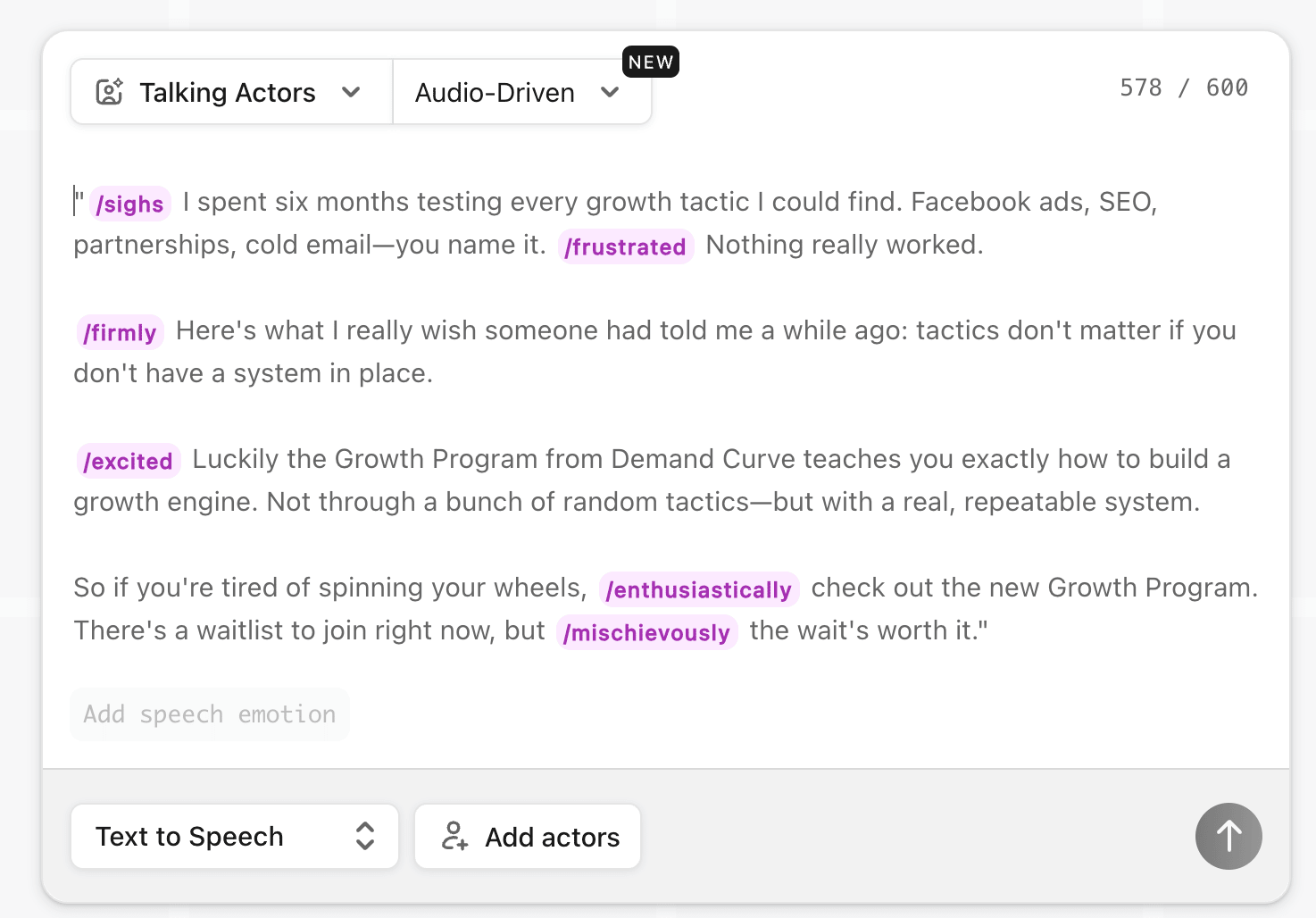
Step 4: Avatar Selection
Now it’s time to find our formerly frustrated founders. We want to use avatars that resemble our target audience, so this is what we looked for.
Our approach:
- 30-45 years old
- Male and female
- “Professional enough” appearance
- Prioritize avatars with a scroll-stopping presence
We toggled the appropriate demographic selections for our crowd, and we were also able to pick from a range of situations, backgrounds, occasions, etc. that might fit our founder persona.
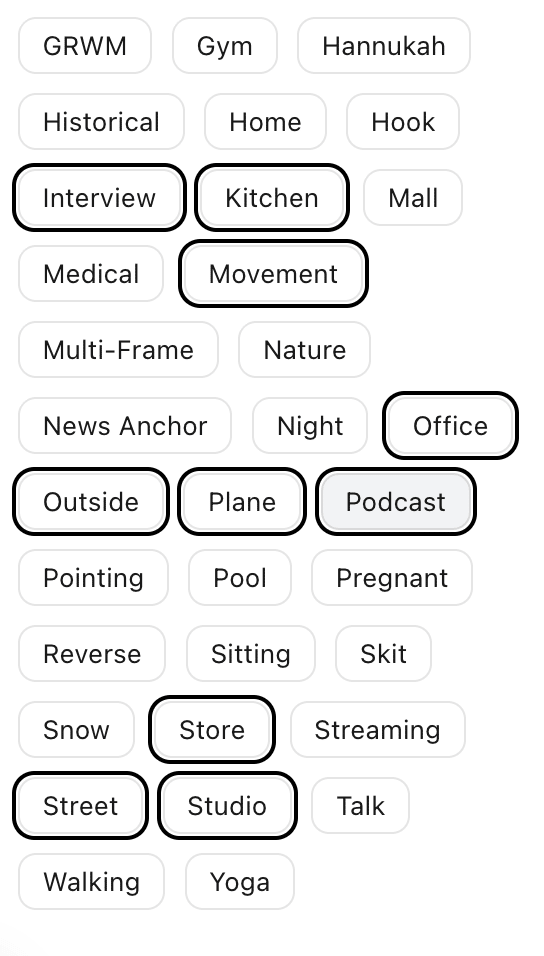
Romain’s note on models: Arcads now offers multiple AI models (Talking Actors, Audio-driven, Omni-human). The newer “Audio-driven” and “Omni-human” models generally convey emotion better because they interpret the audio and facial expressions simultaneously. Start with those.
Once we entered our filters, we were met with 200+ avatar options. Hovering over one of them cues their intro video to start, which was a great feature to convey their personality quickly.

From that group, I chose four that fit the bill for our audience and showed a range of situations/environments/production levels: Audrey, Elias, Steven, and Lauren.

After selecting these four avatars, we could preview and adjust their delivery to match what we’re going for, then the platform updated the audio clip shortly after we made our adjustments. We could do this all with our “actors” at the same time, which made it easy to assess.
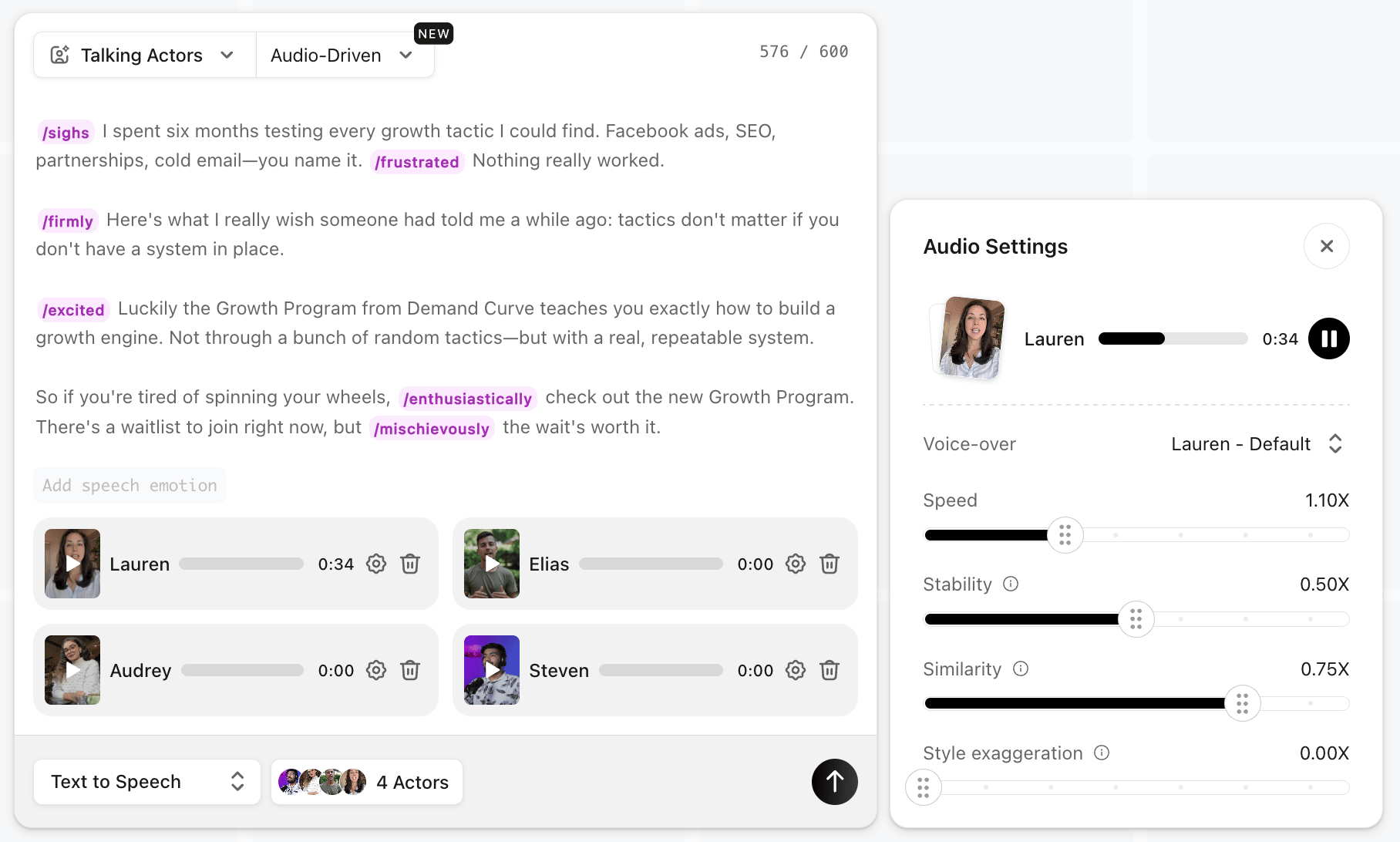
Step 5: Generate the Assets
After tweaking the audio outputs, I clicked the black arrow at the bottom, and I was pushed to one final step to generate all four assets at the same time, which took about 10 minutes.
They work on a simple “credits” system where, unlike many AI image/video platforms, it’s very easy to see how many credits you’re using and how many you have left. My four marquee videos cost four credits. Nice and simple.
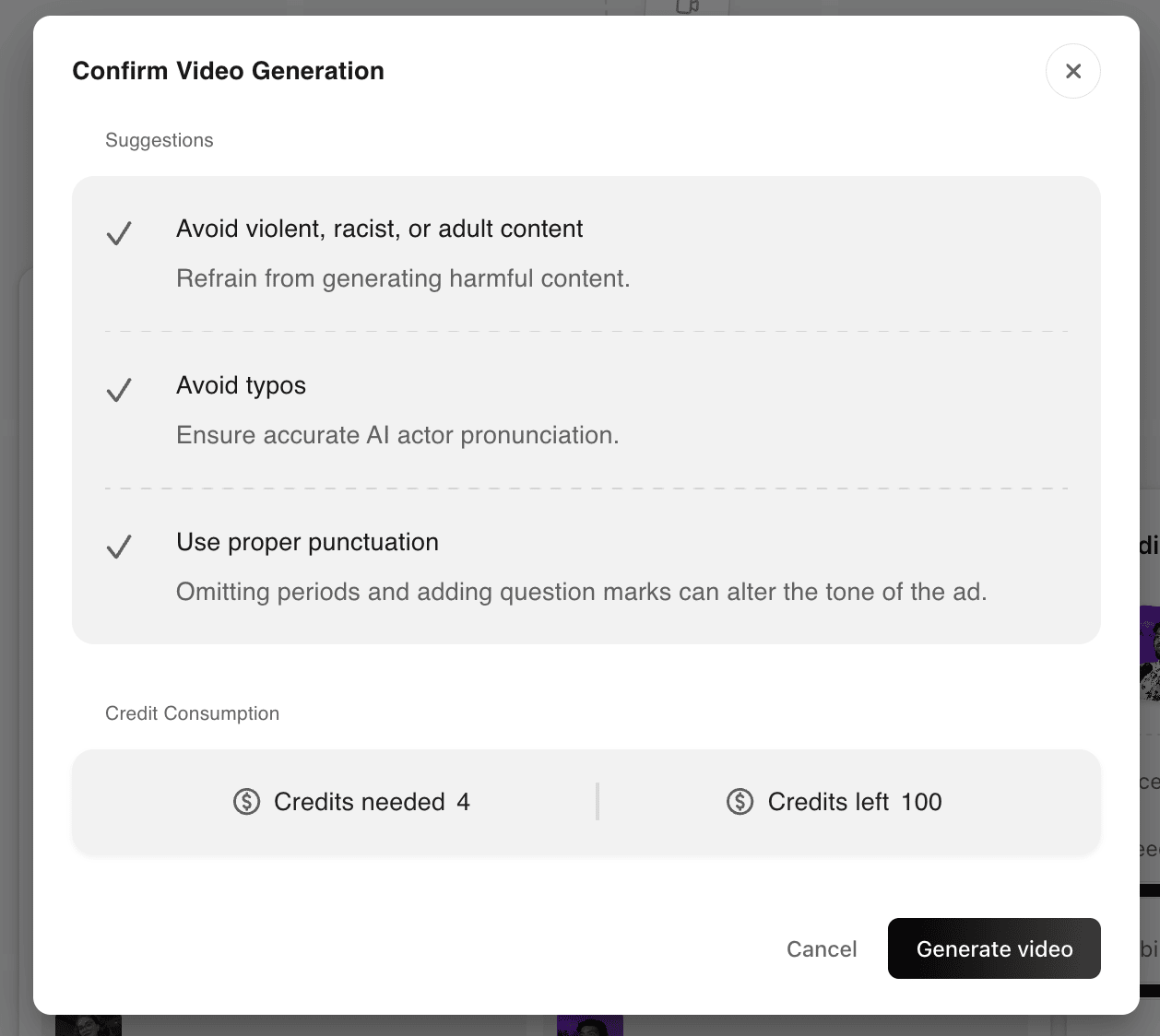
The results were pretty convincing if I’m being honest. Some were better than others in this first batch (Lauren, shown below, was amazing in particular), but nobody fell into the uncanny valley.
Only someone with a keen eye/ear and a healthy dose of skepticism would ever suspect my video (screenshotted below) was made with AI, especially when a good editor could patch over any hiccups with B-roll clips and keep the energy up.

Unfortunately, this is the part where a static email newsletter can only show you so much about the fun I had and the quality outputs I generated. Check out the full output here.
To me, it seems like the videos that were more casual and had more movement came out better than ones with locked shots, polished production, or straight deliveries.
I also easily generated a complementary “gesture” clip where one of our avatars, Elias, opens up a laptop and smiles like he’s seeing some good news on his laptop. Same exact process, I just toggled the model to give an “AI Gesture” and provided a sentence of direction. Since it was less involved, shorter clip, this one only took half of a credit.
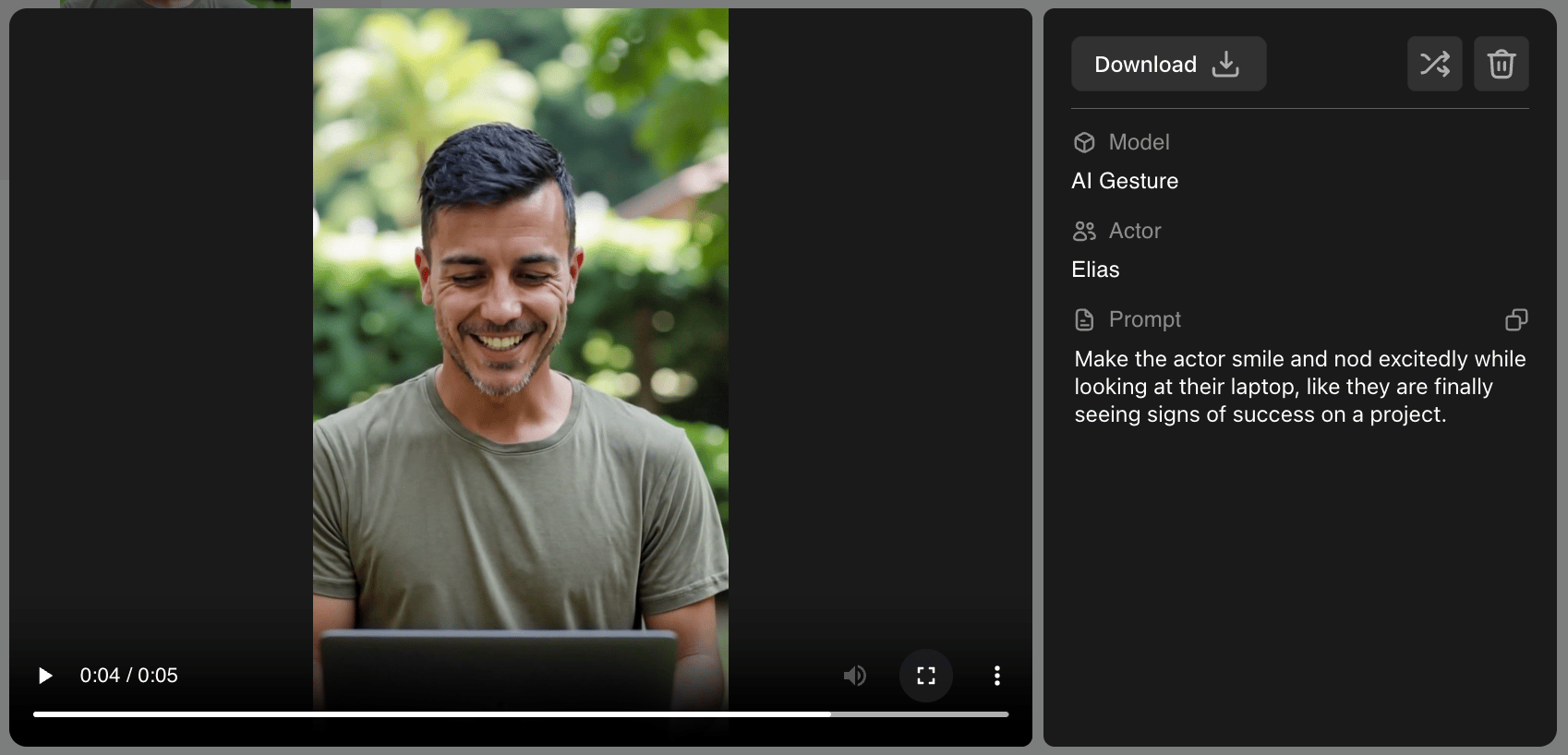
These kinds of clips would be useful in the video-editing process where you need a quick cutaway or motion to break up the monotony of a talking head visual.
Also, if you see a moment where the mouth and audio aren’t working in lockstep, or if you just need a Band-Aid over some AI imperfection, these types of shots would be super helpful.
I tried another type of shot, where someone is showing your app or website on their phone. The natural reflection of the window was a nice touch. Although I had trouble finding our four selected actors to deliver this shot.

How We’d Edit From Here
If the team decided to move forward with this approach to promote our Growth Program 2.0, I’d take my talking head videos and B-roll videos, edit them together in CapCut for pacing and naturalness, add captions (critical for sound-off viewing), and maybe consider some other touches like transitions, a light music bed, superimposed text, or branded assets.
Romain from Arcads says younger audiences tend to require a more dynamic, lively edit. While older audiences (50+) often respond best to minimal editing (talking head and captions).
This step is the biggest bottleneck in the process, but it’s key to creating assets that work hard and paint you in a professional light.
Lastly, How Would We Test?
Keep in mind, this is not a one-ad test. This takes volume, patience, and testing. Here’s how we’d test:
- Create 5-10 variations of this same concept (different avatars, slightly different scripts, varying editing styles)
- Test all variations simultaneously on Meta
- Run for minimum 7-14 days (or until out of learning phase, or when one ad set clearly pulls away from another)
- Analyze which elements are working (avatar? script hook? editing style?)
- Double down on the winners, drop the losers
- Repeat weekly, bi-weekly, or monthly (depending on how much you’re spending)
Romain’s process recommendation:
- Week 1-2: Test 20 ads across multiple script angles
- Week 3-4: Create 10 more variations of winning scripts
- Month 2: Iterate based on data
- Month 3: Scale winners, introduce new test concepts
The Takeaway
We’re there. We’re at the point where AI video assets (when given quality input, good judgment, and a strong edit) can pass as realistic, engaging videos made by real people. My experience with Arcads convinced me of that in half an hour.
This technology can be especially useful for startups who are cash-strapped and need to stretch every dollar. But while it can seriously alleviate some production/budgetary burdens, it’s not a magic “make it” button.
It’s a powerful tool that requires discipline and many of the same established growth fundamentals, but it allows you to make better ads faster, when done right.
With great power comes great responsibility, so generate responsibly.
Gil Templeton
Demand Curve Staff Writer
Kevin DePopas
Demand Curve Chief Growth Officer
How to Make Quality “UGC” Ads Using Only AI
Insight from Kevin DePopas (Demand Curve Chief Growth Officer) and Gil Templeton (Demand Curve Staff Writer). This newsletter is part of a paid partnership with Arcads.

The Power of the Pattern Interrupt
Insight from Gil Templeton — Demand Curve Staff Writer
Many businesses and marketing teams might think they’re tapping into pattern interruption when they’re really just doing something different. But those aren’t necessarily the same thing.
Differentiation is a more strategic, long-term approach. It’s the proverbial “zig when they zag” play that clearly defines who you are in a category.
But pattern interruption is way more micro. It’s a mere moment. It’s the “Wait, what?” that makes someone snap to attention and notice you in that instant.
So try to think of it like this (building on our driving analogy from the intro): “Zigging” is your choice to change what lane you’re driving in. Pattern interruption is you slamming the brakes hard enough to make other people to look over at what the hell just happened.
The best marketers do both: they pick a lane that’s fundamentally different, then they use pattern interrupts to make people actually stop and take notice.
Let’s take a channel-specific look at how you might level up your pattern interruption game.
Pattern Interrupts in Paid Ads
Everyone is chasing clicks, but before the “click” comes the “pause.”
People ignore ads, not necessarily because they hate them, but because they’ve learned what ads look like.
Because if it walks like a duck and talks like a duck, it’s probably a duck. That’s why your copy and visuals need to convey you’re a golden goose.
Real examples
- Liquid Death: Almost always starts their ads with something jarring and unexpected. Like this opening frame of “Kegs for Pregs” where we see a pregnant woman chugging her drink at a bar, which runs contrary to every social cue we’ve been conditioned to trust. It’s a textbook technique: take a taboo image, make people lean in, and earn a second of stunned silence before the reveal.
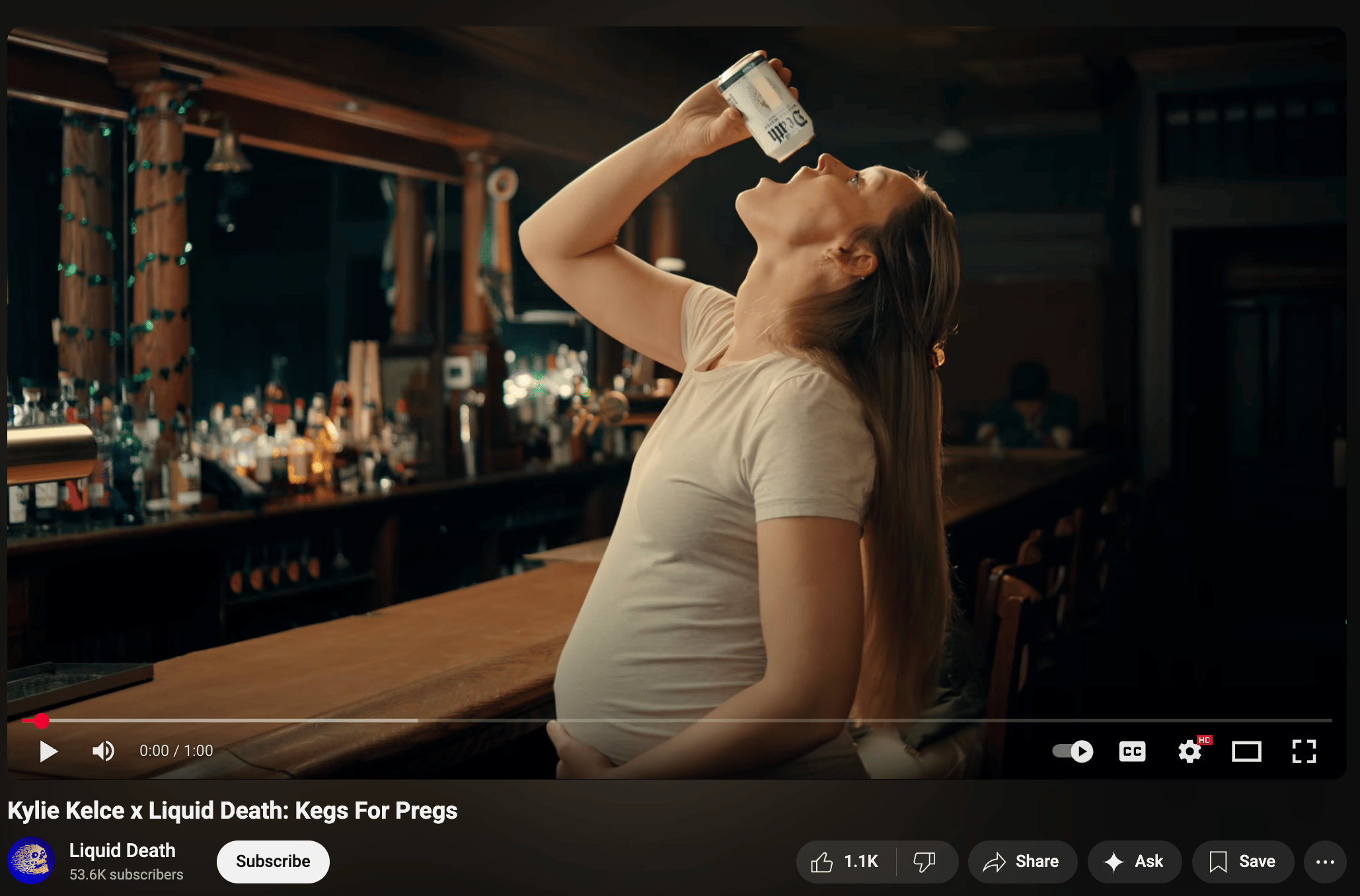
- Ryan Reynolds in Mint Mobile ads: He reads ad copy that obviously knows it’s ad copy, disarming the audience. “The marketing department asked me to be as explicit as possible when explaining it, so here we go. We don’t like f***ing our customers over like Big Wireless.”
Common headline approaches that interrupt:
- Apparent Contradictions: Violate common logic, so people want to “resolve” it and learn the story. You can lean into success via subtraction, chaos, or loss.
- “Double your revenue by deleting half of your website.”
- “Built for speed. But beloved for slowing you down.”
- “Our secret ingredient? The one we took out.”
- Abnormal specificity: Use specific numbers to imply truth and intrigue. Your reader assumes there’s a story behind them.
- “It took 19 tries to make a cookie our grandma wouldn’t hate.”
- “This single line of code saved a client $480,391 in Q3.”
- “Worn for 137 hours straight. Still didn’t smell.”
- Deadpan honesty: Use humor, candor, and mild deprecation to create copy that sounds too human to be another ad.
- “We’re not the cheapest, but probably the least annoying.”
- “Yes, we fix pipeline problems. No, we can’t fix your marriage.”
- “No influencer or unboxing video. Just the thing you want.”
- Reverse logic: Break the established expectations by flipping the benefit with paradox or defiance.
- “The best makeup is less makeup.”
- “Stop chasing sleep. Start chasing calm.”
- “Fewer meetings. More momentum.”
- Curiosity gap: Tease something emotional or dramatic without revealing the “why” just yet.
- “We made this candle as a joke. Now it’s our top-seller.”
- “Try the formula nobody believed would work.”
- "It doesn’t look like much. Until you try it.”
Tips for writing pattern interrupts in ad copy:
- Start with friction. Lead with something that clearly doesn’t belong (a pause, unexpected phrase, strange image).
- Exploit category clichés. Know what your audience has come to expect, and flip it on its head.
- Show/speak to the moment after or the result instead of the setup. Jump-cut storytelling makes the brain want to catch up.
Pattern Interrupts in Cold Outreach
Sending emails to prospects is a numbers game. Knowing that the majority of cold emails, DMs, and other messages get glossed over, pattern interrupts can be a powerful x-factor in achieving a better response rate.
A little humor, self-deprecation, or creativity can go a long way, but make sure you aren’t being annoying or unprofessional just to grab eyeballs.
Let’s look at some various ways to use pattern interrupts in cold email outreach.
Make the subject line your playground
Busy people who get sales emails all the time scan subject lines on autopilot. This is the first (and sometimes the only) part of your email they’ll see. So think about these standout subject lines like “hooks” that can open the door to deeper engagement with your message.
If you’re sending a number of cold emails regularly, this is something you can easily test. If one subject line flopped and yielded no responses, ditch it. If another one fostered responses at a noticeably higher rate, embrace it.
What not to do in a subject line
Make sure your subject lines don’t seem too expected or self-centered. You should also start by piquing the reader’s interest instead of letting your agenda show.
Typical “Dead On Arrival” cold email subject lines:
- Quick question
- Following up on my last email
- Let’s connect!
- Are you the right person to talk to about [X]?
- We help companies like yours do [X]?
- A new partnership opportunity for [Company Name]
The above examples all follow similar patterns: predictable verbs, no context, no curiosity sparked. They show the email is about the sender’s needs, not something that might benefit or interest the recipient.
Strong pattern interrupt subject lines
Below are following themes or routes you can experiment when writing subject lines that stand out. These are best when they’re actually relevant or can be paid off with a real insight or observation. Try not to just bait clicks for clicks’ sake.
Remember to keep this short and punchy, so it can be read at a glance and show up in its entirety in their inbox.
Conversational & Human:
- “This is a weird way to start an email.”
- “Not sure if you’ll hate this idea or love it.”
- “This email is Certified Human-Written™”
Curiosity-Based:
- “You probably won’t agree with me on this. At first.”
- “This trend made me think about your product.”
- “We found something you might want to see.”
Self-Aware:
- “Yes, it’s a cold email. No, I won’t waste our time.”
- “You don’t know me, but I think I know your problem.”
- “Not trying to be clever or cute, just relevant.”
Playful & Unexpected:
- “Please do not open if your funnel is already perfect.”
- “My wife told me not to send this.”
- “Our intern actually had a good idea for your business.”
Inside the email
Once you’ve gotten them to open your cold email via a sneaky good subject line, here’s some general guidance. Keep in mind different things can work for different readers, but following the tips below will likely help you get to solid ground.
This isn’t textbook “pattern interrupt” guidance, but still helpful since we’re here.
- Keep it short and sweet: Don’t hit them with the expected deep dive on your company or a laundry list of bullet points. Make it something they can digest within 10–20 seconds or so.
- Make the first sentence conversational: Instead of diving right into the context, start with something personal and disarming like, “This might be the worst way to start an email, but…”
- Break your content into short blurbs: This tends to make your copy look less daunting or dense.
- End with humor or candor: Saying something like “Even a polite ‘no’ would make my day” is a disarming, charming sign-off.
Get creative with it
Like we mentioned, cold email is a numbers game. Creativity is your friend, because it helps you break out of established patterns, and it gives you immediate feedback on whether your execution worked or not. So feel free to try new formats and swing for the fences, like two of the examples below do.
Nearly ten years ago, I received a textbook “pattern interrupt” email that I still remember (and that I could still locate in my inbox).
The sender name was just “Dad” and the subject line said, “It’s Time To Have ‘The Talk’”. I opened it without missing a beat, thinking my dad had something important or funny to tell me.
Turns out, it was an ad for Chubbies throwback clothes inspired by dad fashion of days gone by. Looking back, it’s funny to think I thought it was actually from my dad, but the subject sounded like him, and he’s just “dad” in my phone (and in my head) so I didn’t think anything of it.

This might be my favorite promotional email I can remember. For one, a “hook” that completely tricked me into clicking on it, and then email content that paid it off in a hilarious, appropriate way.
Subject line: It’s Time To Have “The Talk”
Email opening copy: About my shorts and shirts.
Image: An actual photo of the guy’s dad killin’ it on a boat in a Hawaiian shirt
Products: Inspired by dad fashion from the 80s
Another interesting or off-kilter technique I’ve seen in my inbox (and one that my Demand Curve co-conspirator Kevin DePopas has also deployed before) is what I’m now deeming the “fast follow.”
A few months ago, I received an email from a designer who wanted to connect. After I didn’t respond back, she followed up the next day with a “Sorry I realized I forgot to include the link to my portfolio” email. Which made me click the link, see some work that I liked, and email her back. It worked.
Kevin has tried a similar approach, although he does it quicker than following up the next day. He will follow up 10-15 minutes later with an “Oops, I meant to attach this deck” email, effectively giving him a two-for-one without going down the desperate-sounding “Just following up!” path.
So play with your subject lines, get to the point in an interesting way in your email content, toy with different creative approaches, and double down where you find success.
Email can seem like a rigid “sandbox” to play in, but there’s plenty of opportunity to break the rules and interrupt expectations.
Pattern Interrupts in Content & Hooks
Most strong hooks innately use pattern interruption, because they interrupt the pattern of scrolling and scrolling. We all know you just have a couple seconds to prove why your video is worth someone’s time, and it can’t sound totally expected or unremarkable.
For example, if you’re in B2B or SaaS, your audience isn’t going to stop dead in their tracks for another “5 Tips for Better Conversions” post. Instead, they need something that makes them feel like they’re missing out if they don’t pay attention.
In that spirit, let’s look at hooks and content angles that give people a reason to stop and lean in.
Types of hooks that interrupt:
- Contrary-to-belief: Flip what people think they know by challenging a rule, norm, or best practice.
- “Most onboarding flows fail because they convert too many users.”
- “Why did our ‘ugly’ landing page outperform the polished one?”
- “Here’s how fewer SKUs made our customers actually spend more.”
- Confession-based: Disarm with humility or vulnerability, often with a tough lesson or admission of a mistake.
- “We wasted $40K on a feature nobody ended up wanting.”
- “I used to embellish our growth charts in pitch decks.”
- “Our most ‘viral’ post was actually a complete accident.”
- Mini-drama: Tell a story briefly that implies tension or high stakes.
- “We spent months building a feature, then our competitor launched it first.”
- “The investor call started great. Then I opened the wrong slide.”
- “We finally hit our dream KPI. But we hated what it did to our team.”
- Contrarian success: Showcase a win that shouldn’t have worked, forcing others to question their playbook.
- “The feature we almost deleted became our top growth driver.”
- “We ignored typical SEO for a year. And our organic traffic doubled.”
- “Our best-performing video ad didn’t even show our product once.”
- Anti-hype: Question or throw shade at over-hyped trends, tools, or buzzwords.
- “AI didn’t 10x our productivity. It only made meetings longer.”
- “Our ‘growth hack’ was just answering DMs thoughtfully.”
- “Our viral moment didn’t make money, just more headaches.”
- Visual gags: These are pattern interrupts that rely heavily on visuals before voices. There are infinite artful approaches to this, but see a couple good examples below.
- This example from legendary creative Jason Bagley (responsible for iconic campaigns for Old Spice, KFC, Nike, etc.) where he used a banana taped to a spatula as his microphone
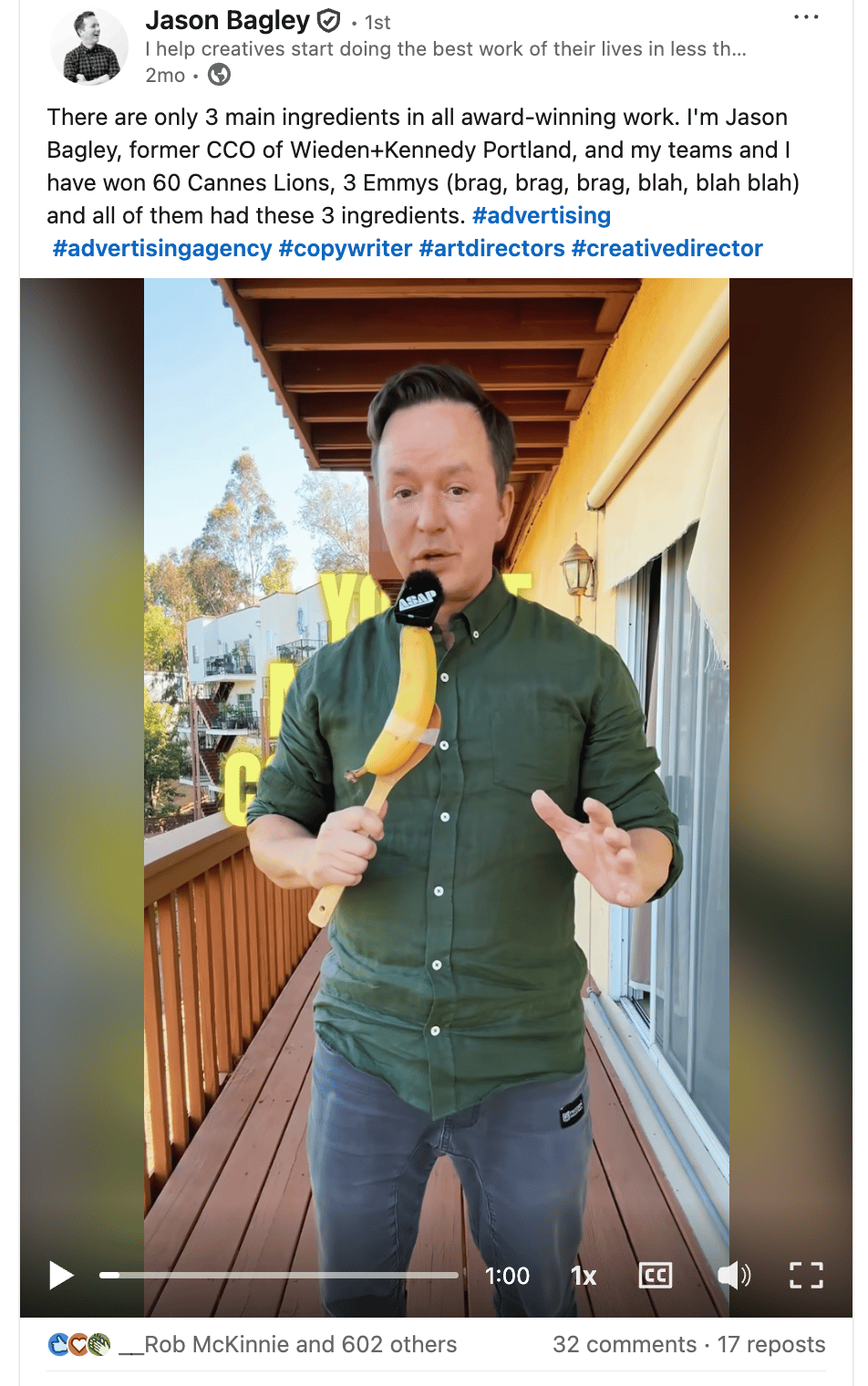
- Here’s another example from Joey Noble on the Demand Curve team who made a great video about several types of visual hooks. This one starts with his hand slapping a Post-It note in front of the camera with a message on it.

- Creator Smac McCreanor often does highly visual and artistic impressions, including her imitations of things being squeezed in hydraulic presses, shown beside the original video. Not highly business related, but extremely entertaining and hard to look away from.

Principles for hooks that interrupt:
- Lead with tension. Give readers an open loop they need to watch in order to close.
- Dial up the contrast. Pit what people expect against what really happened.
- Experiment with motion. Make the beginning of your video visually interesting and alive.
- Make stakes obvious. The bigger the screw-up or the win, the stronger the interrupt.
- Prioritize your time writing the upfront. It’s the entire battle. Front load your most important information to fight drop-off.
Closing Thoughts
In the wonderful documentary about the electric guitar, It Might Get Loud, Jack White describes his approach to the guitar as “an attack.” And if you’re familiar with his music, you can hear it in the way he plays. It’s often a fight against sounding normal or pretty or expected.
Embracing the power of the pattern interrupt in your messaging follows a similar ethos. You want to fight against those smooth, polished, predictable patterns your audience’s brain has learned to tune out, like elevator music or 80s pop cheese playing over the speakers at the grocery store.
Just like Jack White bending a note until it’s out of key or de-tuning a string mid-song, your job is to introduce a little friction. So try to play a note that doesn’t quite belong, but makes the whole thing feel alive and undeniably different.
Gil Templeton
Demand Curve Staff Writer

Influencer Marketing Basics for the Traction Stage
Insight from Gil Templeton — Demand Curve Staff Writer
When done right, influencer marketing gives startups a scalable, budget-friendly way to grow their audience and credibility. It can put your product in front of the right audiences, and it can also be an efficient way to produce content (which can be draining when done in-house or through production houses).
A lot of founders and marketers might start by thinking, “How do I get creators to post about my product?”
But the better question to ask is: “How do I find creators whose audiences genuinely need what I’m building?”
This shift can change a lot about your approach, from who you target to how you measure success.
Influencers who have a loyal, engaged following can help businesses grow their awareness, sure. But their superpower is their ability to build trust. When an influencer has earned credibility with their audience, that equity is marketing gold.
Reasons to Consider Influencer Marketing
- Conversion: Create an affiliate engine by arming a community of influencers with performance-based compensation.
- Grow organic social following: Some influencers’ followers will likely follow your company account. You can then reach them “for free” with organic posts.
- Social proof: Influencers’ audiences see your collaboration as a stamp of approval for your brand.
- Get content: Influencers can serve as a content-creation arm. And you can use that content for your own ads, organic posts, landing pages, etc. depending on how your agreement is structured.
Goals of Influencer Marketing
In order to guide your approach to influencer marketing, ask yourself what you ultimately want to get from your campaigns. This can be broken into four general goals, outlined below with examples for each:
- Are you looking for a high return on ad spend (ROAS)?
- HVMN works with fitness and nutrition influencers on YouTube to reach audiences who regularly purchase supplements, with the goal of increasing ROAS, shown here featuring their Ketone-IQ product.
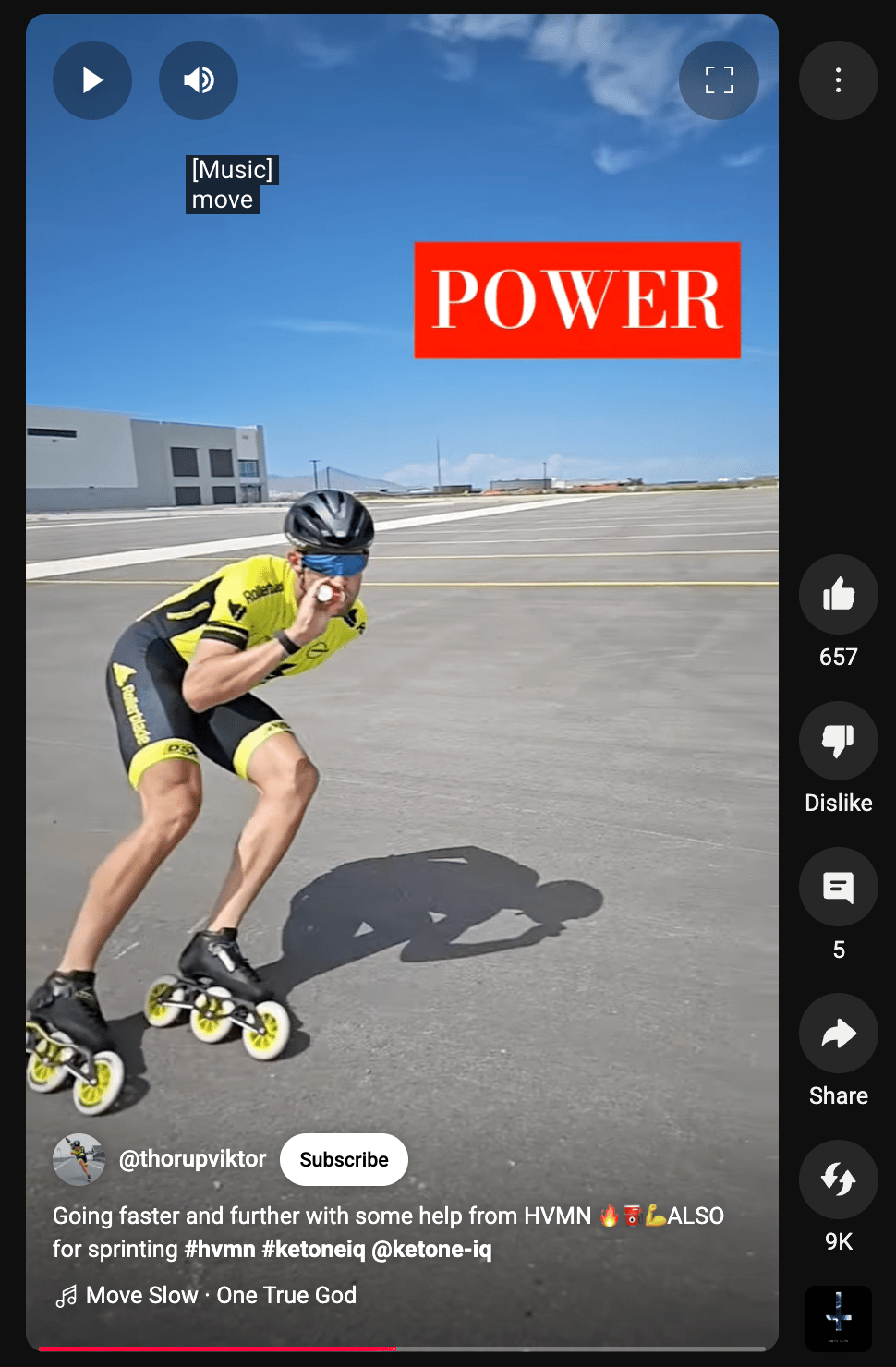
- Are you building a community?
- Athletic Brewing, a non-alcoholic beer company, works with sports and outdoor influencers whose Instagram audiences are often looking for healthy alternatives to alcoholic beer. They focus on building community and brand awareness.
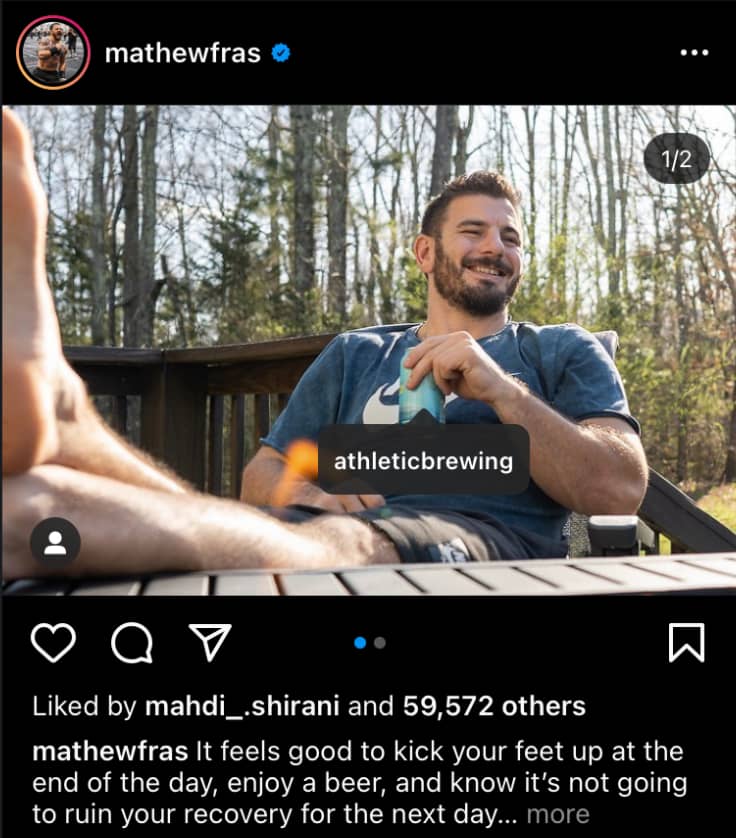
- Are you prioritizing impressions and awareness?
- Snowflake collaborates with industry experts and data analysts for The Data Cloud Podcast, which is produced by Snowflake. These cross-pollinated partnerships focus on thought leadership and brand authority in the enterprise data space.

- Do you need help with the production of quality content?
- Mutiny has partnered with marketing influencers on LinkedIn who share challenges and wins in ABM marketing. The campaigns are designed to convert awareness into trials and product adoption (direct ROAS and pipeline impact).
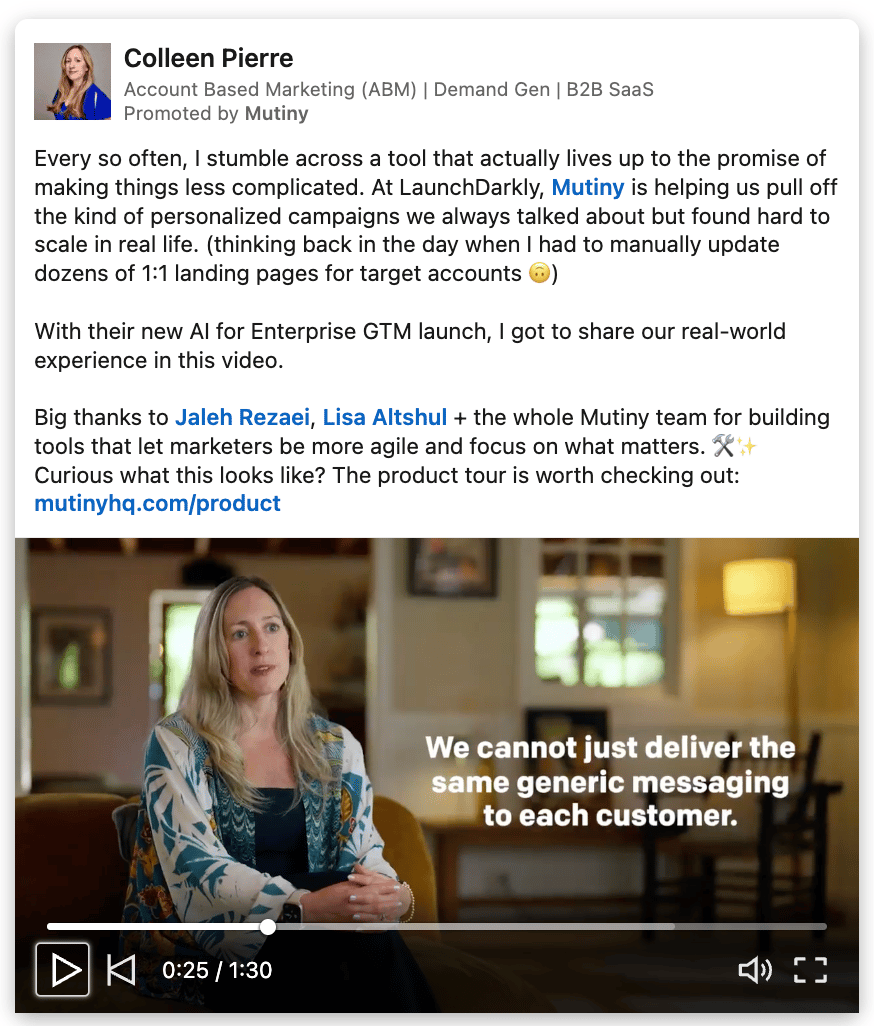
Why Creator Partnerships Can Work for Early-Stage Businesses
Earns trust at massive scale: Instead of spending months building brand credibility from scratch, you borrow trust from creators your target users already follow and respect. When someone with an engaged following recommends your product, you become a beneficiary of their accumulated social capital.
Acts as a two-for-one growth channel: It’s simultaneously a short-term growth lever (direct distribution to engaged audiences) and a long-term brand asset (awareness, social proof, and market positioning). Strong creator partnerships can build both immediate conversions and lasting brand equity.
Enables rapid narrative testing: You can test different messages, hooks, and positioning through creators’ authentic voices, often learning more in a week than months of A/B testing your own content.
Provides high-signal qualitative feedback: Unlike paid ads that optimize for clicks, influencer partnerships generate rich qualitative insights through comments, DMs, and authentic reactions that can inform your entire marketing strategy.
Creates content at scale: Collaborations can generate quality content you can repurpose across your own channels, which can multiply your content output compared to standard approaches.
The Human Element of Influencer Marketing
This channel is fundamentally different from most other growth channels, because you’re working with real people, not just trying to appease algorithms (although that helps, of course). This changes so much about the mindset you should approach it with.
This Is Hands-On
Unlike Meta Ads or Google Ads that you can largely automate once optimized, influencer marketing requires ongoing relationship management. This is not a mere “set it and forget it” play.
Practical implications:
- You’ll spend time getting to know creators personally
- Your response time matters. Creators value quick, thoughtful communication.
- You need to stay engaged throughout the collaboration, not just at the beginning.
- Know that every partnership is unique and requires different approaches
The upside: This hands-on nature creates defensible relationships that competitors can’t always replicate. Once you build genuine, strong connections with creators, they can become long-term partners and brand advocates.
You’re Nurturing Relationships, Not Executing Transactions
The most successful influencer programs treat creators as collaborators and brand partners, not advertising inventory. This mindset shift changes how you approach everything from initial outreach to ongoing partnerships.
Transactional thinking (avoid this):
- “How cheaply can I get this creator to post about us?”
- “Can we get them to post exactly what we want them to say?”
- “What’s the immediate ROI on this one post?”
Relationship thinking (do this):
- “How can we provide value to this creator and their audience?”
- “What would make this creator genuinely excited to work with us long-term?”
- “How can we help this creator create their best content while naturally showcasing our product?”
Practical implications:
- Spend time watching their content and familiarizing yourself with it
- Send thoughtful intro messages that show you’ve “done your homework”
- You can send products for creators to try before asking for anything
- Bring them into the fold early in strategy sessions if they’d like
- Share their content and engage with their posts regularly
- Introduce them to other creators in your network
- Consider providing exclusive access to new features or behind-the-scenes content
- Celebrate their successes publicly
Don’t Confuse Impressions With Influence
A creator with 10,000 highly engaged and trusting followers will likely drive better results than a celebrity with 100,000 passive followers. Focus on the influence (the ability to drive action) rather than mere reach or vanity metrics like follower count.
Some hallmarks of real influence:
- High-quality comments that show genuine engagement
- Followers who ask questions and seek advice
- Strong conversion rates on previous sponsored content
- Active community discussions around their posts
- Followers who describe the creator as trustworthy or inspiring
Here are a few examples of comments sections (for creators ChiefGetItDoneOfficer and Joseph Abell) that suggest strong engagement at a perfunctory glance.
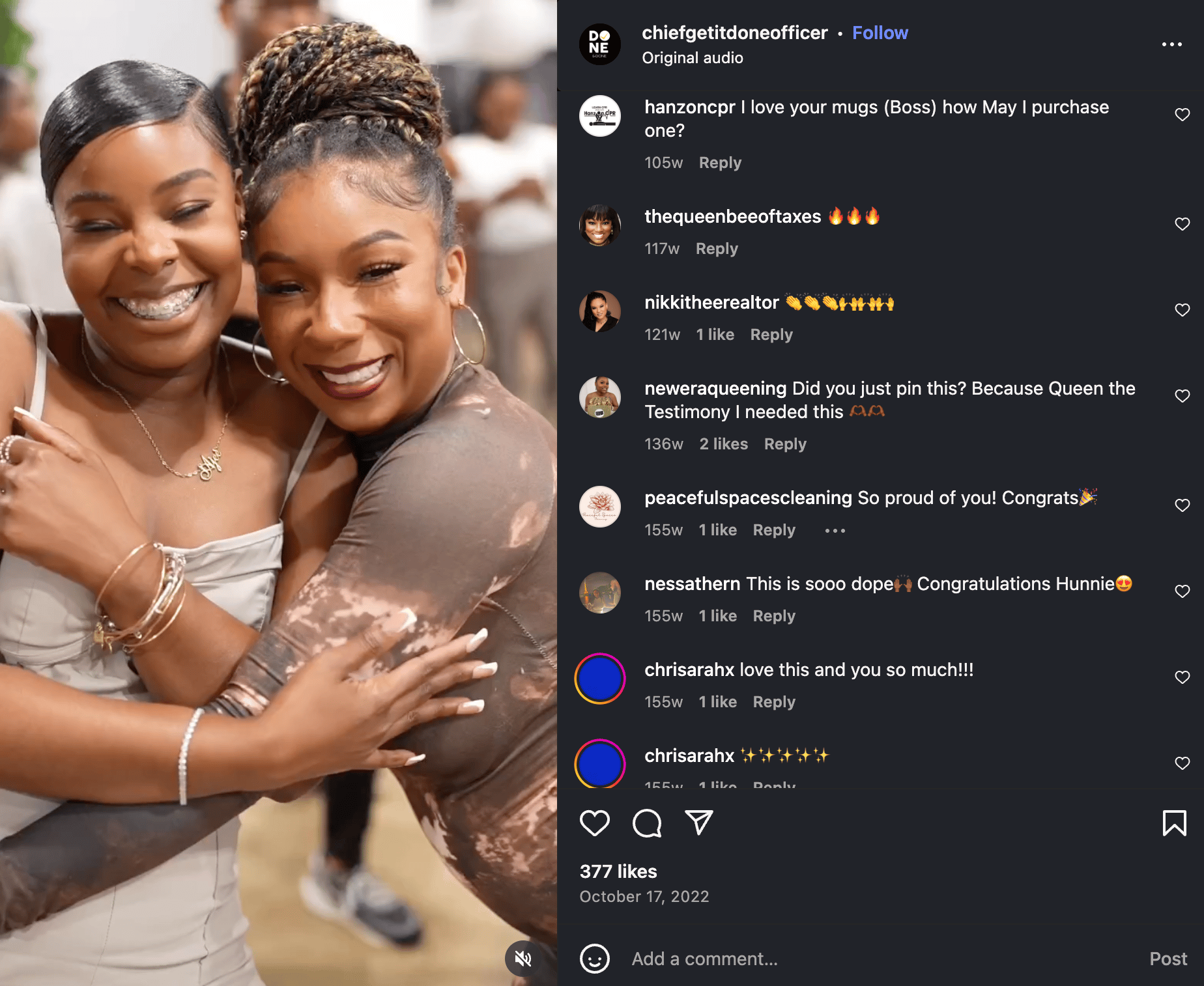
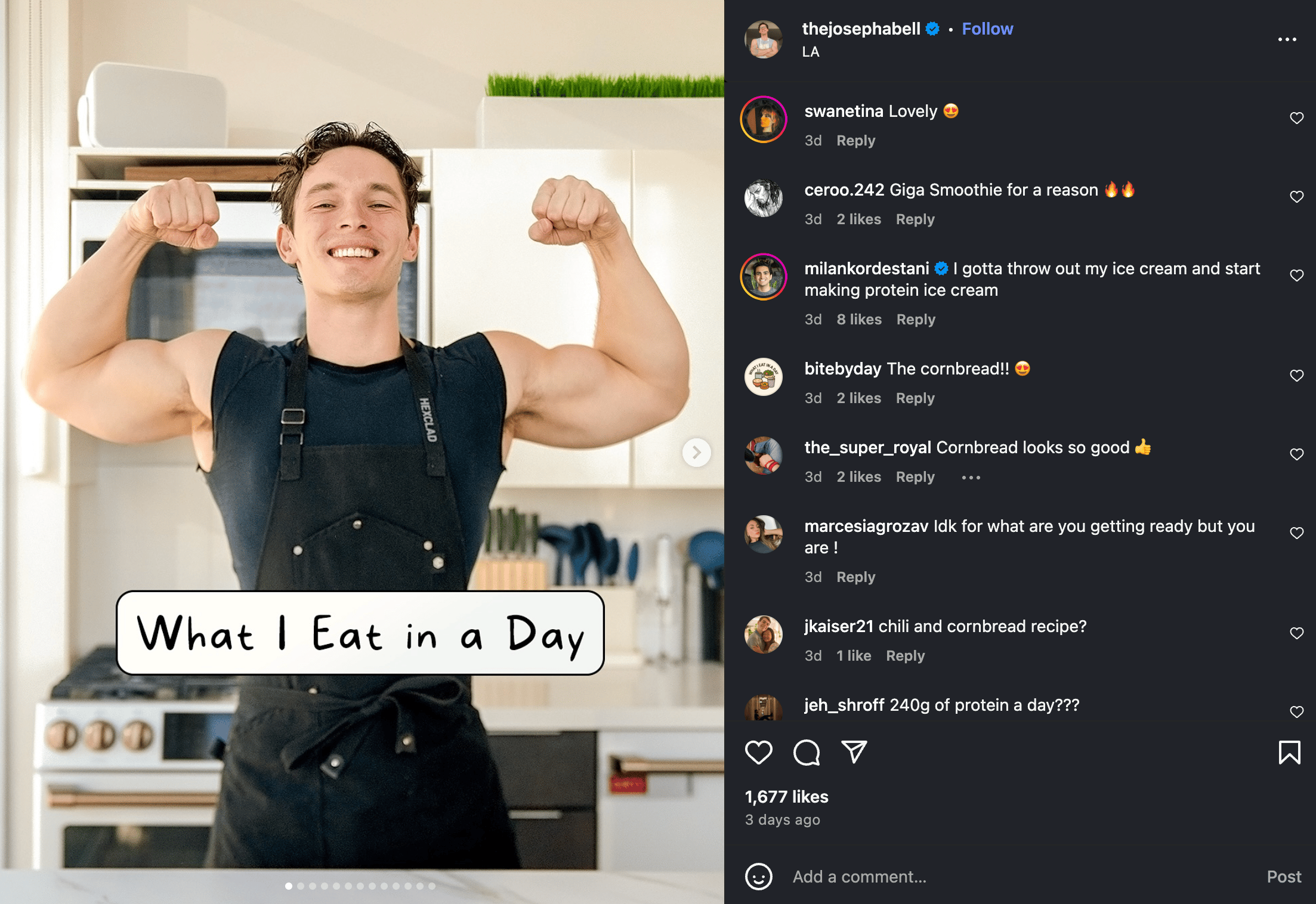
The Psychology of Influence: Three Types of Capital
To work effectively with creators, you need to understand the psychological drivers that motivate both creators and their audiences to share content. Think about it as three types of "capital" that people gain or lose through their sharing behavior: financial, social, and personal.
Financial Capital: Economic Incentives
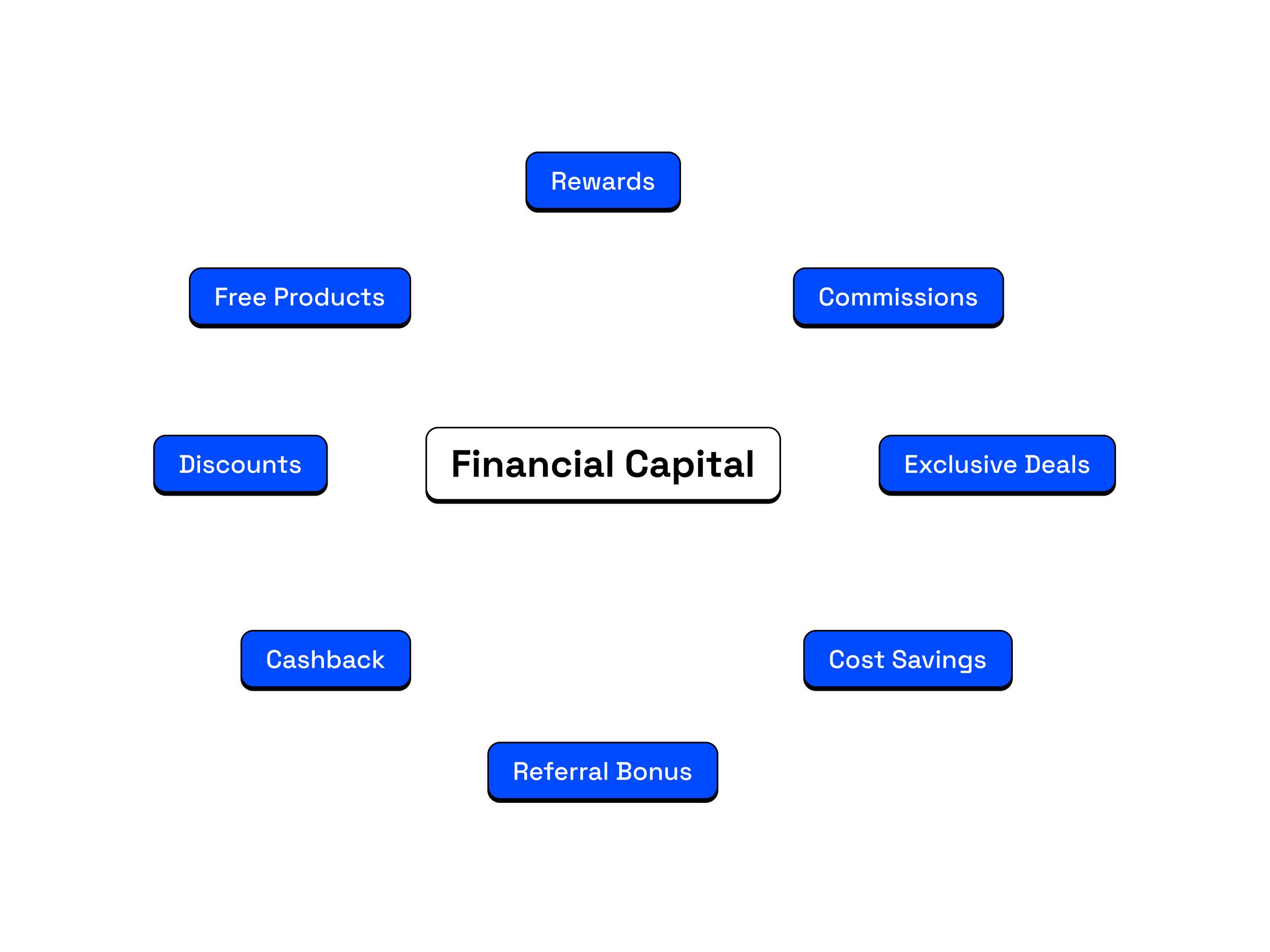
What it is: Financial capital refers to direct economic value (money, free products, discounts, or anything that improves someone’s financial position). Here, people share when they can gain something financially or help others do the same.
This is the most straightforward and old-school motivation: people are more likely to share content when there’s a clear economic benefit involved.
Examples:
- Uber: Creators share promo codes where new users get discounts on their first rides, while the creator earns ride credits or cash bonuses.
- HubSpot Affiliate Program: Creators, consultants, and trainers earn recurring commissions when their audiences adopt HubSpot, while those audiences often get extended trial offers or discounted onboarding.
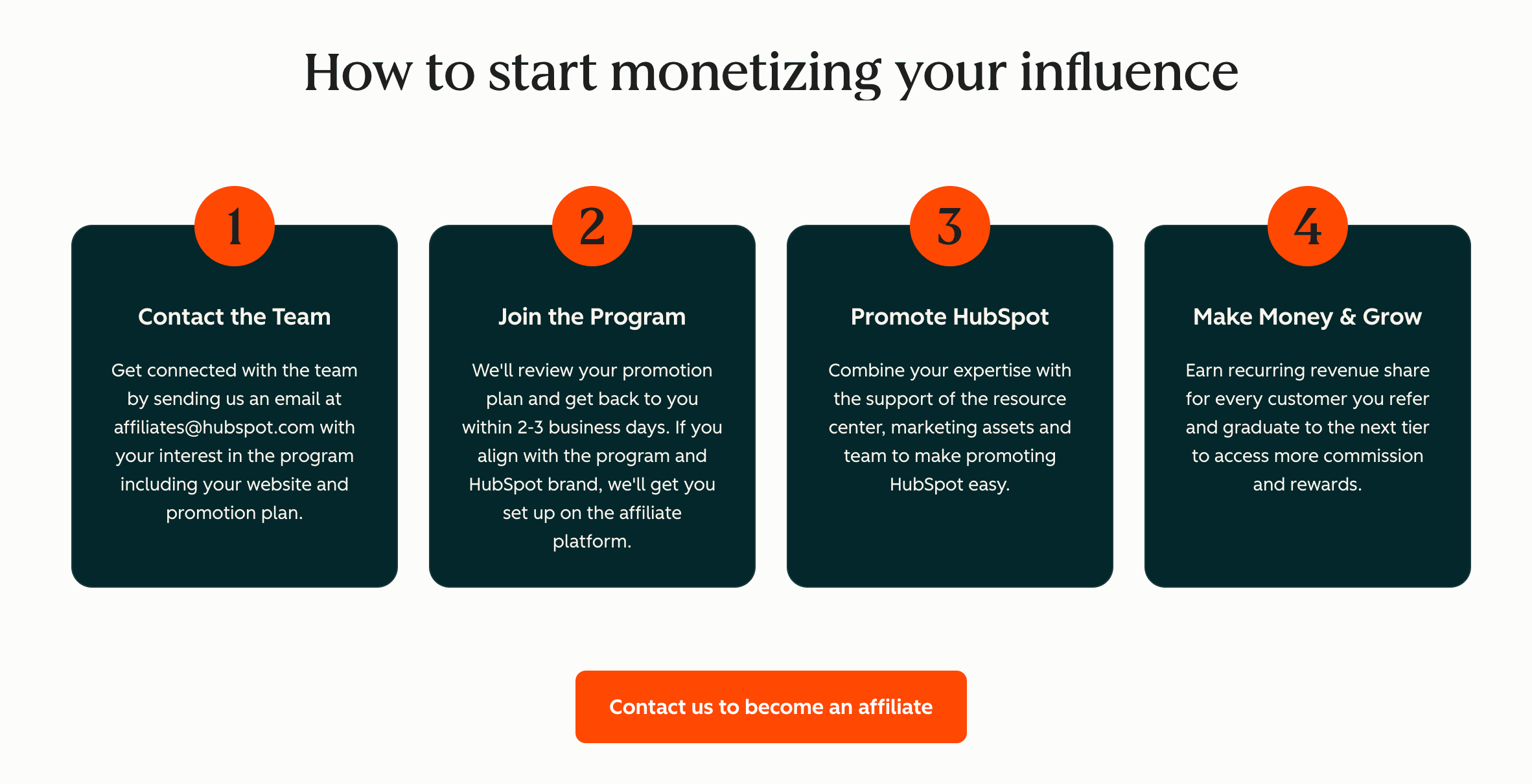
- LinkedIn Learning Instructors: Subject matter experts (SMEs) share courses that drive revenue through royalty payments, while their audiences gain access to discounted learning paths and certifications that boost career outcomes.
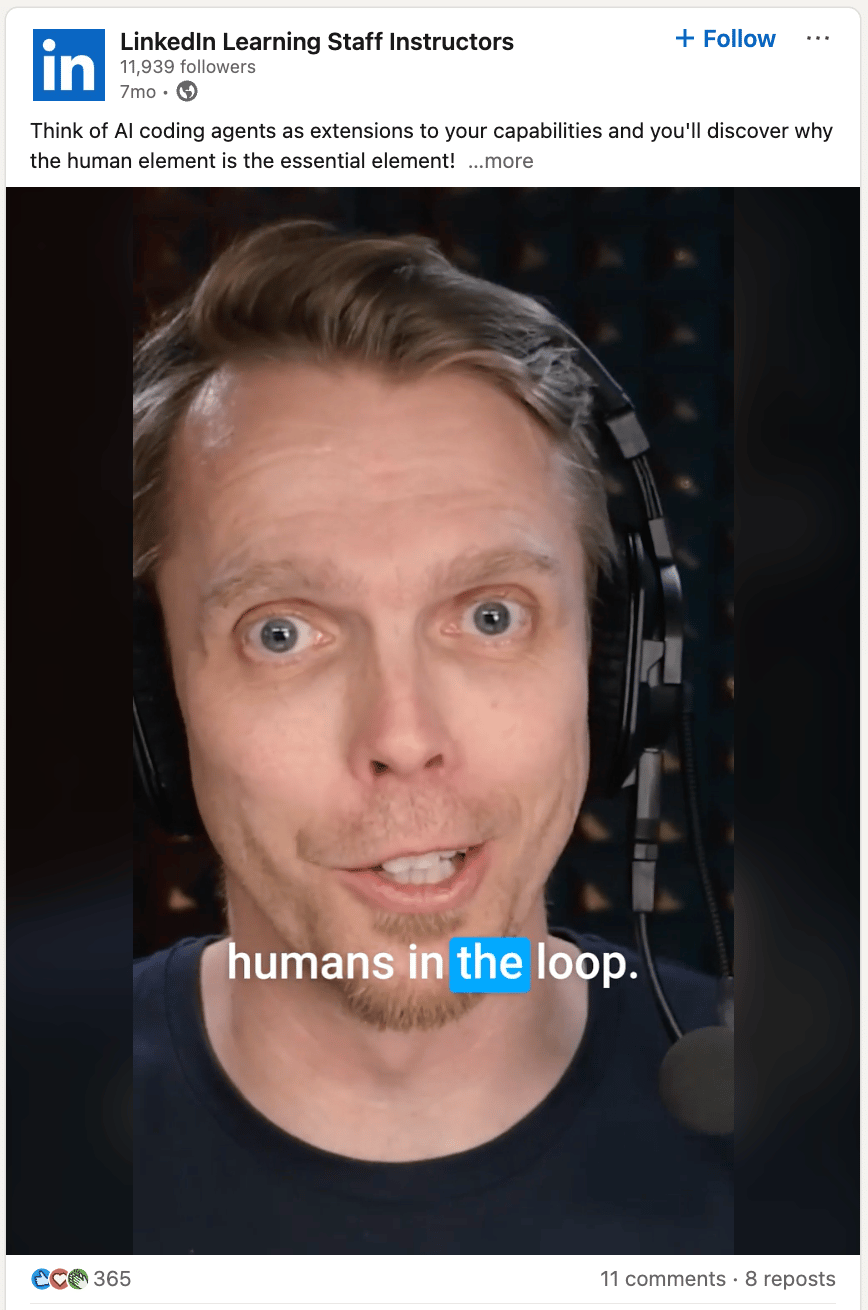
For creators: This leads to payoffs like direct monetary compensation, affiliate commissions, free products with real value, and discounts.
For audiences: They stand to gain discount codes, cash back opportunities, free trials, exclusive deals, and referral bonuses.
How to leverage this:
- Offer creators competitive affiliate rates (often 15-30% for digital products, 10-20% for physical products)
- Provide audience-exclusive discount codes that make sharing feel valuable
- Create referral programs that reward both the creator and audience
- Give creators early access to sales or limited releases
- Ensure your offer has clear monetary value that’s easy to communicate quickly
Social Capital: Status and Perception
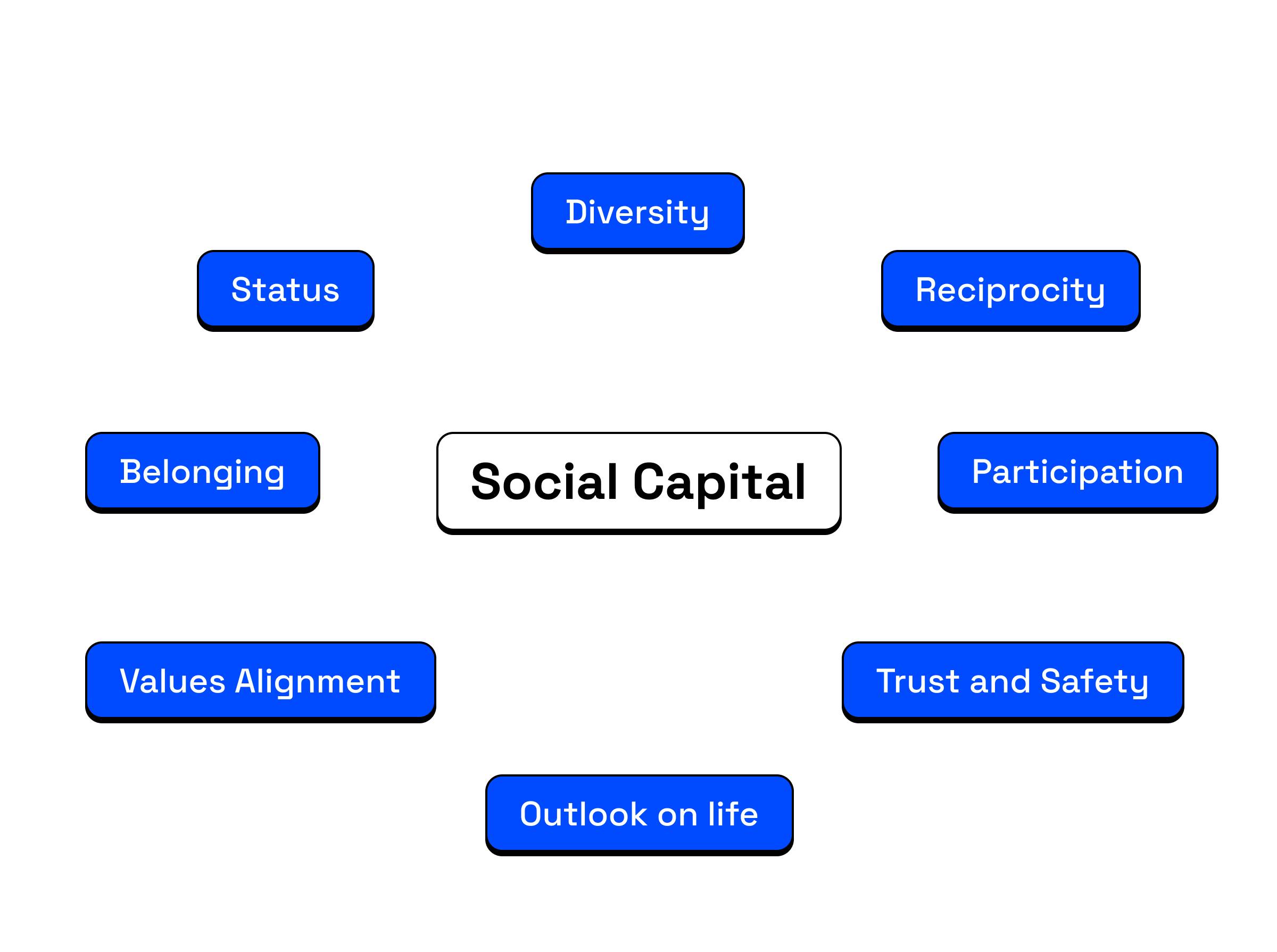
What it is: Social capital is about how sharing content affects your reputation, status, or how others perceive you. People share content that makes them look good, smart, helpful, or ahead of the curve, while they avoid sharing things that might make them seem forced or out of touch.
This capital is about social positioning; When someone shares your product, they’re essentially putting their reputation behind it. They’re telling their audience “this is worth your attention” and staking their credibility on that recommendation.
Real examples:
- Notion (Productivity App): Productivity creators share Notion templates and workflows because it positions them as organized, efficient experts. Being early to showcase advanced Notion setups make creators appear ahead of the productivity curve.
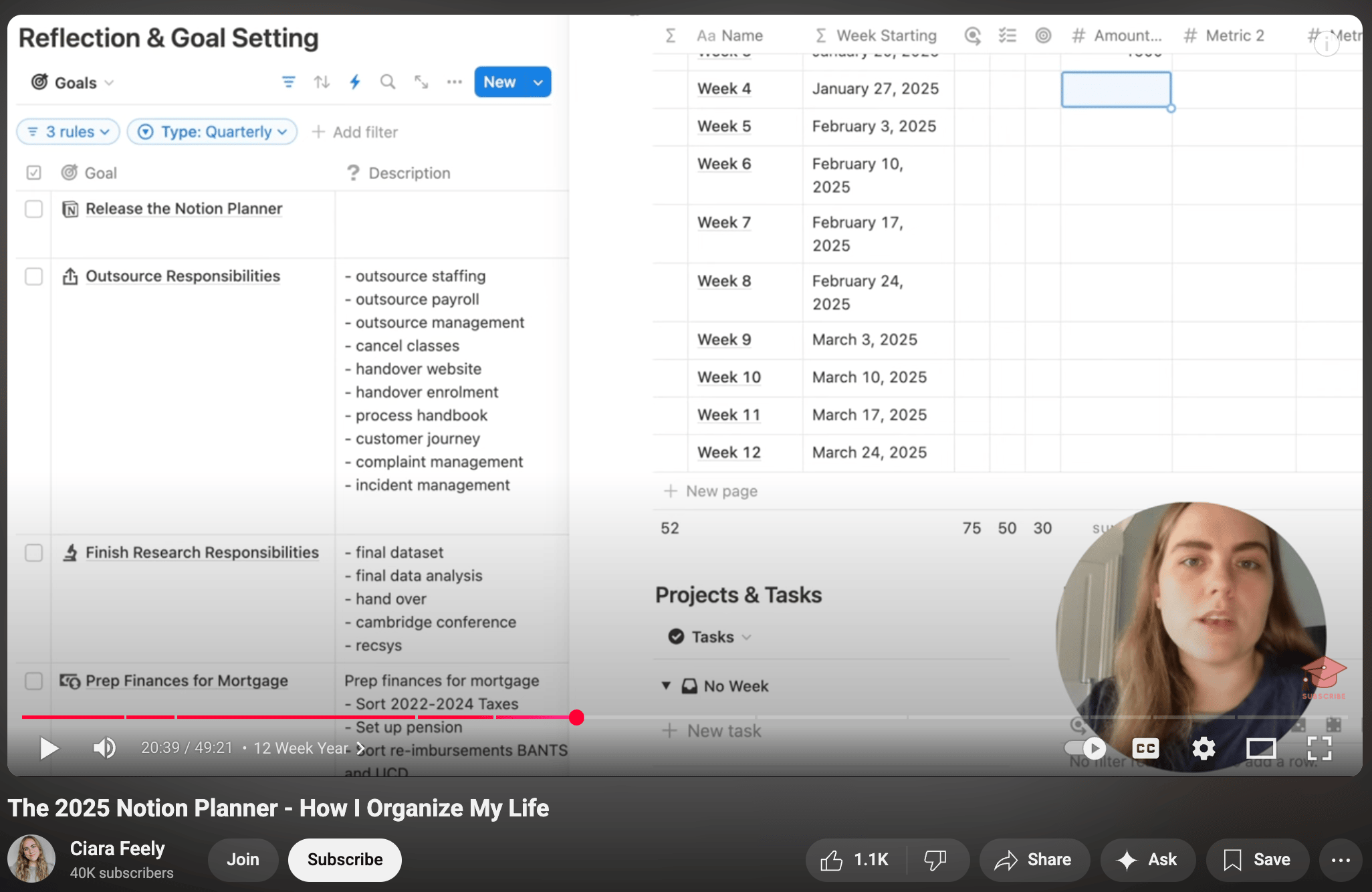
- Tesla (Electric Vehicles): Early Tesla owners and tech reviewers shared their experiences, because it positioned them as forward-thinking, environmentally conscious, and early adopters of innovative technology.
- FX Replay (Backtesting for Day Traders): We covered this story in our Growth Newsletter #272. A key piece of FX Replay’s growth was their choice to give free platform access to influential creators in the trading space, no strings attached. Creators naturally chose to share their experiences with their followers, simply because they found so much value in it and figured their communities would as well.
For creators: This can signal their association with innovative brands, being the first to discover useful products, appearing helpful to their community, and demonstrating expertise.
For audiences: They get to make new discoveries, solve problems, and stay on top of trends.
How to leverage this:
- Position your product as exclusive or cutting-edge rather than mainstream
- Share behind-the-scenes development stories and lessons that creators can pass along
- Create “insider access” opportunities that creators can share with their community
- Develop educational content that’s shareable and social-friendly to make it easy for creators to repost or share
- Emphasize what makes your product innovative or different from existing solutions
- Provide creators with interesting proprietary data or insights they can share
Personal Capital: Self-expression and Utility
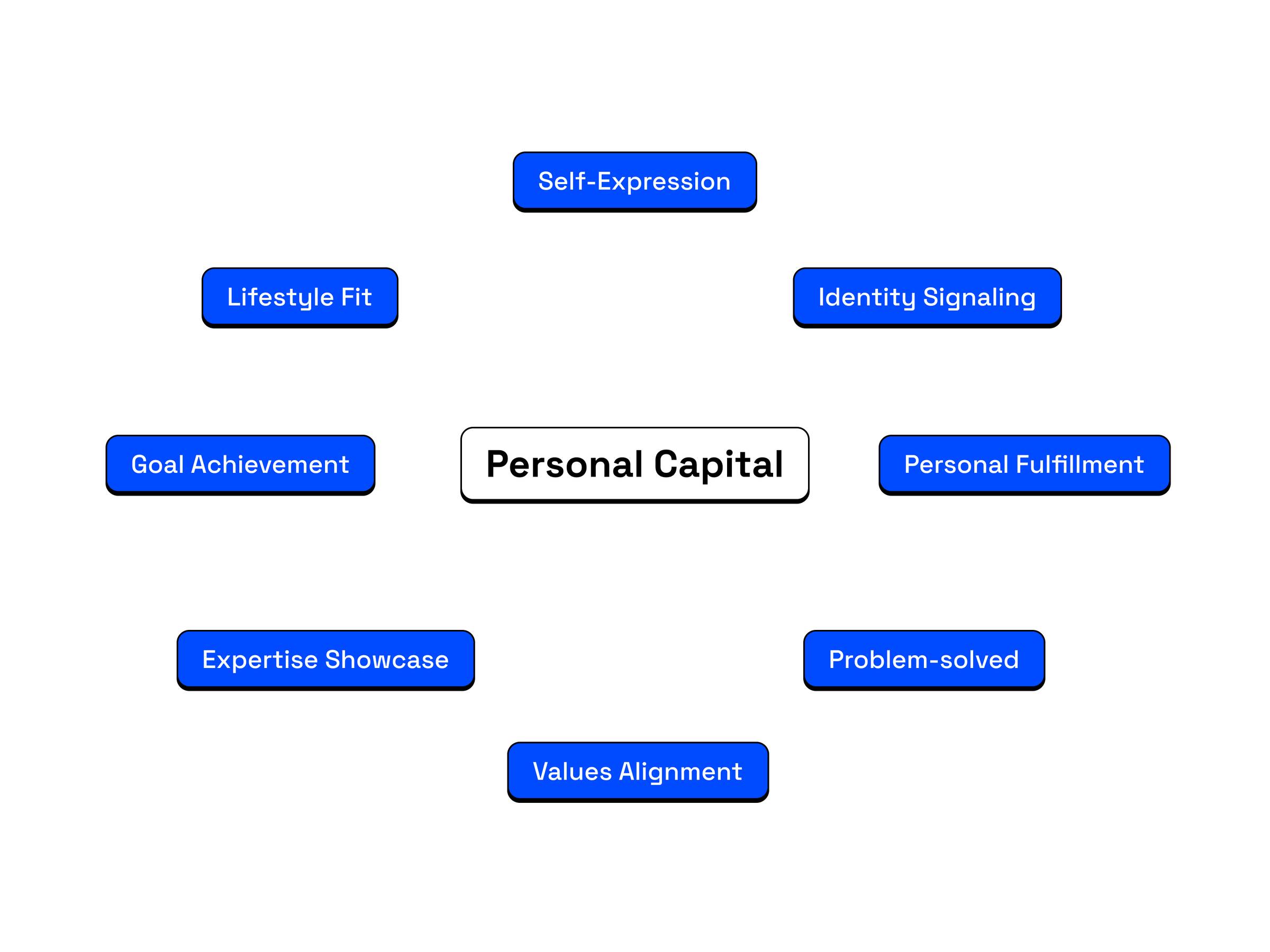
What it is: Personal capital is about self-expression and personal fulfillment. People share content that reflects who they are, what they believe in, or what helps them solve real problems they have. This can be the most authentic form of sharing because it comes from a genuine personal connection to the product or message.
When someone shares based on personal capital, they’re saying “this is part of who I am” or “this genuinely helped me.” This type of sharing often converts best because it feels like an authentic endorsement to audiences.
Real examples:
- Spotify (Music Streaming): Music lovers share their Spotify Wrapped and playlists because music taste is so core to personal identity. Creators share favorite songs and discoveries as a way of expressing their personality and connecting with like-minded audiences.
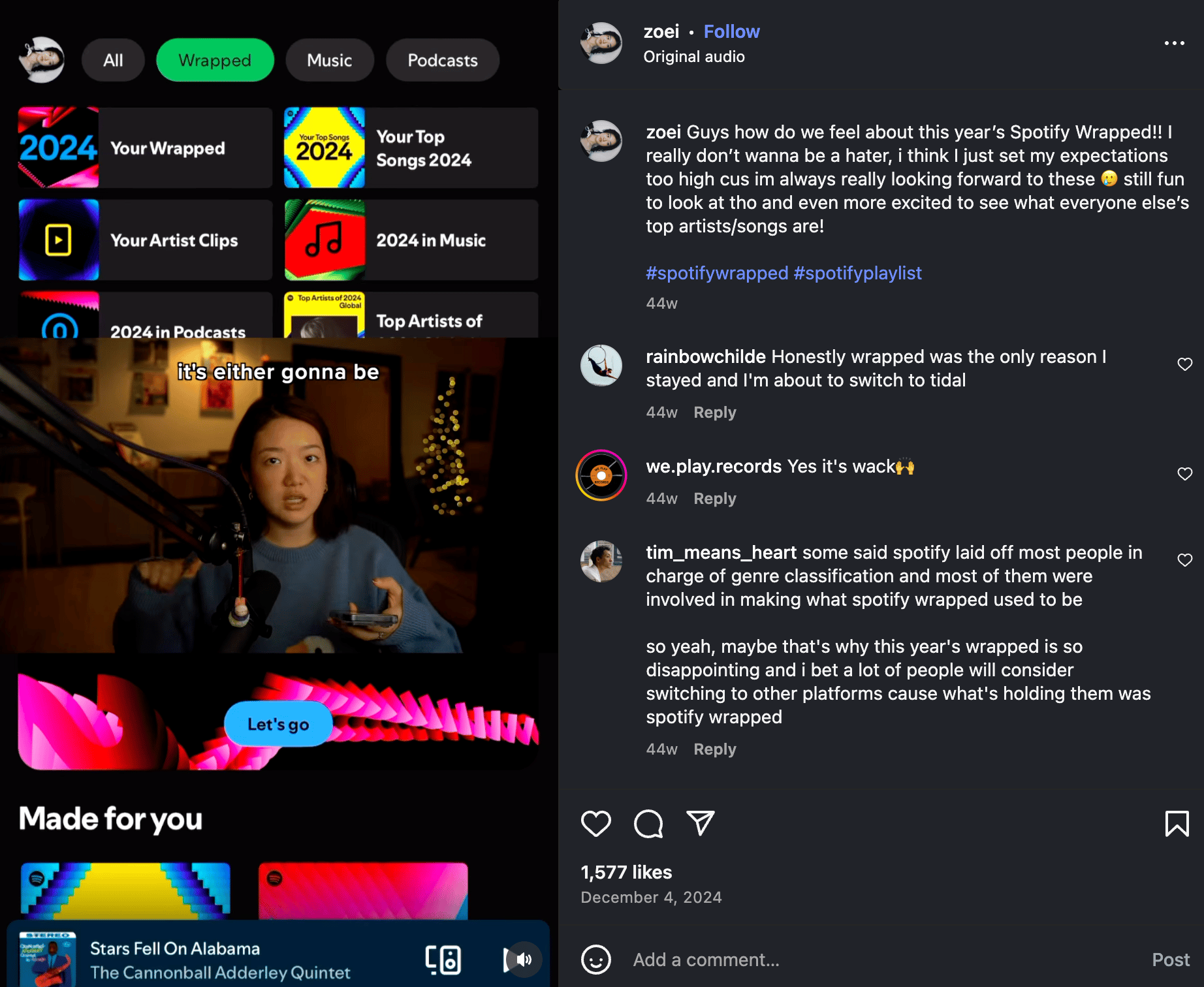
- Canva for Teams (Enterprise Design): Marketers share templates or brand kits built in Canva, highlighting both their creative expertise and ability to scale consistent branding across teams.
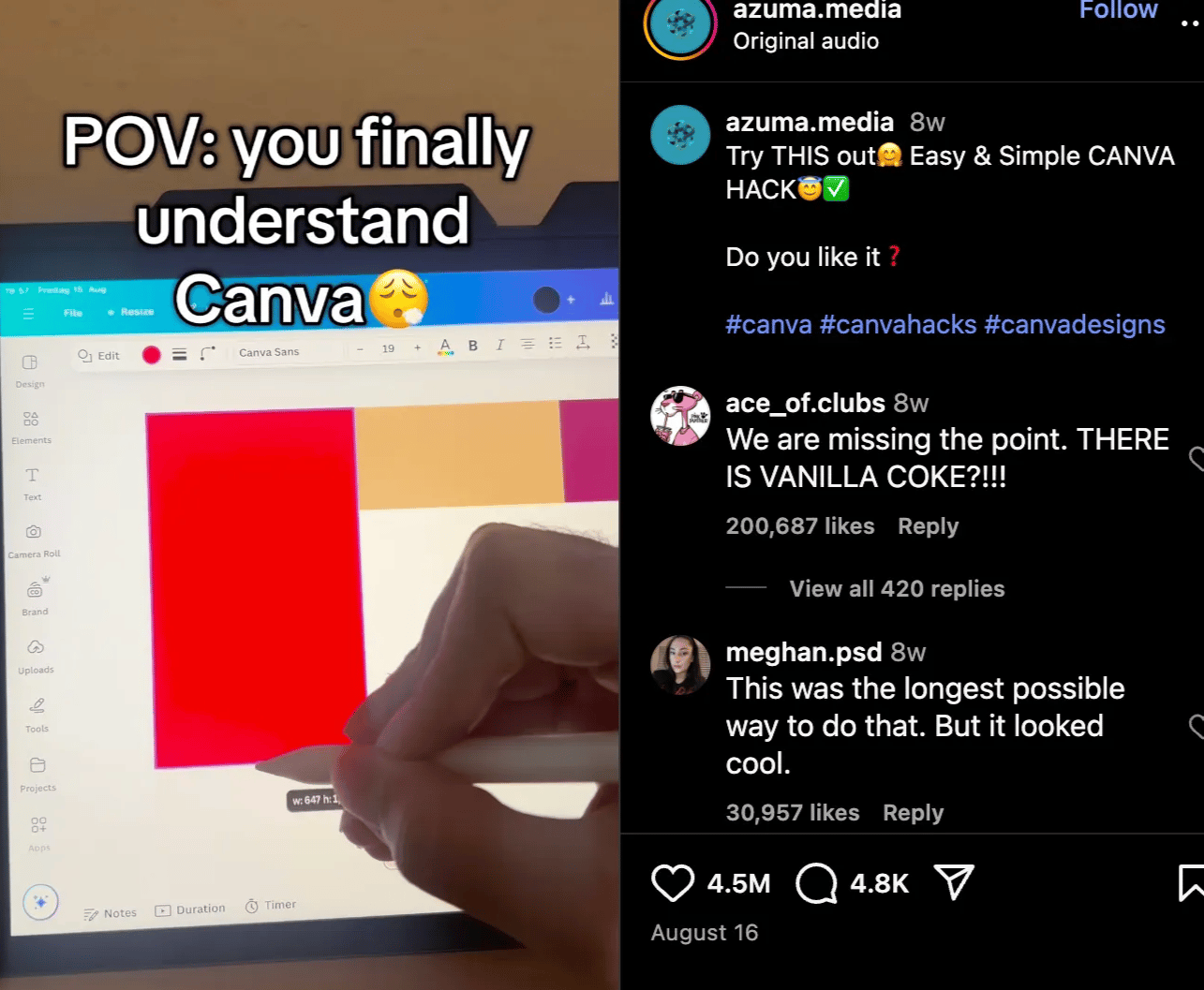
For creators: They authentically express their values, solve genuine problems they face, and create content reflective of their expertise and interests.
For audiences: They get to express themselves through product choices, solve personal problems, and align personal values with their identity.
How to leverage this:
- Ensure your product genuinely solves problems your creators might face in their daily lives
- Allow creators to customize how they present your product to match their personal style
- Align with creators whose values and interests naturally match your brand
- Focus on products that help people express their identity or achieve personal goals
- Share user stories that creators can relate to on a personal level
- Emphasize the transformational aspects of your product
The Measuring Stick: The most effective creator partnerships tap into at least two of these above motivations simultaneously. By giving creators a way to make money, raise their status, and/or express themselves, you give creators natural incentives to contribute to your efforts.
The Takeaway
If anything, this high-level overview of influencer marketing shows you why this growth lever is a unique beast. Creators and influencers have to constantly protect and nurture their personal brands, which makes this a two-way street.
So think about it like this:
The less naturally interesting your product is to a creator’s audience, the more you’ll probably have to pay them to talk about it. But if your product can deliver value by entertaining, educating, furthering self-expression, and/or solving a real problem the audience has, a creator will likely charge less because the message feels in line with their valuable personal brand.
If a creator can signal-boost your business in an interesting way to the right audience for a relatively low cost, that’s precisely where influencer marketing helps you win an unfair share of attention. When done right, it can be the secret sauce of your social efforts.
But if you’re trying to shoehorn product RTBs into rigid briefs for creators with uninterested audiences, you’re probably just going to end up paying to run another ad. Because at that point, it’s not really creator content. It's another line item in your media budget.
Gil Templeton
Demand Curve Staff Writer
Influencer Marketing Basics for the Traction Stage
Insight from Gil Templeton — Demand Curve Staff Writer

Four Forces Behind a Strong Brand Identity
Insight from Gil Templeton — Demand Curve Staff Writer
Before we get into the nitty-gritty, let’s talk about why brand building is so much easier said than done. And why everyone can point at the greats and say “Yeah, just do that!” But very few can actually do it when push comes to shove.
It starts with nailing your product, of course. Then it’s about making sure your mission statement, story, voice, and design are all rowing together to build confidence in consumers’ minds. More on those in a bit.
“The personality of a product [or brand] is an amalgam of many things — its name, its packaging, its price, the style of its advertising, and above all, the nature of the product itself.” — David Ogilvy, Iconic Ad Man
While the essence of this quote is accurate, David Ogilvy was living in far simpler times back in the 60s and 70s.
He’d surely short-circuit if he saw brand teams A/B testing TikTok hooks for three-second attention spans or if he saw a growth team debating whether their mascot needed its own LinkedIn profile. But these reflect the everyday questions asked of modern brands.
The hard part is continually ushering your brand through a thousand different needs and asks, protecting its integrity and even sharpening its essence along the way.
The best way to stay the course through these constant challenges and questions is by aligning on a few rock-solid cornerstones of your brand identity.
Let’s talk about building that solid foundation (that will still need plenty of protecting and shepherding along the way).
1. Mission Statement
This is your North Star. It’s a short description (one bold and audacious sentence, often starting with the word “to”) that lays out your big-picture, perfect-world goal. It can serve both an internal and external purpose.
- Internally, it guides strategic decisions about your product, business model, ideal audience, and acquisition channels, and even the people you hire or partner with.
- Externally, it communicates what your company cares about, in order to better relate to customers. (But it’s not mandatory to make it public-facing).
Below are a few examples of well-known companies’ missions:
- Slack: To make work life simpler, more pleasant, and more productive.
- Tesla: To accelerate the world’s transition to sustainable energy.
- OpenAI: To ensure that artificial general intelligence benefits all of humanity.
- Stripe: To increase the GDP of the internet.
- Shopify: To make commerce better for everyone.
Notice how these are massive, daring missions, evocative of a BHAG (or a Big Hairy Audacious Goal). Slack doesn’t talk about making the best work messaging app. Nor does Tesla say a word about cars.
This is because your mission statement should be an incredibly high-level statement, no need to stoop down to the mere products or services you offer.
The bigger and less attainable it seems, the better.
💡 Exercise: Use this prompt to craft your mission statement:
- If we completely succeed at what we’re building, how will the world (or our industry) look different because of it?
2. Brand Story
Think of your brand story as a more detailed expansion of your mission statement. It’s a narrative about how your company came to be and why it does what it does.
The most effective brand stories stir emotion. As humans, we’re drawn to stories because they engage and inspire us. They help us process information in a much more memorable way than simply reading a list of statistics.
Remember, without tension or conflict, there is no story. So make sure this “enemy” or problem is turned up in the mix.
There tend to be two common approaches for framing a brand story:
- Origin: This approach focuses on how a company came to be and the people behind it. It’s best for those with interesting or unusual backgrounds. For instance, a broke dumpster diver named Sophia Amoruso opened an eBay store for her vintage finds, which eventually became the Nasty Gal fashion brand.
- Consumer-focused: This approach places customers at the center of the brand story, describing how they needed a solution to make something possible or make something go away. These stories work best for companies that have more straightforward origins, e.g., you saw an unmet need and created a product to address it.
Neither approach is better than the other; they’re just different storytelling methods. That said, both approaches should tie your company’s success to the customer in a direct way.
Here’s an example of an origin story from the eco-friendly toilet paper company Who Gives A Crap:
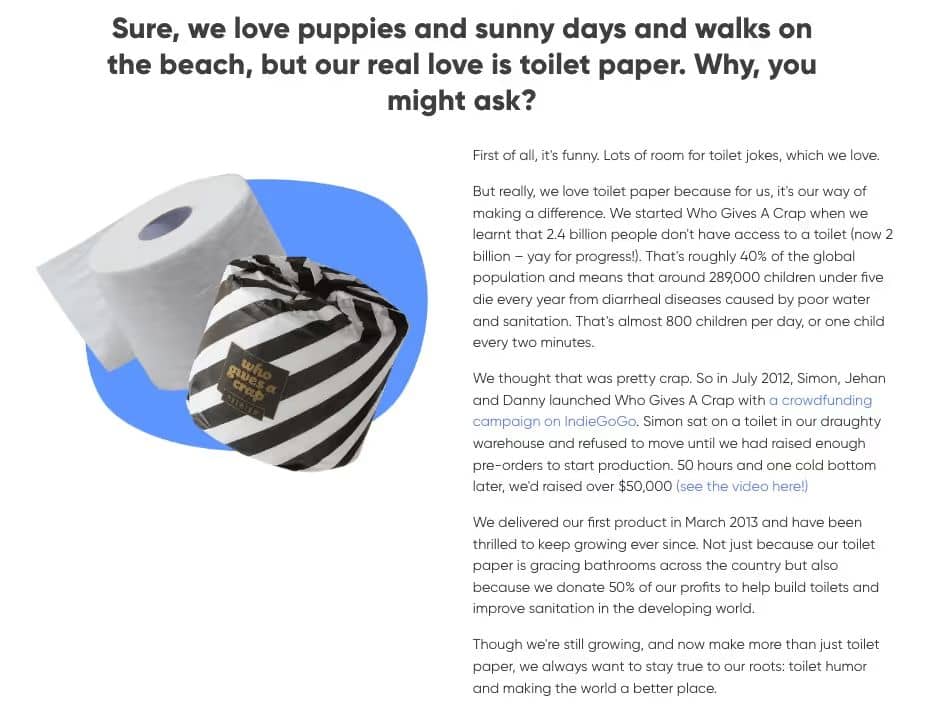
Using the origin approach outlined above, Who Gives A Crap tells the story of how its founders were appalled to learn about poor sanitation around the world, which led them to create a crowdfunding campaign.
The story then addresses its customers by noting how the company’s supporters have helped build toilets and improve sanitation in the developing world. So despite initially focusing on its founders, Who Gives A Crap’s story positions customers as a key to its success.
Companies that don’t have an emotionally compelling history might struggle to create an origin story that feels authentic. In that case, it’s better to write your brand story using a consumer-focused approach.
Here’s an example from BIC, the maker of ballpoint pens, lighters, razors, etc.
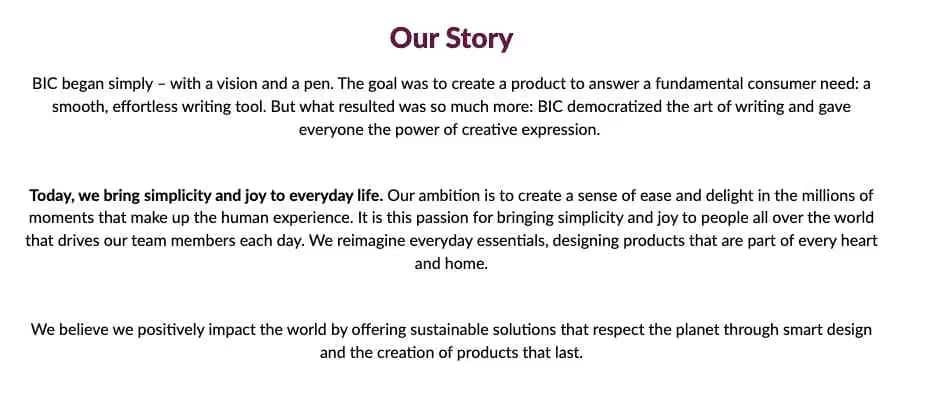
Notice how BIC describes itself as giving consumers “the power of creative expression.” The story revolves around BIC’s goal to “answer a fundamental consumer need” rather than details about its founders. It’s inspiring yet grounded.
Regardless of how your company got started, your brand story shouldn’t be an advertorial to help get your product onto more shelves. Give it some emotional weight, so it can resonate more deeply with your audience.
Your brand story doesn’t need to be long. Who Gives A Crap’s is 235 words; BIC’s is 140. Aim for under 250 words. Keep it simple.
💡 Exercise: Consider these following questions when brainstorming or writing your brand story:
- How was your product inspired by a very real need or desire?
- What value does your product provide to people who buy it or use it?
- Why should customers choose you over a direct competitor?
3. Brand Voice
Your brand voice is how your company would sound if it were a person. It comes across in all your company’s communications. And I mean ALL of them.
A single adjective like “casual” isn’t enough. You should specify more details around your brand’s tone of voice and the vocabulary it uses.
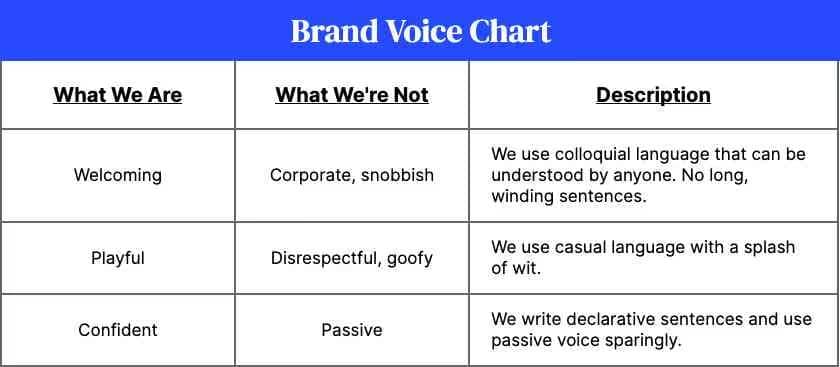
Try creating a brand voice chart to narrow down what your brand sounds like. Here’s one we’ve created for a fictional company. Use it as a template for yours.
Three key DOs and DON’Ts are a good number. When you start getting into four or five tenets of your brand voice, things can either feel nebulous or like a really tight needle to thread.
(Hey, does this headline sound warm, empathetic, hopeful, grounded, and confident?)
Oh, and don’t fall into the common trap of using “authentic” as a key tenet of your brand voice. In my opinion, it’s a throwaway descriptor that doesn’t provide helpful guidance. QUICK: name a couple brands that have an “authentic” tone. Yeah, I thought so.
It also gives everyone on the team license to use their “authentic” tone which can get wily, fast.
Choosing your brand archetype can help define your role with the customer and influence your voice. Choose from this set of twelve well-defined, agreed-upon personalities below, which do a good job at encompassing pretty much every angle a brand can take.
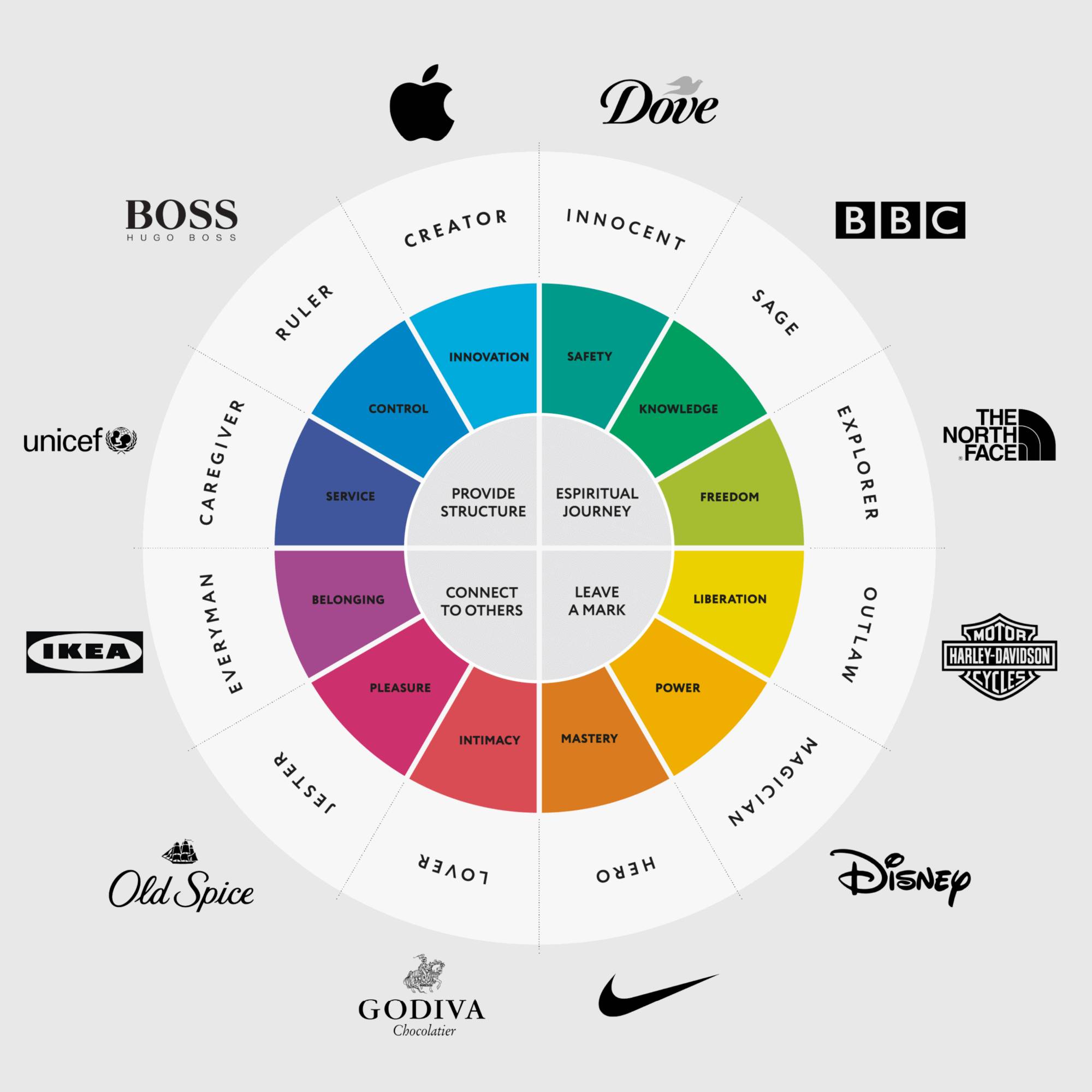
One thing I like to explore when it comes to brand voice is finding the right “brand muse” that embodies our spirit. Got a manly beef jerky brand? Maybe your muse is Ron Swanson. Got an app that’s snarky and disruptive? Your muse might be Deadpool.
Putting a face to this exercise can really help teams grasp the tone. You can hold your messaging up against your muse as a litmus test and ask, “Is this something [our muse] would say or not?” This can be incredibly helpful in giving your team guidance.
4. Brand Design Basics
I’m not going to act like I can cover all of brand design in 1/4 of a newsletter, so this section is here to give you background on the design needs your brand might have right out of the gate.
Brand design revolves around the visual elements that represent your company. It should be as memorable and distinct within your category as possible.
Here are some of the most important, common components of your brand design (if you want to reference them for a project scope with a designer or art director):
- A unique and recognizable logo design
- A defined color palette with 2–4 colors
- 2-3 complementary typefaces
- Company iconography (these are the graphic symbols that represent specific actions, like a shopping cart, messaging bubble, favicon, packaging callout, etc.)
- Guidance on and examples of imagery, photography, and other elements like textures
- A website that combines all of the above assets in a cohesive manner
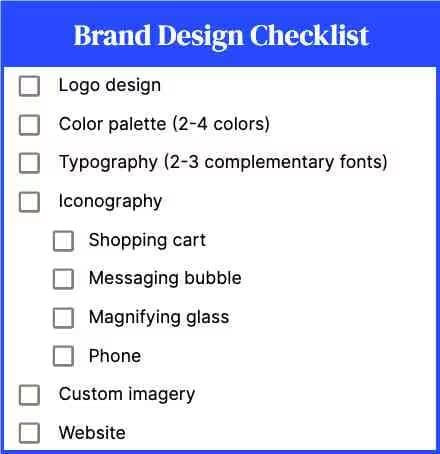
Compared to the other branding components we’ve highlighted, this part might be where things get a little expensive. That’s because strong brand design requires a high level of craft and creativity.
And that can get expensive (tens of thousands of dollars & up) if you go with a high-end agency or design shop.
So if your company is in its nascent stages, we recommend working on your mission statement, story, and brand voice yourself and spending no more than $10,000 on brand design.
If you’re on a super tight budget, use 99designs, Upwork, or Fiverr and focus on a logo, brand colors, typography, and iconography. These platforms will not give you the best assets in all likelihood, but they at least offer a “minimum viable brand,” and you can invest more once you can afford it.
Once you’ve proven viability or received your first round of funding, that might be a good time to level up and ensure your design is airtight and professional.
Gil Templeton
Demand Curve Staff Writer
Four Forces Behind a Strong Brand Identity
Insight from Gil Templeton — Demand Curve Staff Writer

How Beli Is Eating Yelp’s Lunch
Insight from Gil Templeton — Demand Curve Staff Writer
Before the two Beli founders, Judith M. Frost and Eliot P. Frost, married each other, their dates revolved around restaurants, like many do.
However, the couple took it to another level. They documented their dates on a Google Map and kept meticulous notes. They ranked restaurants, color-coded them, and added notes around their meal highlights and inside jokes.
“We weren’t just casually going to restaurants before. We were already pretty intensely tracking it, and that was how this idea came to be — always keeping lists and maps of restaurants.” — Judith M. Frost, Co-Founder & CEO, Beli
After enrolling at Harvard Business School together in 2018, the two began thinking of entrepreneurship more seriously, and they decided to build their startup over the summer between their first and second year.
Despite serious doubts and pushback from HBS peers and professors along the way, they persevered and doubled down on creating an app, which can pose a notoriously awkward path to revenue.
But the couple knew that there was an opportunity for more accuracy, depth, and especially a richer social element to dining experiences. And they knew they weren't the only intensely Type A foodies out there.
“So much of this is really about friendships and relationships. Dining is just this inherently social community thing. It’s all about getting people to go out and do things in the real world.” — Eliot P. Frost, Co-Founder & CTO, Beli
So the two combined the practical utility of a restaurant review platform with a curated, social-first approach to give Gen Z the foodie app they didn’t know they needed.
Fixing the Failing Five-Star Rating System
Before Beli, the platforms for vetting and discovering restaurants largely looked like Yelp, along with Google Reviews, Tripadvisor, and even reservation apps like Resy or OpenTable.
One major drawback of these platforms is the inflated, largely unhelpful five-star review format. In my personal experience, just about every worthy restaurant is somewhere between a 4.3 and 4.8.
The difference between being at the top or bottom of this tiny range could hinge on something that has little to do with the actual food or experience: a disaffected employee, a jealous competitor, a diner with a bone to pick, getting caught in the political crosshairs, people who just have different tastes than you, etc.
This chart below helps visualize this phenomenon, where many major review platforms see the majority of reviews clustered toward the top, creating a largely unhelpful group of neck-and-neck options.

Beli addresses this with a softer, more vibey approach that gradually shapes your profile inside the app and leads to curated suggestions. Instead of asking you to assign a rigid number 1–5, it gives you a green circle “I liked it!” a yellow circle “It was fine,” and a red circle “I didn’t like it,” which is much more in line with how I feel after leaving a restaurant than “That was a four-star experience."
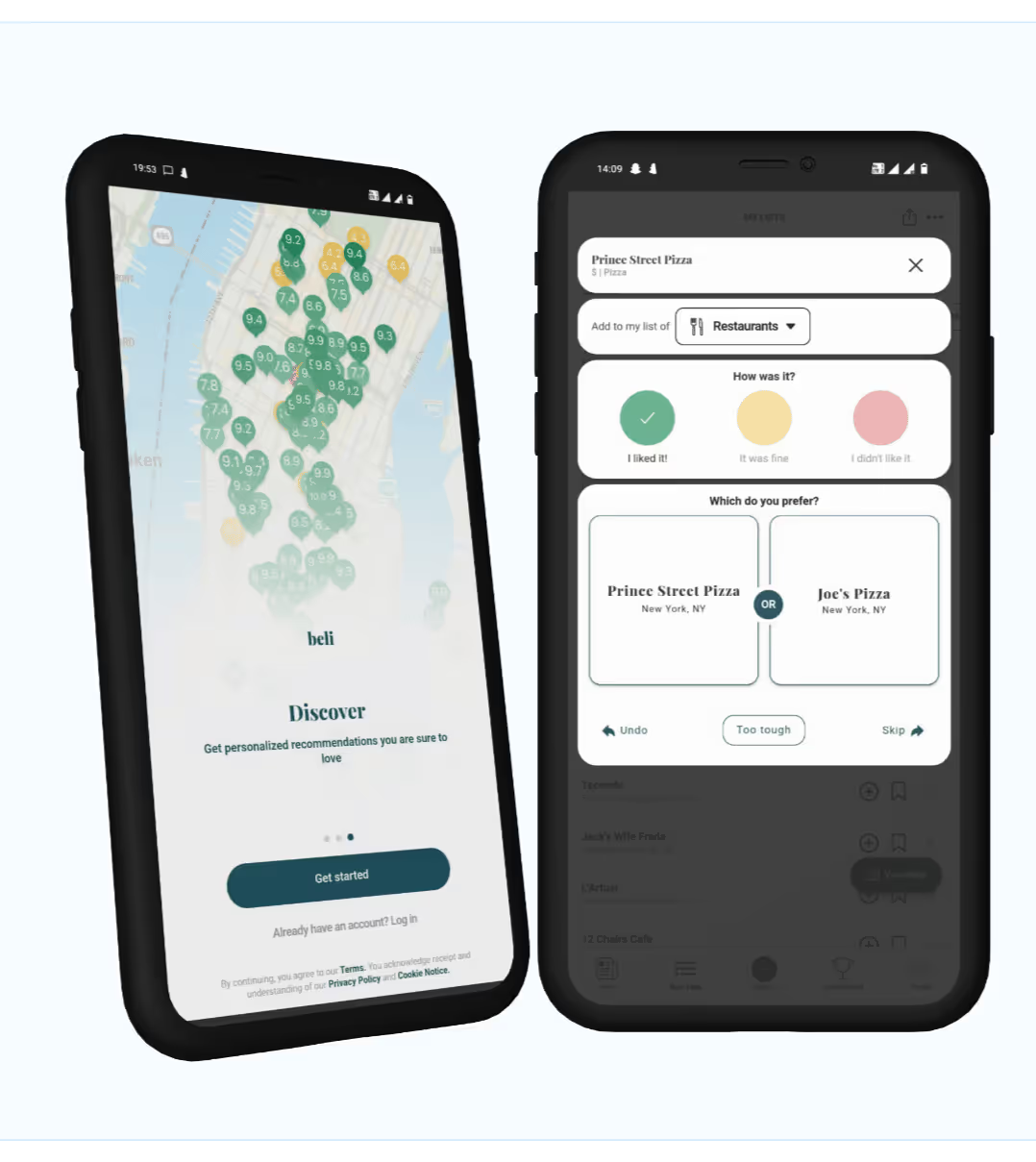
It also asks for your preference between two restaurants you’ve visited, helping the app understand your personal hierarchy and taste, so it can tailor better recommendations for you. Again, this leans into how people actually think: "Yeah, it was great, but not as good as the other pasta place."
This might get difficult when comparing a pizza-by-the-slice joint to a Michelin-rated restaurant, of course, but it helps the app understand your unique preferences and continually hones the output, which leads to our next section.
Answering “What’s in It for Me?”
In addition to rethinking a questionable five-star rating system, Beli has flipped the script to make reviews actually serve the user, not just the restaurant or platform. This naturally fuels an engagement flywheel: the more quality input you feed it, the higher quality output you’ll receive, with a little sprinkle of social validation for good measure.
Instead of asking users to perform free labor for a thankless review platform, every personal rating and comparison helps train the app to know your palate better.
The more you use it, the more it feels like a spot-on personalized recommendation from a discerning concierge, not like you’re spending time shouting into the void or posting on some public message board.
So this becomes less about rating restaurants on an absolute scale, and more about defining your relative taste. And at the end of the day, isn't that what we're looking for? The best experience(s) possible for ourselves and our circle?
Here's how Beli fuels engagement and quality UGC.
The Beli Habit-Formation Loop
- Trigger: You get an invite from a friend (social cue) or hear about it on TikTok/Reels (environmental cue).
- Action: You log your first reviews: low-effort emoji-style responses (”I liked it") that give quick gratification.
- Variable Reward: You get personalized recs and friend-driven insights that feel novel and on-point each time you open the app.
- Investment: You add more restaurants, build out a profile, see your “taste graph” grow, recommendations continue sharpening.
- Reinvestment: Each new dining experience now feels unfinished until it’s logged, so you return to the app to review again. The app's algorithm keeps learning and offering better suggestions. And the cycle goes on.
“I just ranked my 200th restaurant on Beli. I try not to get too caught up in the game of it all — sometimes I catch myself drafting my review in my head towards the end of a meal. But I admit, the game can be really fun, and Beli keeps making it easier and easier to play.” — Sabrina Choudhary, Food Network Magazine
This loop provides serious value to users and plays a huge role in driving more engagement on the app. As we mentioned earlier, the app has seen more than 75M unique reviews since starting in 2021, with a cluster of super-reviewers leading the charge. Throughout a similar timespan, Yelp has fostered 83M+ reviews. However, this number is across ALL business types, not just restaurants.
The chart below shows how restaurants are just a slice of Yelp’s overall presence, meaning that in all likelihood, Beli is driving significantly more restaurant reviews than Yelp.

So instead of asking, “How can I spend my time to make the Yelp platform better today?” Users are instead thinking, “How can I provide feedback that leads to a better experience and maybe helps me look a little more hip to my peers?” And it’s working.
Beli is not trying to be the new Yelp, they are rethinking the utility of food reviews, and making it matter to the user in a tangible way, not just to climb the ladder of a clout-less Yelp leaderboard.
The Social Side of Foodie-Ism
But it's not just about sheer utility. Food is an inherently social activity that’s been bringing people together since…well, forever. But the “foodie” scene of the last twenty-ish years is more about social media than IRL experiences and memories.
Beli bridges this gap between food IRL and food on “social” screens in several powerful ways, and they lay it bare in their above-the-fold header that minces no words: “Track and share your favorite restaurants with your friends.” Those last three words are huge.
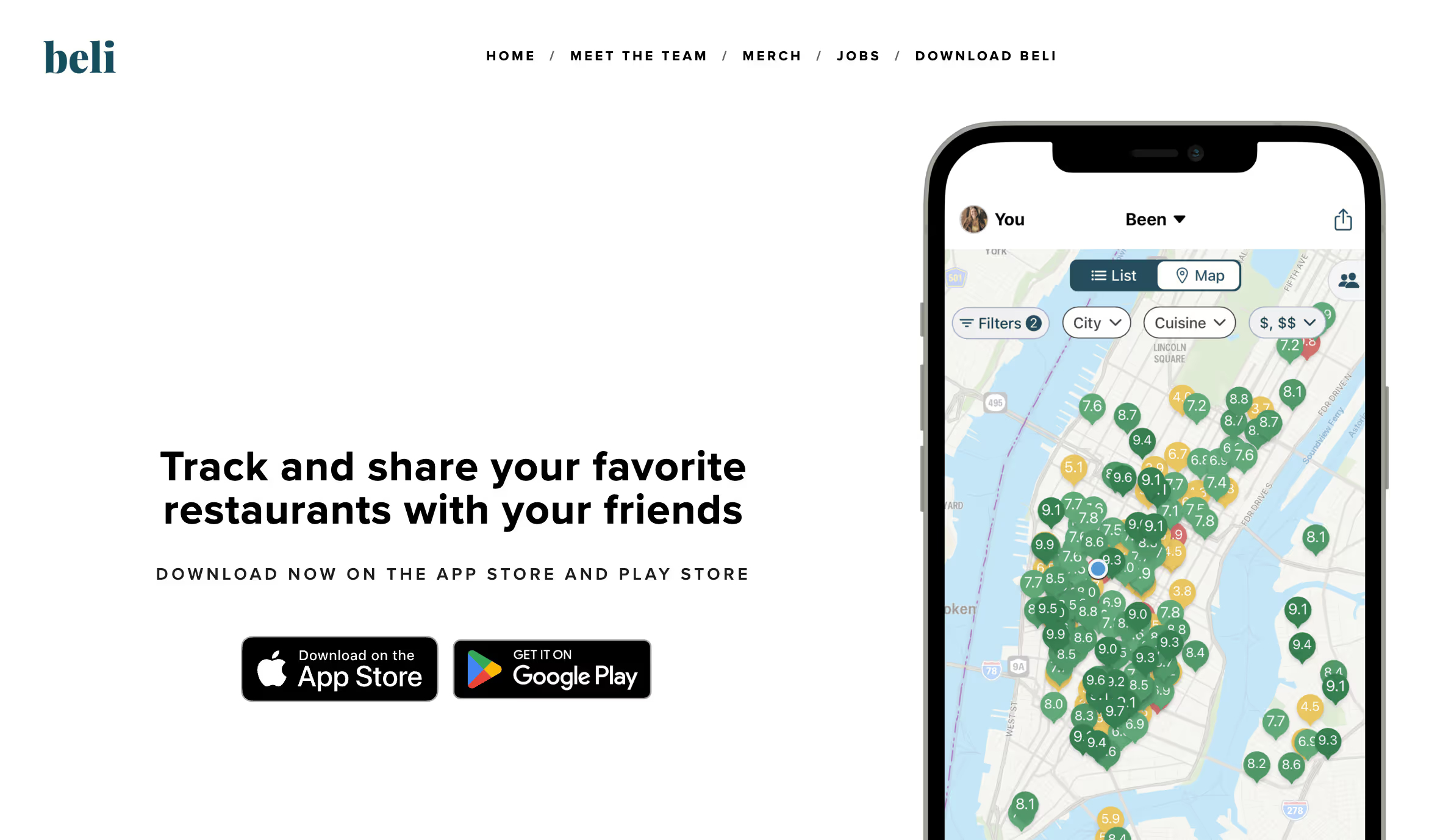
Another clear signal of Beli’s social-first approach (wrapped up in a bold growth tactic) is their heavily gated onboarding process. It forces prospects to invite four people into the fold before signing up, often through an auto-generated text message with a link.

This is a high-friction yet high-reward gambit that’s helping to fuel the app’s growth and “IYKYK” insider status. If three prospects stop here but just one takes the bait, the app “breaks even” in the short term, with more long-term potential and a free hit of brand awareness to boot. It also signals to users that this is a social, peer-to-peer experience by nature, right off the bat.
However, it's a tall order that gives some users (i.e. me) pause, and some people feel a little slimy sending the invites to their friends. For friends who don’t know Beli, it might look like a phishing message or like you got hacked.
I saw a LinkedIn post where a woman invited four friends to the app, and she received these texts in return:
- “Were you hacked?”
- “This looks like spam.”
- “Call me to confirm this is from you.”
- “Is this a supper club?”
It’s bold, for sure. But when you’re the hot new app with tons of momentum and “it” factor, you can get away with it.
Get it while you can, Beli. It’s hard to stay hip for long as a social media platform.

Another way Beli leans into the social aspect of the app is through two scores for each restaurant: a Rec Score and a Friend Score. The first of which is a composite from all users, and the second is specifically from your friends.
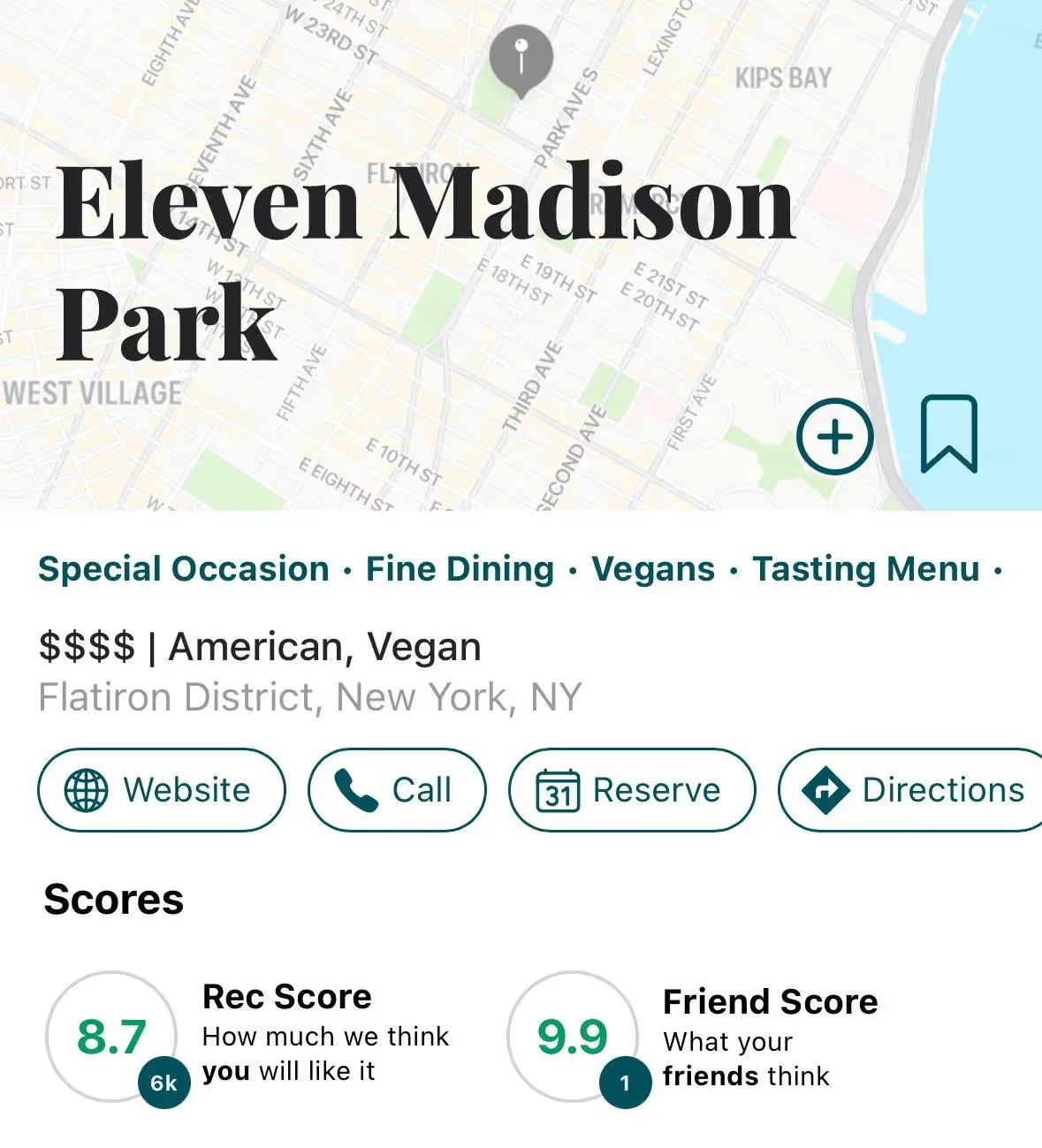
As mentioned earlier, people do not assign a numerical rating to their experience, the app generates these numbers relative to the green/yellow/red votes and the head-to-head restaurant comparisons.
This feature lets you see if people in your circle (presumably with similar taste) had a good experience or not. It also gives users a reason to text or call the friend who’s been there, opening up some natural, off-app dialogue around the experience.
To round out this section on how Beli trades in social capital, Beli is becoming a straight-up status symbol. On one hand, if you are logging the most expensive restaurants on a regular basis, that’s a signal you’ve got money. And on the other hand, if you’re hitting the hippest spots in town, that’s a signal you’ve got good taste and you’re in the know.
“People began sharing their rankings on dating apps to brag about their good taste or vet potential partners.” — Sabrina Choudhary, Food Network Magazine
Beli Speaks Gen Z
Beli says about 80% of their users are under the age of 35.
On the other hand, a meager 24% of Yelp users in the US are between 18 and 34.
The numbers don’t lie, and the contrast between the two couldn’t be more staggering.
Yelp simply hasn’t evolved its model to serve the wants and needs of a younger crowd, and Beli has fully seized this market opportunity.
“No one in my generation writes on Yelp.” — Sofia Jain, 28, prolific Beli restaurant reviewer
Gen Z consumes food and lots of content about food. They’re chronically online, yet they value connection and authenticity.
This app allows them to have both: a memorable and unique social experience, bookended by initial research/discovery and sharing their experience back out afterward.
“My highest rankings on Beli are the dinners I’ve had with friends where none of us touched our phones.” — Elya Rak, first-year student at NYU
In addition to appealing to Gen Z’s psychographics, it makes plenty of business sense to appeal to this generation as well, considering Gen Z visits more restaurants more frequently than any other generation in the US right now. While it probably wasn’t intentional, this happy accident is only pouring fuel on the foodie fire.
All-In On TikTok & Reels
Back before Beli even had an app on the App Store, they had a viral moment that generated thousands of signups on their website (still pinned at the top of their TikTok and IG feed). It was a Reel that featured co-founder Judith showing off her impressive personal Beli map over a funny viral audio clip: "Yeah, no, I would love to go with the flow, but like, what time does the flow start?"
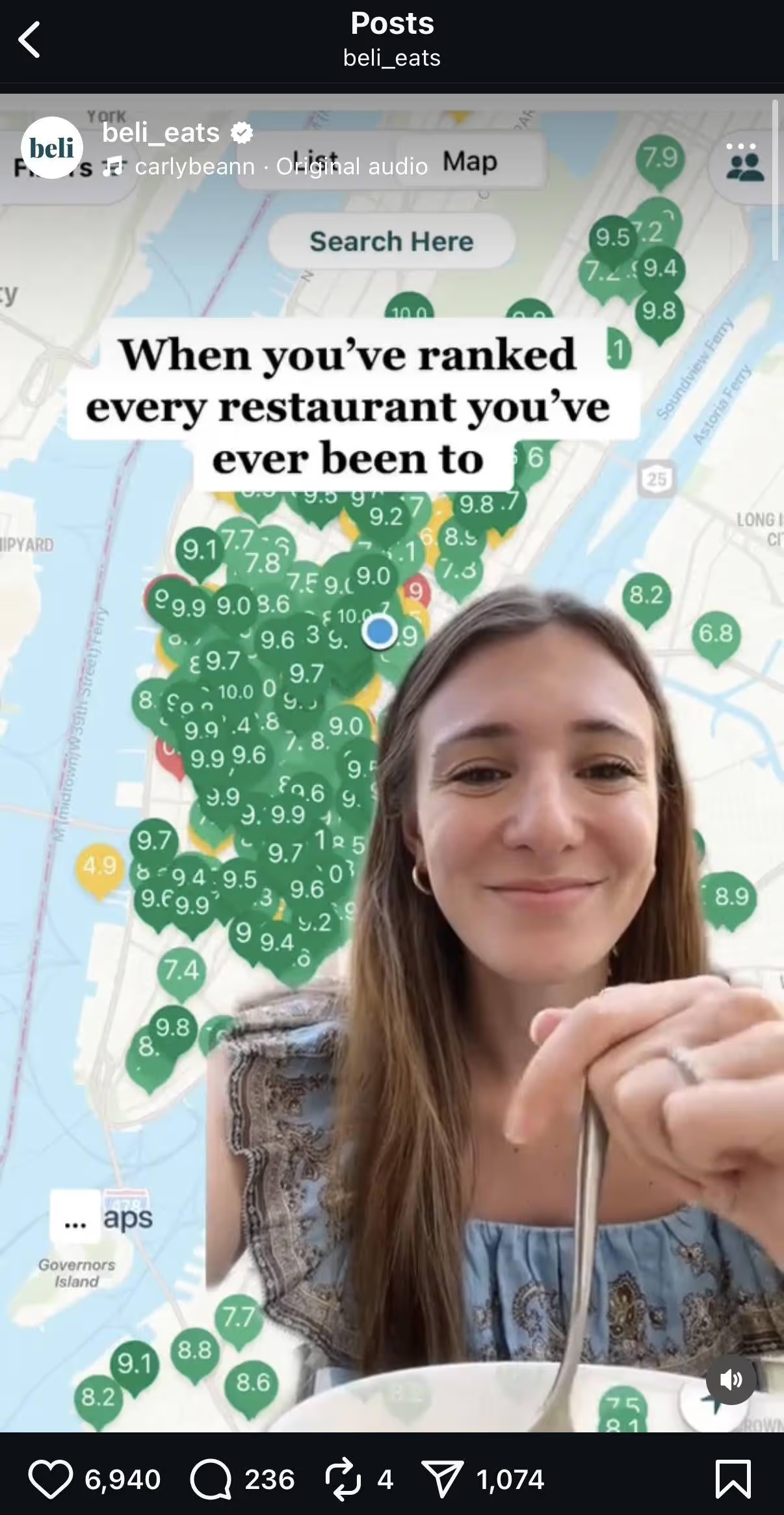
Ever since that validating moment when they realized there were many more Type A foodies out there, they’ve been all-in on TikTok and Reels. And they’ve maintained plenty of discipline and focus on these two platforms to help them grow.
Their organic feeds on TikTok and Instagram consist entirely of pristine videos. Absolutely mouthwatering video hooks, professional VOs, highly visual reviews of amazing restaurants. They also lean into their review/ranking DNA by posting “best of” compilations with defined themes, like “Top 12 U.S. Burgers, Ranked.”

These high-quality organic posts typically grab hundreds of thousands of views and tons of shares, helping them reach new audiences through disciplined, focused efforts. If it ain't broke, don't fix it.
But the real value Beli delivers to social media is OFF TikTok and Instagram, because it lets people “peek under the hood,” so to speak.
Because if you’ve seen foodie influencers hyping a local restaurant you’re considering trying, why not investigate whether the hype is valid or vapid? Beli offers validation, giving people a way to see candid, honest reviews minus the skewed, paid-for foodies or Yelpers with personal agendas.
About two months ago, Beli made another really smart move in the social arena. They’re now letting users bookmark posts in TikTok and Reels, and import them directly into their “Want to Try” list in Beli, making for seamless discovery and further bridging the gap between social media and social dining experiences.
The Takeaway: Show Me The Money
Beli’s story is well and good, with one serious caveat: they aren’t monetizing the app in any significant way. Yet. And until they charge for it, they won’t know if it really works.
The question is: How will they monetize? Will they charge everyone a monthly subscription fee? Run banner ads? Sell the data to restaurant groups? Fall into the same sponsored trappings of Yelp? Only time will tell, but this app won’t be "free" forever. And their ability to keep their authenticity and cool factor through that awkward monetization phase will be critical.
For now, enjoy the free, gourmet restaurant app that Gen Z swears by.
Gil Templeton
Demand Curve Staff Writer

The ROI of a Failed Techstars Startup
Insight from Kevin DePopas — Demand Curve Chief Growth Officer
What’s the economic reality of betting years of your life on a startup? For most founders, it’s not the overnight success you hear about on LinkedIn or TechCrunch.
For me, that reality meant an average annual salary of just $54,700 over 7.5 years, leaving more than $1.2M on the table in opportunity cost.
To give you a baseline, our startup was admitted to Techstars. We raised $2.4M over 7.5 years and peaked at about $50k in monthly recurring revenue.
Here’s what that meant for my personal earnings over that period:
- Years 1-2: $0
- Years 3-4: ~$50,000/year
- Years 5-6: ~$80,000/year
- Year 7-7.5: ~$100,000/year (before dropping back to zero at the end)
My total earnings over 7.5 years were roughly $410,000.
Now, let’s compare that to a more conservative corporate path I could have taken, going into product management, growth, or any number of other functions:
A conservative estimate:
- Base Salary (7.5yrs): ~$1,150,000
- Stock/RSUs: ~$400,000
- 401k Match: ~$60,000
- Total Comp: ~$1.61 Million
An aggressive (but still realistic) estimate:
- Base Salary (7.5yrs): ~$1,400,000
- Stock/RSUs: ~$700,000
- 401k Match: ~$70,000
- Total Comp: ~$2.17 Million
When you subtract my actual startup earnings (~$410k), the direct compensation gap lands between $1.2M and $1.8M.
But that’s not the full economic cost. Looking at the S&P’s returns from that period, the missed compound interest on that unearned cash adds another $450k to $600k to the total.
That brings the full economic cost of my 7.5-year journey to somewhere between $1.65M and $2.4M.
I assure you, this isn't intended to be a sob story. It’s just the statistical reality for the vast majority of founders. Studies show around 90% of startups fail, and far fewer actually produce life-changing financial outcomes. Remember, just because a startup doesn't "fail" doesn't mean you're thriving.
If you're a founder reading this, hate to say it, you’re likely making a similar financial sacrifice, whether you’ve run the numbers or not.
Look, I'm not saying you shouldn't do a startup. I just think founders (and startup employees alike) should acknowledge that your grit and determination aren’t infinite resources. The goal isn’t to bleed for a decade (or 75% of one, in my case) to prove a point. It’s to get to an answer (“Is this working or not?”) as QUICKLY as possible. Or GTFO.
What I'd Do Differently (With Hindsight)
With the benefit of hindsight and a lot of expensive lessons, here is a long list of things I would do differently.
Before we dive in, a disclaimer: these recommendations are just things I would keep in mind, given my personal experience. These aren’t universal rules. For nearly every recommendation below, you can find a famous example of a successful company that did the opposite. And if you’re currently doing something I say I’d never do again, it doesn’t mean you’re wrong.
This is about stacking the odds in your favor. My belief is that the more of these you get right, the smoother your path will be. The more that are working against you, the steeper your uphill battle.
1. Learn on someone else’s dime first.
After about a year at Deloitte Consulting, I left to start my company. If I could do it again, I probably would have explored joining someone else’s startup first. Specifically, a company that had already raised a sizable seed or Series A round, so they have traction and resources. I think I could have learned some core startup skills, gotten my hands dirty on a lot of different problems, and seen what an early-stage company is like from the inside, without incurring a ton of risk. Oh, and all while getting paid close to market rate (so I can invest some of it and let the earnings compound) and maybe I'd even get a little equity upside.
Who knows, joining another startup might have even scratched the entrepreneurial itch enough that I wouldn't feel the urge to start my own company.
2. Solve a problem you’ve actually lived.
I co-founded my startup with my brother while he was in his residency to become an interventional radiologist. He was the one living the problem we decided to tackle; I wasn't. That second-hand understanding turned out to be a major blind spot. Because I didn’t experience the problem myself, I couldn’t foresee the high regulatory burden, I didn't understand the unit economics of healthcare well enough to know we were fighting an uphill battle, and frankly, I couldn’t see that we were building more of a “vitamin” than a “painkiller.”
Yes, you'll hear stories about how industry outsiders sometimes make the best founders because they aren't jaded by long-held beliefs, but I'd bet that 9 times out of 10, you're better served by DEEPLY understanding your space.
3. Don’t quit your day job without real validation.
I would hesitate to leave a stable W-2 job again without either a convincing number of paying customers OR a solid cohort of users who are repeatedly using and benefiting from my product. Instead of jumping in headfirst, I would launch an analog product or a “wizard-behind-the-curtain” service/minimally viable product while still employed. Ideally, I wouldn’t make the leap until my side gig was actually cash-flowing, to further de-risk the leap.
4. No part-time co-founders.
My brother was incredibly dedicated, pouring an insane amount of time into the company on top of his medical training (I still don’t know how he did it). That said, I found that startups demand an unreasonable, all-in level of commitment from their leaders, and our unconventional co-founder dynamic had real consequences. We could only meet at awkward hours, which slowed down our decision-making. It also meant we had one less hands-on operator to manage the day-to-day of the business.
5. Treat cash or real usage as the best indicators of traction.
Early on, I mistook positive sentiment and verbal commitments from customer interviews as a strong validation signal. I'd soon learn that real validation is not someone smiling and nodding during a sales call; it’s a cash transaction, a contractual Letter of Intent, or a signed design partnership where the customer has real skin in the game. Most people are nice and will hesitate to give brutally honest feedback, especially when a founder is passionately pitching a vision of a future that doesn't yet exist.
A quick note on validating with a free product:
In the hunt for validation, you’ll often hear that you shouldn't give your product away for free. My take is that it can be a powerful test. If you offer it for free and people use it and love it, that's a great signal. Now your job is to see if they'll pay. But if you offer it for free and get no adoption, that’s a major red flag that the problem isn't painful enough, or you’re not solving it in the right way.
6. Resist raising money for as long as possible.
Looking back to 2016, maybe it was the books I was reading or the podcasts I was listening to, but when I founded my company, I was infatuated with the venture and startup world. I saw fundraising as a way to boost my ego and prove we were on the right path. I’ll never forget getting the call that we’d been accepted into Techstars; a part of me genuinely thought, “This is working...How can we possibly fail?” Turns out fundraising can be a false validation signal too. Moreover, it’s massively time-consuming and can add immense pressure, cloud objective decision-making, and make it psychologically harder to walk away when things aren’t working.
7. Put a clock on your efforts.
If I did raise, I’d be explicit with investors from day one: “I’m giving this 12–18 months. If we haven’t found meaningful traction, there's a chance we'll shut this down. How does that make you feel?” That level of transparency will help alleviate the sunk-cost pressure to “just keep going.” I would also openly talk about the very likely down-case scenarios where the business goes to zero. If I sensed my investors were blinded by the potential upside, I would keep pressing until I knew they truly understood the risk they were taking.
My only negative investor experience came from breaking this rule. I took a $50k check from someone I never met, without having the brutally honest discussion mentioned above. Because we never aligned on expectations (and they never got to know me as a person, see how hard I worked, or understand how much I cared), they were furious when the investment didn't pay off, despite their personal net worth of nearly $500M.
8. Be intellectually honest about product-market fit and friction.
If customers aren’t pulling the product out of your hands, you might not be solving a painful enough problem, offering it in the way your buyer wants, or making it easy enough for them to adopt. That friction you feel is almost always a signal that one of your core foundations is shaky. It could be a sign of poor product-market fit, a weak market-model fit (your pricing is wrong for your market), or even a broken channel-model fit (you can't profitably reach your customers).
We talk about the concept of the "Foundational Five" at length in the Demand Curve Growth Program. The first time I was introduced to the Foundational Five framework, it gave a name and structure to the headwinds I had fought for years. It’s a solid framework, and one I’d encourage any founder to run their business through to make sure they aren’t swimming upstream from day one.
9. Make sure your niche is big enough.
Niching down is great because it allows you to focus on solving ultra-discrete problems better than other generalized solutions that dabble. But it also shrinks your market size. Sometimes it's easy to forget that not all niches are created equally. As you narrow your focus, do a quick market sizing to ensure your Total Addressable Market (TAM) is still large enough to support the kind of business you want to build. My business ended up in a very small niche that was hard to scale out of.
10. Build a business with healthy margins.
High-margin businesses are a superpower. They allow you to spend more on advertisements to acquire customers, reach profitability faster, reinvest in growth, and hire better talent. They increase your margin for error. The business I started ended up being lower margin than we thought it would be, which made it difficult to reinvest in growth and expand into new service lines. Wouldn't recommend starting a business that you know will have low margins from the outset.
Psst...the quickest/easiest way to improve your margins is to increase your price 😉.
11. Confirm a reliable channel to your ICP exists.
Before you build, I'd pressure test whether there are a few (more than one) reliable, scalable channels to reach your core customers. For us, interventional radiologists ended up being pretty hard to get in touch with. They’re on LinkedIn, but not as frequently as business folks. They’re too small of a group to target effectively on Meta. You can reach them through platforms like Doximity, but adoption amongst the community was still low. We found that word-of-mouth and specialized medical conferences were the way to go, but admittedly, we unlocked conferences too late in the game with too little cash (and stamina) in the bank.
12. Start with a small, effective feature set (not a platform).
Sometimes it can be tempting to build a grand, comprehensive tool from the outset. Yes, there are examples of companies that have done this (Attio CRM comes to mind), but I'd personally resist that temptation. Instead, I'd isolate the smallest possible feature set that can provide 10x value to a user. I'd validate that minimal feature set quickly, get it into people's hands, learn from their usage, and only then expand into a platform over time.
13. Optimize for short sales cycles early on.
Our first idea involved selling to enterprise hospital systems, which meant 12-18 month deal cycles. It took forever to get feedback and learn if what we were doing was even working. If I were building a B2B company today, I would start in the SMB or mid-market space to get rapid feedback from customers, accelerate learning loops, and secure early wins before attempting to move upmarket.
14. Avoid business models where value is out of your control.
Here's what I mean, I would never build another lead-gen company (sorry if you're reading this and you have a lead-gen company). The model is brutal because the value your client receives is entirely dependent on their ability to close the leads you provide. If their sales team is slow or ineffective, your product is perceived as worthless, even if you delivered perfectly qualified leads.
Lead-gen companies are just one example of businesses where the ultimate value is out of your control. Think about two-sided marketplaces, where your platform's value depends on the quality of third-party users. Or a sales coaching platform designed to improve a rep's pitch, where the tool's value is completely dependent on the rep actually using it, internalizing the feedback, and changing their habits over time. In all these cases, you can do your job perfectly and still get blamed when the customer fails to get a return.
If/when I do it again, I'll build something where value is delivered directly by the product itself. Which leads me to my next recommendation...
15. Provide unambiguous, self-evident value.
The faster you can prove your value, the faster you can build momentum. I would avoid businesses that require long, drawn-out pilots or multi-month trials to prove a complex ROI. I’d much rather build something where the value is immediately apparent and experiential. For example, let's say I was building a new document editor software where the selling point isn't some complex business case quantifying hours saved by employees who use it. Rather, someone who uses the tool has the simple, qualitative feeling of, "I just prefer this experience to Google Docs." That kind of self-evident value can shorten the path to testimonials, social proof, and word-of-mouth growth.
To be clear, I'm not encouraging you to avoid building a business on a quantitative outcome like time saved or revenue gained (most great businesses have some quantifiable business case). But if you go that route, I'd just make sure the value is both undeniable and highly reproducible. Marginal improvements (a slight time savings, a few more closed deals, single-digit percentage points of increased revenue, etc.) may not be a strong enough value prop to scale. That’s the kind of value that gets challenged during sales calls, debated during renewal calls, and cut from the budget when things get tight.
16. Drastically shorten the ‘Time to Value’.
Here's an observation I've had about momentum: when a customer can feel the impact of your product in hours or days, not months, it creates a powerful tailwind for growth. The faster you can get someone through the loop of seeing a demo, trying the product, and having that “aha!” moment, the sooner they start telling their friends and colleagues. That speed drastically shortens the time it takes to get case studies to socialize with other prospects.
This isn't to say you can't build a business where it takes a full quarter to see meaningful results - many huge companies operate this way. It just means you're choosing a more resource-intensive path. That journey typically requires more coordination, more hands-on change management, and a larger support team to ensure your customers get the value you promised.
17. Productize a known, analog behavior.
From the perspective of de-risking your entrepreneurial journey, I get excited by ideas that aren't totally new 'inventions.' Rather, you can find a problem people are already using some workaround to solve, and productize it. The opportunity is simply to package that existing behavior into a better, easier, more seamless solution.
A great e-commerce example is the Squatty Potty. For years, people were using a clumsy workaround (stacks of books or a random stool) to elevate their feet for a more natural position on the toilet. The company simply took that exact DIY behavior and created a purpose-built, branded product to solve the problem perfectly.
You see the same pattern in software. Loom is a good example. Before it existed, users needing to explain a complex issue visually would use QuickTime Player to record their screen, save the large file, wait for it to upload to Google Drive, and then finally send a link to a team member. The process was slow and ate up both local and cloud storage. Loom took that exact behavior and made it seamless, productizing the entire workflow so you can record and share instantly with a single link.
The Bottom Line
I want to end by saying that startups are an amazing thing. They are a core part of our economy and, in many ways, the "American dream." On a personal level, some of those 7.5 years were the best of my life. When you're truly locked in on solving a problem you're passionate about with team members you enjoy being around, the process can be insanely fun. There's real joy in the journey.
But I also believe it's important to step back every six months or so and have an honest conversation with yourself, your co-founders, and your spouse (hell, talk to ChatGPT for all I care) about the following things:
- Is this still serving me and my family?
- Am I still having fun? Am I enjoying my life and the work I'm doing?
- Are we being objectively honest about our traction and the validity of this idea?
- Is there real upside here?
- How long will it take to achieve?
- What are my alternatives, and what is the real cost of continuing down this path?
Answering those questions clearly is the goal. I personally think frameworks like the ones we teach in our Growth Program can help you get there faster, but the tools you use are less important than the conversation itself.
If this story resonated with you in any way, feel free to reach out. I'm always happy to chat with other founders who are in the thick of it. I promise, you're not stuck. ❤️
Kevin DePopas
Demand Curve Chief Growth Officer
Appendix:
My 7.5-Year Startup Journey (TL;DR Version)
The First Idea: Sway Health (Preventative Counseling at Scale)
We started with an ambitious idea that got us into Techstars: an enterprise software that integrated with hospital EHRs that would scan patient files for untreated behavioral conditions, generate an evidence-based counseling session personalized to a patient, and automate the use of preventative counseling billing codes.
- Why It Failed: The sales cycle into hospitals was 12-18 months. The revenue per counseling session was minuscule compared to other lucrative procedures. And most importantly, the problem wasn't a painkiller for physicians; our software added clicks to their already-packed workflows/schedules, so pilot utilization was abysmal. The time to results to prove efficacy was long.
The Pivot to a Marketplace: Pain Theory → Helped
Because enterprise was so slow, we built a direct-to-consumer arm of our preventive counseling tool, which taught us how to target patients via advertising and build intake technology. Doctors suggested a higher-margin use case: using our tech to find them qualified candidates for niche medical procedures. This led to our first major pivot. We rebranded to Pain Theory, a marketplace to connect patients with pain specialists. After raising a couple of bridge rounds, we rebranded again to Helped, raising a $1.8M seed round to build a broader specialist marketplace.
- Why It Failed: Building a two-sided marketplace is expensive. If we wanted to do it right, we'd need to raise a lot more money to build awareness on both the supply (doctor) and demand (patient) sides, and we would have had to subsidize low margins for years. We also ran into the legal complexities of pricing a healthcare marketplace due to anti-kickback statutes, meaning we could only charge pennies on the dollar for the value we were creating for doctors.
The Final Pivot: The Tech-Enabled Service
We saw that thriving D2C healthcare businesses like Hims and Roman used the same playbook: attract a patient with an ad, qualify them with an intake funnel, schedule a telehealth session, nurture nurture nurture until the patient decides to purchase a product. With the existing technology and expertise we had built up over the years, we decided to offer this entire playbook as a service for small- and medium-sized practices, enabling interventional radiologists and interventional pain specialists to implement similar intake funnels to Hims and Roman. We handled everything from ad creation and campaign management to building their intake flows and having our care coordinators text and call patients to coordinate scheduling. This was the business that got us to $50k in MRR.
- Why It Failed: Even with positive ROI, most procedural specialists aren't used to acquiring patients via paid media; their businesses are largely referral-driven, which resulted in their willingness to pay being lower than expected. To get them results, we had to take on more and more of the operational work (from lifecycle marketing to hands-on patient management) which made our service more expensive than doctors were comfortable paying. The concept of spending 20-30% of a patient's LTV on acquisition was foreign to them. And again, pricing can be really challenging in a regulatory healthcare environment. The time-to-value was still slow (~4 months to prove ROI). Even so, I'm incredibly proud of the impact we made. We connected countless patients with minimally invasive alternatives to surgery they never knew existed and delivered a scheduling experience that was second to none. But alas, the business began to look more like a non-scalable agency than a tech company, so we decided to shut it down.
The ROI of a Failed Techstars Startup
Insight from Kevin DePopas — Demand Curve Chief Growth Officer

Perfecting Your Above-The-Fold Design
Insight from Gil Templeton — Demand Curve Staff Writer
There are times when unbridled creativity and “reinventing the wheel” can give your company a major leg up. However, your ATF is not usually one of these instances.
*Insert sad trombone*
Because your product should be the most interesting part of your website, not the site design itself.
So don’t be overly audacious or aggressive with avant-garde design unless you have a real reason to be (ex. you’re a web dev company, a high-end architecture firm, a fashion brand, or a creative agency that trades in taste, aesthetics, or digital craft).
People have been trained on how to navigate typical websites, and there’s a certain set of expectations users already have.
So don’t ask them to swim upstream and work against what’s been ingrained in their heads; create a site that helps them swim with the current instead. And give them nudges along the way to keep guiding them toward the action(s) you want them to take.
Messaging Takeaways From The Last Newsletter
Just to reground us (and to prevent you from rummaging through your inbox and inevitably getting distracted) let’s revisit the key takeaways from last week’s Growth Newsletter #282:
- Your header should use specificity to convey your value and show a customer what they stand to gain, often in an actionable/imperative way.
- You should augment your header with a “hook” that either makes a bold claim or directly handles at least one major objection viewers might have.
- Your subheader should work hard to answer “What, exactly, is our product?” and/or "What features make our header bolder or more believable?" in a sentence or two.
Remember, your ATF is where viewers’ skepticism is highest and their attention span is shortest, so nailing the message is critical to lowering your bounce rate and boosting your conversion rate.
Do not fall into the trap of merely describing your company like a dictionary definition or using abstract language that lacks clarity.
Now that we’ve run through the tenets of good ATF messaging, let’s get to the design side of things.
Incorporating Images
When adding imagery to your ATF section, there are two goals to keep in mind:
- Make sure the images are visually appealing: modern, crisp, pretty, positive. If you aren’t a designer, it’s probably worth outsourcing this part to a professional.
- Ensure the images demonstrate your product’s value. This can often be done by showing the product in action.
In the example below, Gusto includes an attractive dashboard view of their product in action, which begins above the fold and invites users to scroll to see the rest. It quickly shows users how they can simplify payroll, HR, and benefits on one cohesive platform.
This “peek under the hood” helps to de-risk and remove uncertainty for viewers.

If you’re selling physical goods, consider doing two things:
- Show off various use cases
- Show close-ups that convey quality, giving users a fuller appreciation of the product.

Another consideration for e-commerce companies: If your product’s packaging is aesthetically pleasing, consider displaying your product in its actual packaging.
You might persuade more shoppers to click in hopes of “unboxing” the product and seeing more. You might also help shoppers recognize you at shelf if you have a retail presence.
Here’s how 3 Leaf, a matcha company, does just that:
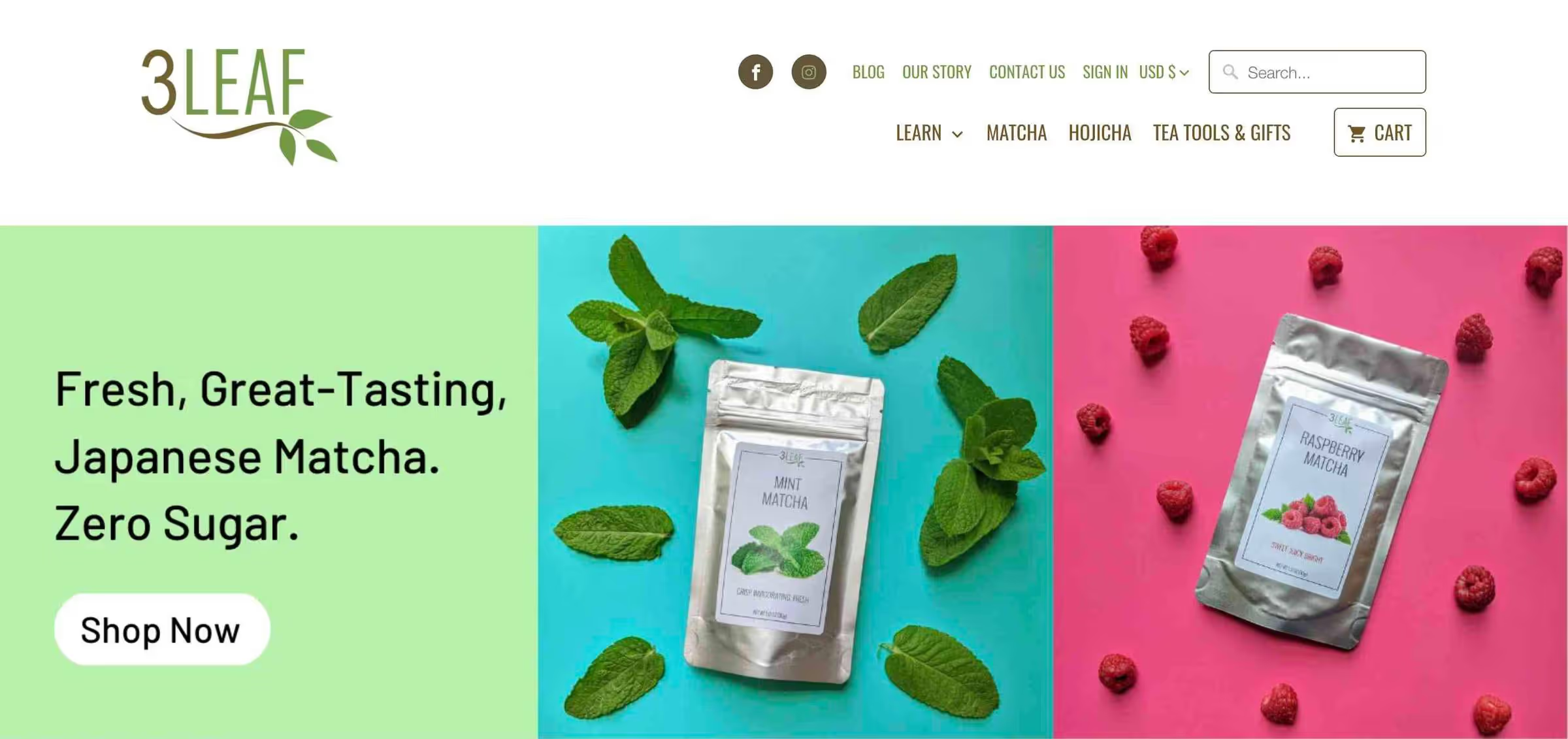
Using Negative Space
While it’s not a hard-and-fast rule, keeping plenty of empty space between elements in your ATF will help your copy and visuals pop. It also adds a certain understated sophistication that can convey confidence and quality.

Below is an archived counter-example that takes a visual approach we don’t recommend. The visual here doesn’t add any value by educating or lowering perceived risk. It also competes for hierarchy with the message. Not to mention the subhead clashes with the image, which looks unintentional and unpolished.

Navigation Bar
As a general rule of thumb, the fewer links you have in your navbar, the better. Try to minimize analysis paralysis and not overwhelm viewers.
Especially if you’re a traction-stage startup, you should be guiding users toward the single key action you want them to take, whether that's to request a demo, start a free trial, or book a call with your sales team.
Below, Slack probably has too many things going on in the nav bar. Whereas Trello is possibly too minimal with their approach; Having a few more options would likely help them build confidence with buyers.

A good rule of thumb for your nav bar is to use 2–4 links plus a standout CTA if it’s your homepage or landing page.
CTA Buttons
Let’s talk about those little rectangles that can make a big difference: “Call-To-Action” buttons.
Below, you’ll see two strong examples. Directives like “See what’s nearby” and “Start Learning” are continuations of the magic that’s been teased in the header copy.
It feels natural to click on these CTAs, because they help the visitor continue the narrative these companies have begun.

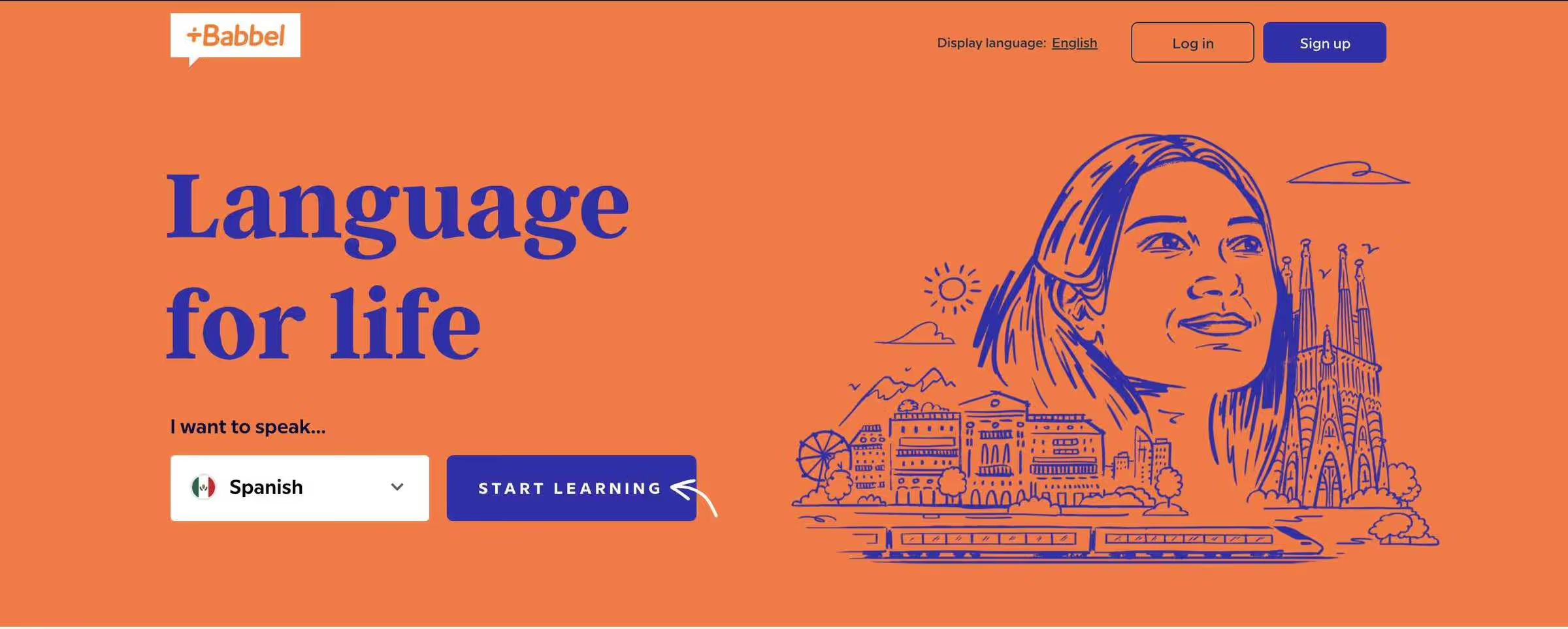
You can think of your CTA as the actionable next step to fulfilling the claim in your header. Being specific, action-oriented, and positive is good here; Do what you can to entice users to click, then take them somewhere that delivers on your promise.
Below, you’ll see a weak example of a CTA button above the fold.

First of all, the copy is vague throughout, so it never really establishes what a viewer stands to gain. From there, it pushes you to “Request meeting” which seems like an incredibly tall order at this stage on the website, especially when the takeaway is nebulous at best.
It’s like proposing to someone on a first date that’s not even going particularly well. Perhaps if they were more specific about what their software enables or alleviates, a “See demo” or "Learn more" CTA would be more appropriate.
Look at some (archived) examples below from companies that understand how to use specific, actionable copy in their CTA buttons.
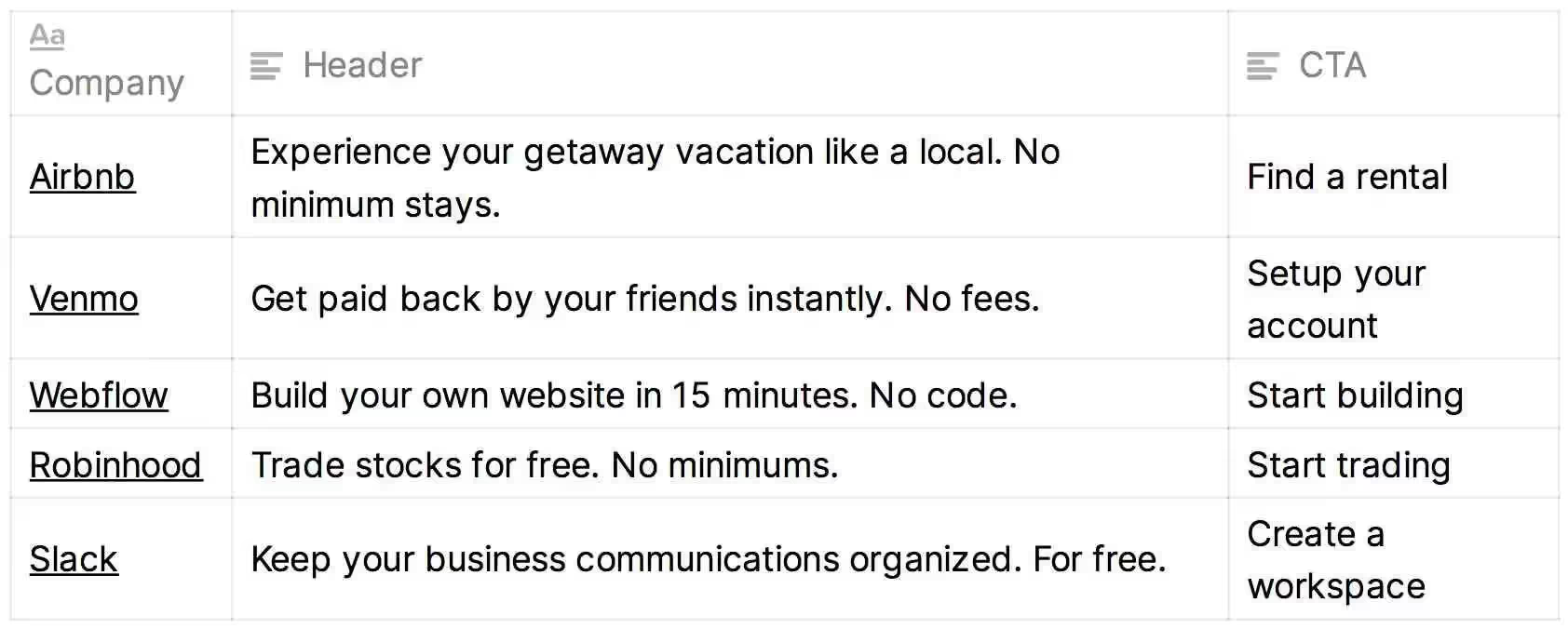
Sometimes The Best CTA is to Keep Scrolling
Some products are inherently more difficult to “pitch” in a few seconds than others. If your product falls into this category, you might benefit from providing more context/education on your homepage or landing page before asking users to click and sign up.
That said, you should consider having your CTA button simply lead further down the page. Then have a CTA that’s more conversion-focused once a user is down there. A simple “Learn more” button below drives users to more info below without muddying up the ATF.
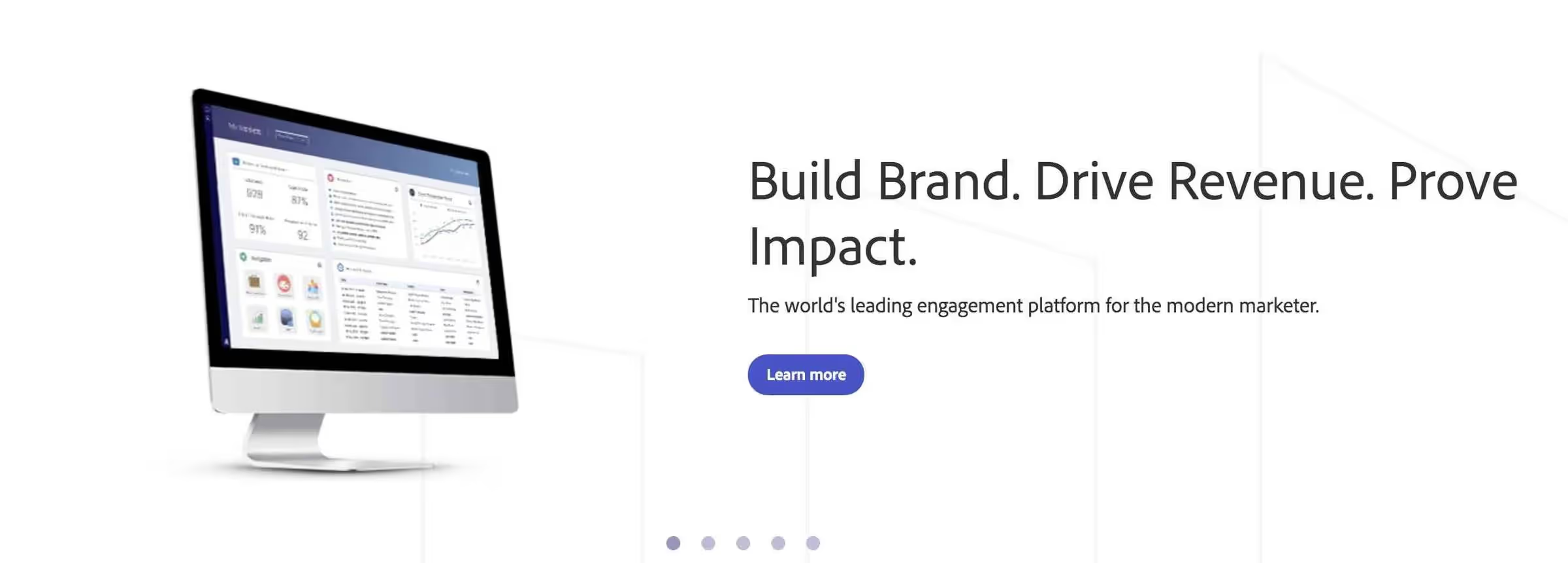
Or instead of adding a CTA to keep scrolling, you might also consider cutting your ATF short, so visitors must scroll to see the rest of what you’re teasing. We saw this approach earlier in the Gusto homepage example as well.
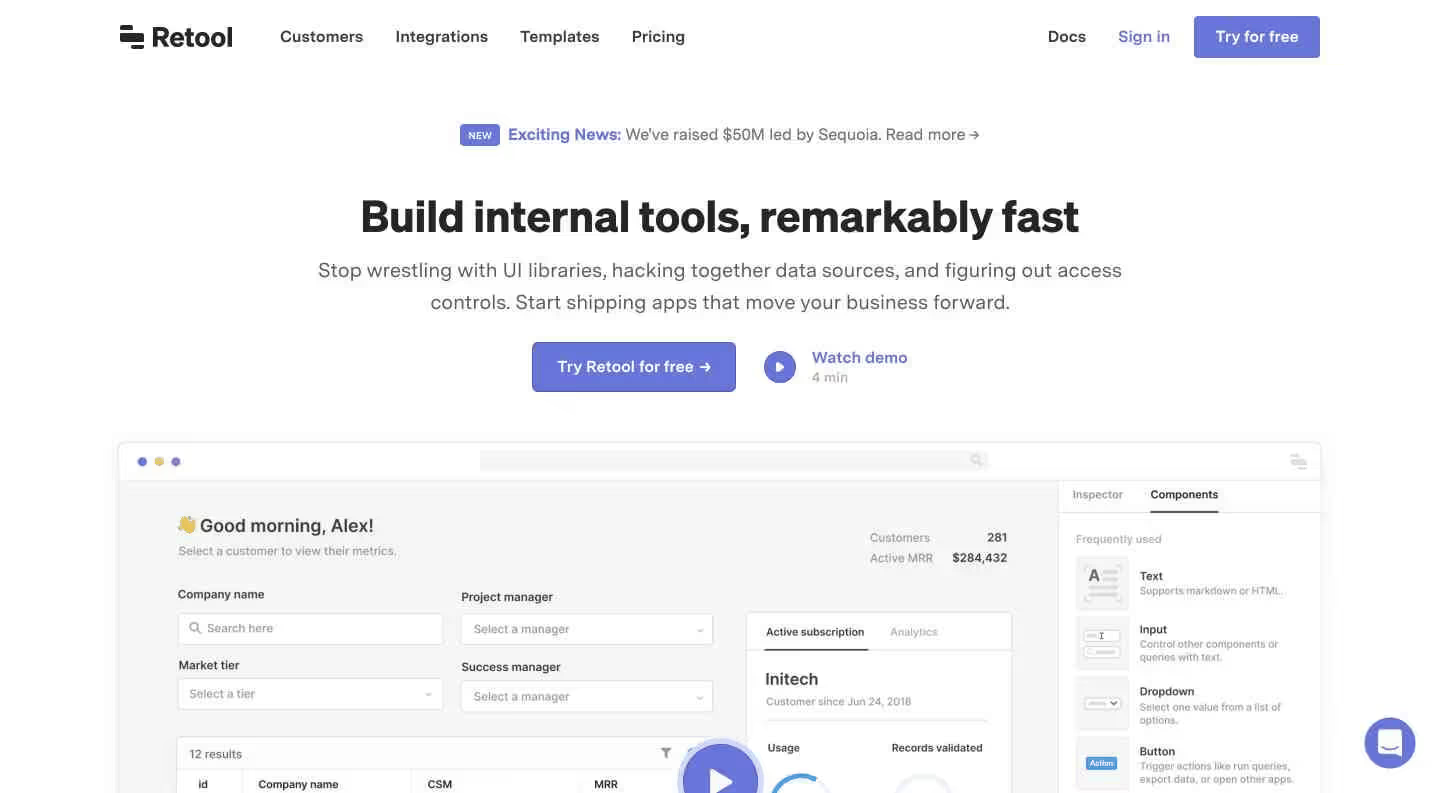
To Recap
Your ATF starts your brand’s narrative in viewers’ minds. Strong ATFs give visitors the specificity, the “what’s in it for me?”, and clarity they need to take the next action in your funnel.
Like we said last week, you only get one chance to make a first impression, so this area warrants a lot of time and attention to ensure it’s working as hard as possible for you.
Your ATF design says just as much about your brand as your ATF message. A clean, modern look communicates you’re probably worth trusting, just like a compelling and focused message does.
And while viewers might not consciously pore over every word of copy, the instant, visual nature of your design will quickly make a strong impression with them, where they either sense you’re buttoned-up and put-together or sloppy and not worth their time.
You should always A/B test new design updates to ensure they’re improving your key metrics. It’s not always the case that more artful or beautiful design moves the conversion needle, so practice good fundamentals and keep iterating.
Gil Templeton
Demand Curve Staff Writer

Your Above-The-Fold Messaging Playbook
Insight from Gil Templeton — Demand Curve Staff Writer
While this newsletter focuses on increasing above-the-fold conversions and standing out from your competitors, it’s not just about your ATF. It’s also about learning how to position your startup in a way that excites people.
Your ATF should be a concise distillation of your brand in elemental form. Once you’ve cracked the code, it can serve as your Rosetta Stone to inform other key messaging pieces.
On the other hand, if you’re having trouble putting together an ATF that converts, it might be symptomatic of other issues that require a closer look.
If your current ATF is confusing or uninteresting, visitors bounce. This happens because of:
- Weak messaging: Your product’s purpose is unclear, irrelevant, or not compelling enough.
- Weak design: Your design is unprofessional, dated, or unintuitive.
This newsletter specifically addresses ATF messaging through a systematic, proven approach. Stay tuned for a follow-up newsletter where we’ll focus on design. You can also check out this entire playbook on ATFs.
Reminder: It’s. Not. About. You.
Before we get into specifics, let’s re-ground ourselves with an overarching note: your ATF copy is not the place to gush and blab all about your company. It’s the place to show visitors what they stand to gain, and how you’re positioned to deliver it.
This general principle is one of the hardest marketing lessons for businesses to fully embrace. It seems obvious, yet many ATF headlines fall into the trap of descriptive, bland “self-speak” that lacks specificity and a clear benefit.
We made the B.A.D. to B.E.S.T. framework to help you understand this messaging flip in greater depth. It shows you how to turn Boastful, Abstract, and Dry copy into copy that’s Benefit-Led, Emotional, Story-Driven, and Transformational, similar to what you’ll see in the first examples below:

The one on the right is better because:
- It no longer sounds like cold, descriptive, corporate-speak.
- It describes a very tangible, specific benefit of the product.

The one on the right is better because:
- It is no longer vague, cliché self-speak.
- It shows readers what they stand to gain by showing specific benefits.
Both of the improved examples speak to transformation, especially through specificity, which is a tenet of strong ATF messaging.
People really like specificity. For example, Heinz’s “57 Varieties” that’s on their bottles (and also the namesake of their steak sauce) feels specific and intentional. Even though it’s a meaningless mashup of Henry J Heinz’s lucky number (5) with his wife’s lucky number (7), people see that specific number and infer meaning: “They tried 56 recipes ‘til they got it just right.” Or “They have all kinds of options, they must know what they’re doing.” etc.
Now let’s get to the specific steps for writing a great ATF header.
Headline Pt. 1: Identify How Users Get Value
Put simply, value props are the ways people “get value” from your product or service. For this first exercise, let's walk through the following steps to unlock some value props:
- Bad alternative: What bad alternative do people resort to when they lack your product?
- Better solution: How is your product better than the bad alternative?
- Action statement: Now turn the last step into an actionable directive. That’s a value prop.
Let’s look at a few examples to see these three steps in action:
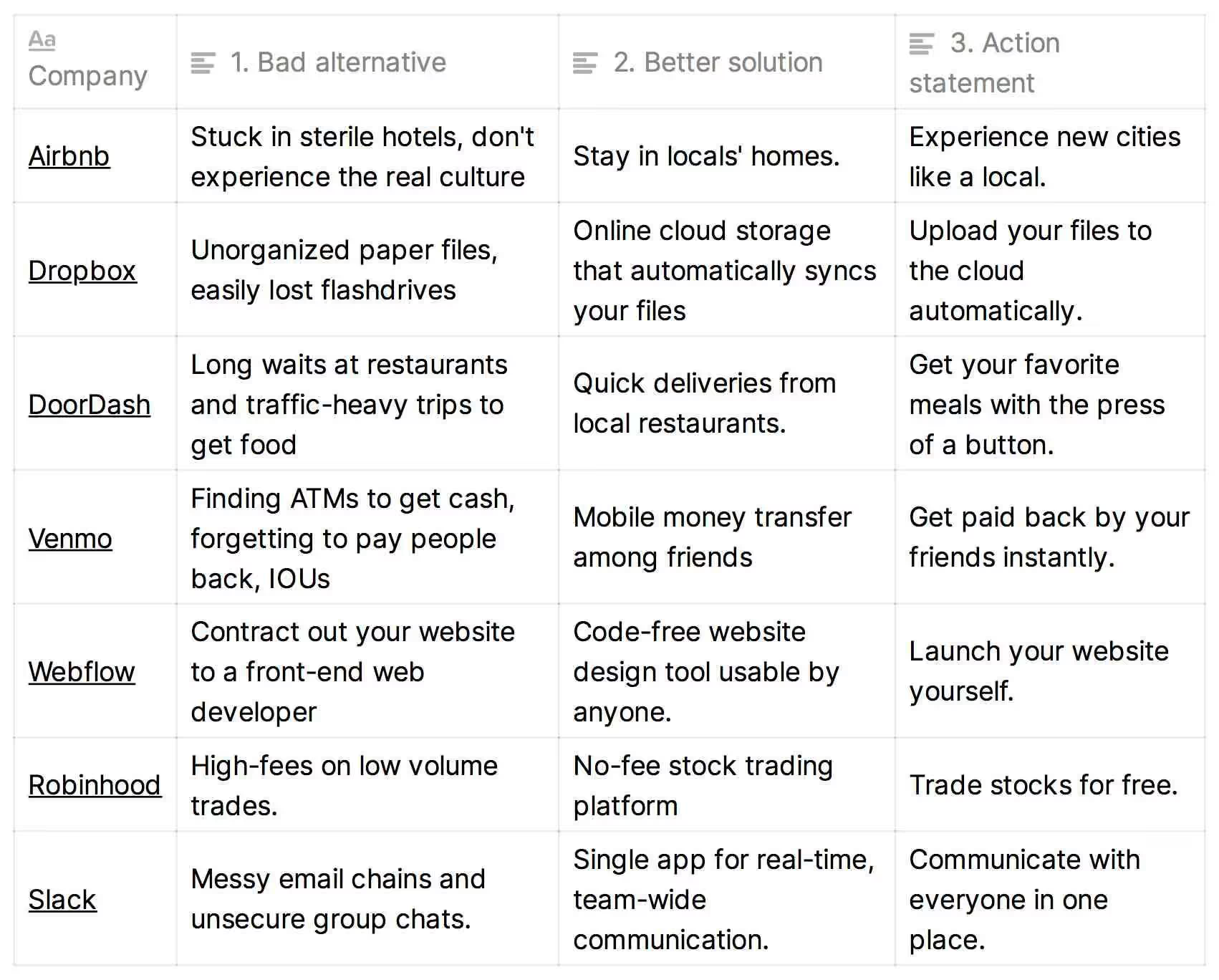
Nailing your value props (and knowing which one to lead with) is a critical component for startup success, and it’s a significant part of the Growth Program 2.0 curriculum. While this newsletter focuses on ATF copy, it’s inherently dependent on strong value props, so make sure you take the time to get them right.
Once you’ve got a concise action statement embodying your most compelling and/or differentiating value prop, let’s move to part 2.
Headline Pt. 2: Add a Hook
Layering a hook onto your marquee headline should do one of two things:
- Make a bold claim
- Proactively handle skepticism or objections
Let’s look at two examples for that first “bold claim” bullet below, where the option on the left is a vague statement, and the option on the right augments it with a claim.
Option A: Hooks that make bold claims

Seeing that specific claim makes it more enticing to readers. They’ll want to know how that’s possible, so they’re more likely to keep scrolling to find out.
Let’s look at another example that does something similar:

On the other hand, you can go too far with a claim and make a user’s BS-detector light up. Don’t cheapen your brand or compromise trust by sounding too good to be true, like this example below:
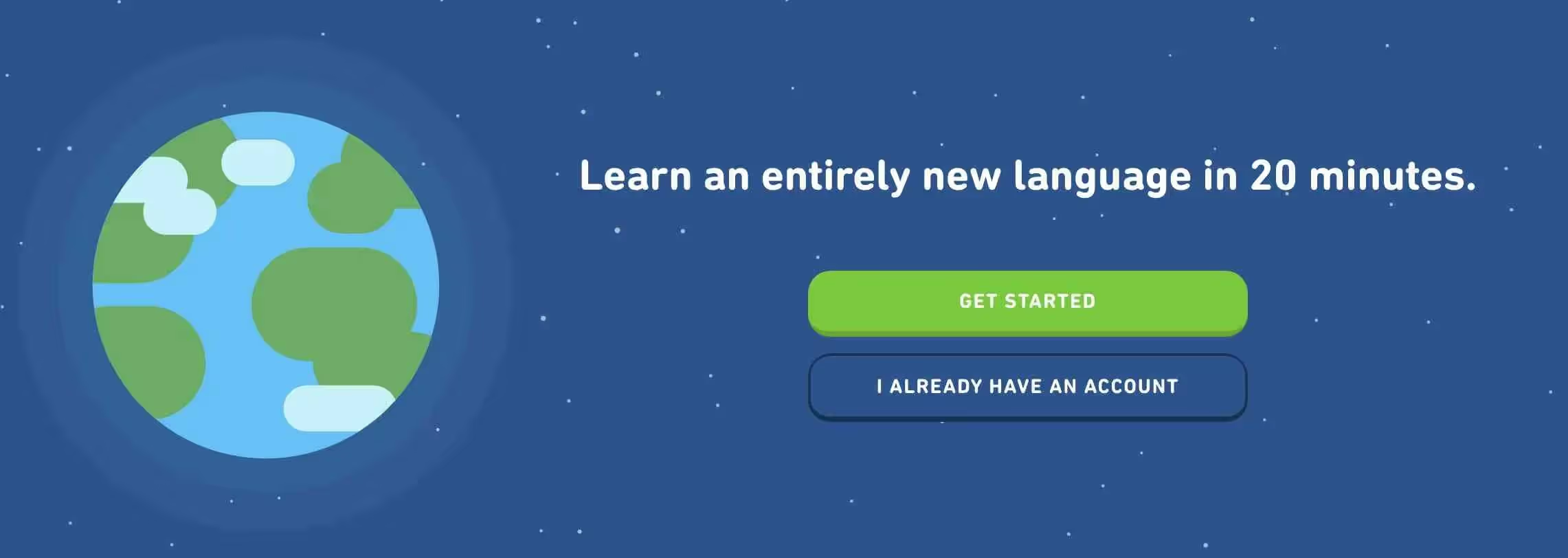
Option B: Hooks that shut down objections
Instead of a bold claim, you might decide to focus on addressing your users’ top objection(s).
Let’s look at the web design tool, Webflow, as a case for our example. Below is a sample ATF header, which hasn’t been paired with a hook yet:
”Build your own website.”
Seeing this, readers might have initial objections such as:
- “But I don’t know how to code. Doesn’t web design require coding skills?”
- “This will take way too long to learn. I don’t have time, I’m not a designer.”
- “It will probably be low-functionality and constraining, like other ‘easy’ site design tools.”
Now it’s Webflow’s job to identify which of these objections they can proactively address above the fold. Of course, addressing multiple objections can be effective, but it requires balance. If your header becomes bloated, it gets less effective. Here’s how Webflow might handle these objections in a smart way:

Don’t try to address every objection (even though we got lucky with a few here). You can do that further down the page. If you find you can only address one key objection in your header without going too wide, that’s okay.
But let’s back up. How do you identify your customers’ biggest objections in the first place? An easy way is to survey them. You can ask current customers these two questions:
- “What almost stopped you from buying?”
- “Why do you think non-customers haven’t bought from us yet?”
The answers to either of these will be objections.
Now let’s revisit our earlier examples, this time showing how our value-based action statements can be augmented to handle objections.
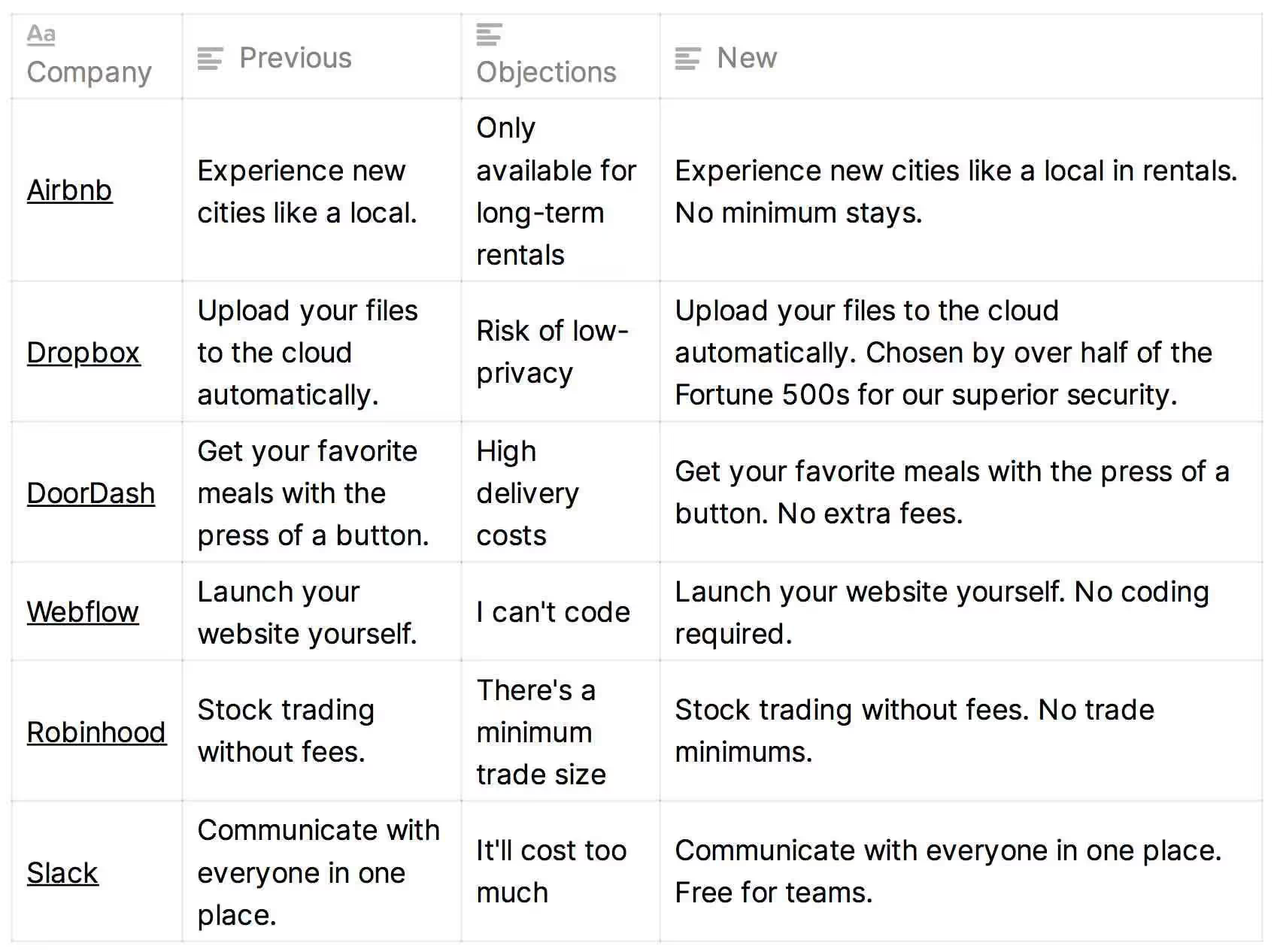
Now that you’ve got a hook to strengthen your argument (either through a bold claim or by addressing objections) let’s get it dialed in for the right people.
Headline Pt. 3: Speak to Your Customer Persona
So far, we’ve articulated the major benefit of our product or service clearly, then added a hook to keep visitors engaged.
Now it’s time to make sure we’re speaking to the right audience. It’s okay to go niche with this, if warranted. Think of it like a sliding scale: the smaller your target, the more pointed your message should be.
Start by listing who you’re selling to. Prioritize that list based on your business objectives and ROI, then directly address those personas in your ATF copy. Let’s look at some examples:
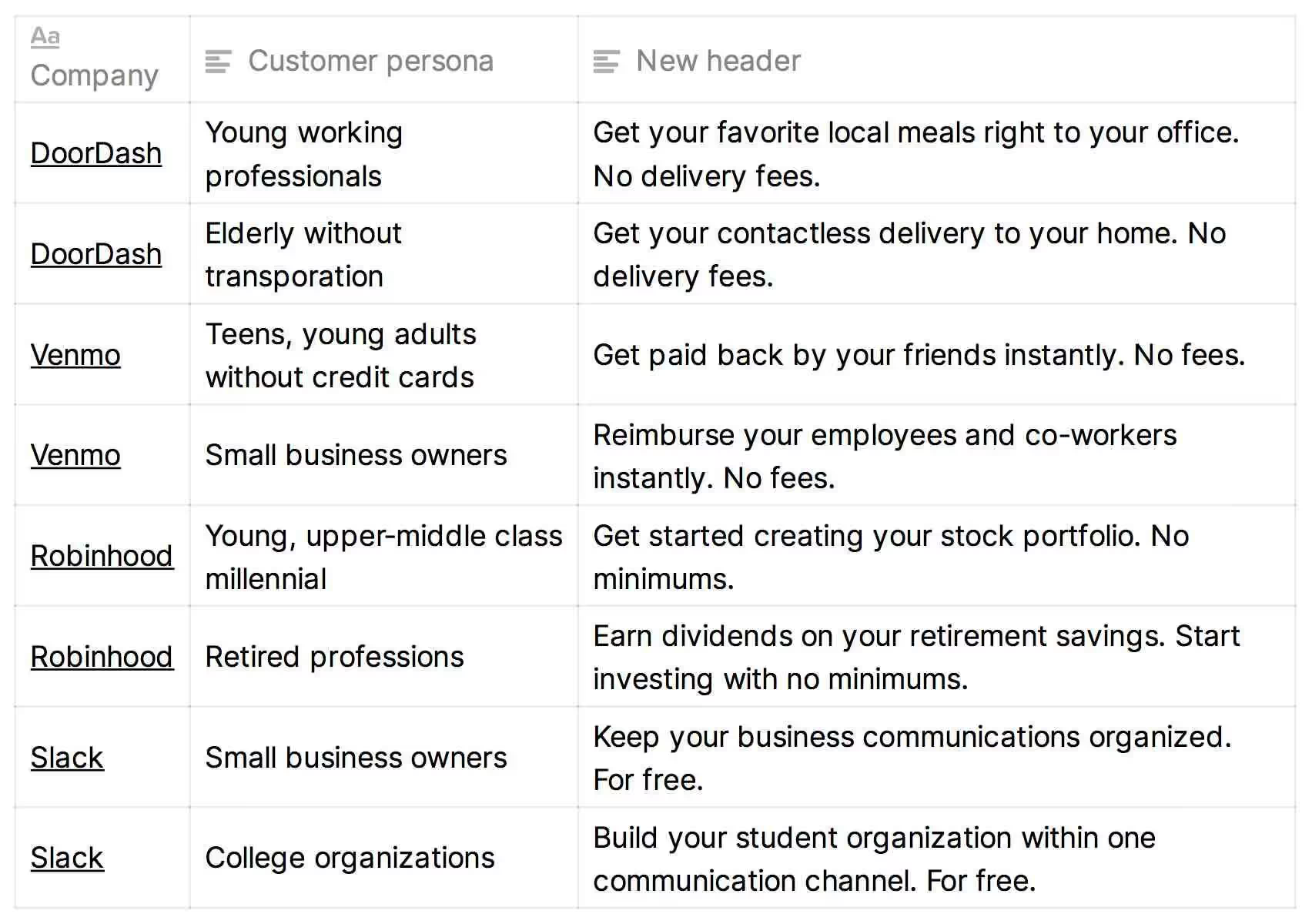
You’ll notice each of the examples features two customer personas. This is to show how the message can modulate between audiences, whether that’s through unique, audience-specific landing pages or something like a “choose your own adventure” approach, shown below (archived from Xeal Energy).

This is not to say you need a unique experience tailored to each possible customer subset. For startups gaining traction, it’s typically best to go deep on one before spreading yourself too thin. So make sure you aren’t hurting the UX of your primary target for the sake of appeasing secondary ones.
Now for Your Subheader
Up until this point, we’ve focused on what makes a great ATF headline:
- Find your strongest value prop and shape it into a specific benefit.
- Add a hook that either makes a bold claim or handles objections.
- Tailor your message to your most important persona(s).
Now it’s time to complement your header with a subheader, which will expand on what makes your product special.
If our headers focus on emotion and show how we can change a customer’s state for the better, the subheader follows up with supporting logic.
The subheader is commonly used for expanding on two things:
- What exactly is our product?
- Which features make our header feel bolder or more believable?

This archived subhead from jupiter.co first explains what their product is (green), then explains how its claim “Groceries Done. In Just 5 Minutes.” is possible (in blue).
This example is about as long as your subheader should be. Anything past two beefy sentences is probably too much. One strong sentence is more than okay.
A few more examples of this in action, below:
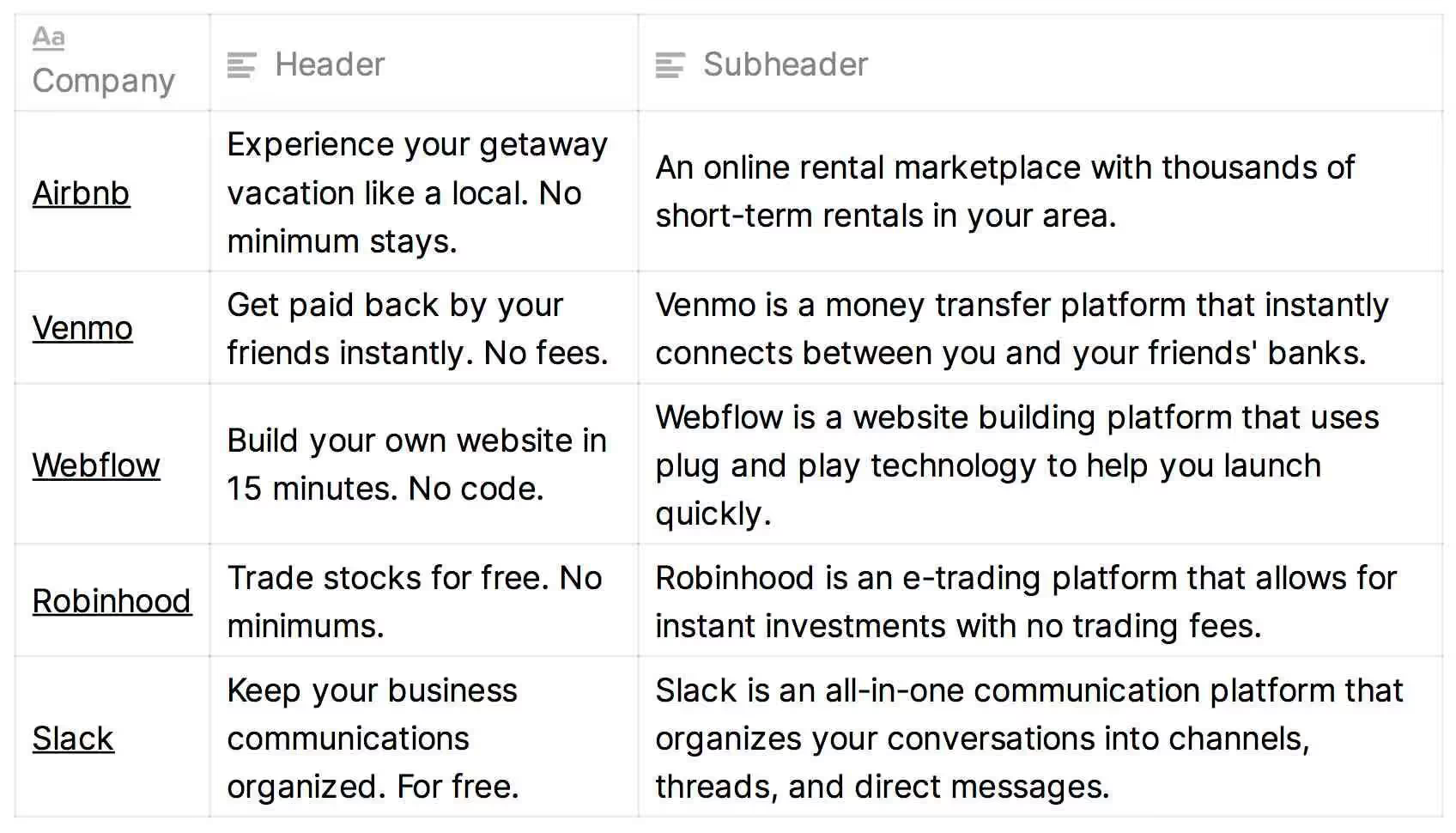
The Takeaway: Silence the Skeptics
Above the fold is where your audience’s skepticism is highest and their attention span is shortest.
When you nail it, you’ll see your bounce rate go down and your conversion rate go up. Mess it up, and viewers will jump ship after a couple seconds, assuming everything below the fold is more of the same dreck.
The good news is, this is one of the most measurable aspects of your marketing. You’ll know quickly if it’s working or not. Don’t tinker with it all the time, but iterate and A/B test, because the results are quick and hard to misread.
Gil Templeton
Demand Curve Staff Writer
Your Above-The-Fold Messaging Playbook
Insight from Gil Templeton — Demand Curve Staff Writer

Should You Take the Content Creation Plunge?
Insight from Gil Templeton — Demand Curve Staff Writer
Before we get into it, let’s level-set. You do not have to regularly create content. It’s a tall order, and it’s not for everyone (or every company). It can help you grow, but it’s not mandatory. And it’s a choice that requires lots of consideration.
So let’s say you’re at a traction-stage startup, and you’re working toward a major launch in a couple of months. There’s a great chance your time will be better spent on more valuable tasks.
All that said, if you DO commit to content creation (or you’re already married to the content game), please take the oath below, for your sake and your sanity.
Say it with us:
“I will not make bad content.
I will not make thinly veiled ads for my company.
I will not jump on trends that have nothing to do with my brand.
I will not push out filler to appease an arbitrary cadence or calendar.
I will not use AI slop in the place of original, interesting ideas.”
Because the worst thing you can do is commit real time and money to content creation, then fall straight into the trappings of bad content.
Remember, you aren’t competing with other founders or startups here. You’re competing with MrBeast, hilarious stand-up comedians, mind-melting guitar prodigies, nostalgic sports highlights reels, political rage-bait, thought-provoking articles from professional writers, insanely attractive people, and a million other things people can’t stop looking at.
So the bar for worthy content isn’t “good for a founder.” It’s “good enough to stop someone in their tracks.”

This might not be mind-blowing information, but if you look at the vast majority of content coming from businesses and founders, it’s completely unremarkable and not worth the trouble. So let’s promise not do that.
Budgeting Your Time & Effort
As Yoda once said, “Do or do not. There is no try.”
In that spirit, content creation is something you’ll need to commit real hours and intentions to. No half-assing. Whole-assing only.
In our opinion, you should start by committing 10+ hours a week (that number includes time spent by editors or contributors) for a test period of six months.
So whether you earmark one day of the workweek solely for content, or a solid hour + each day, you need to set time aside for it.
A breakdown of what those hours might look like:
40% Creating: Writing scripts, filming videos, recording a podcast, writing long-form blogs or newsletters, etc. The actual making of content.
30% Editing and Polishing: Tightening copy, cutting videos, editing photos, designing thumbnails, or working with an editor.
20% Distribution: Posting, repurposing to other channels (only after you have one down pat), formatting, scheduling, engaging.
10% Analysis and Experimentation: Reviewing what’s working, tweaking your approach, feeding your head with good examples that help you steal like an artist.
Knowing this is a serious investment, don’t keep going ad infinitum if you aren’t seeing measurable gains.
If after six months, you aren’t seeing signs of traction (no steady growth in views, no big uptick in followers, and no measurable lift in KPIs like leads, sign-ups, or sales), then it’s worth pausing and reconsidering. Content is an investment, but if it’s not compounding into results, it’s a distraction.
Watch-Out #1: Effort ≠ Performance
About a month ago, my dear friend, coworker, and collaborator at Demand Curve, Kevin DePopas, dropped a certified banger on LinkedIn that went “viral” by all measures.
It wasn’t a polished, produced video or a post that was months in the making. It was a lo-fi funny photo, paired with a caption that parodied the overwrought AI-inspired posts flooding LinkedIn. He said it maybe took 30 minutes to make.

The result was tons of engagement (826 comments!?) and a visible spike in Growth Newsletter sign-ups the day he posted it (July 26) and the days following, presumably from viewers being brought into the fold via his post.

Now compare that with this video he produced around the same time. It had a solid script, professional editing, well-designed graphics, hours of labor, and an actual budget. It got 27 measly likes, ultimately a “flop” considering the significant effort.
This is one major paradox of content creation; More effort doesn’t equal more impact.
Distribution is governed by unpredictable algorithms, human psychology, and good ol’ fashioned luck. A post you fire off from the back of an Uber at midnight might outperform your professionally produced quarterly campaign. You won’t know until you know.
So if you find you’re pouring money into a low-engagement video content series, say $1,500 for an editor, $1,000 for design work, $1,000 on equipment or studio time, and a handful of valuable team hours, it’s worth comparing that with what $5,000 in Meta ads could get you.
At Facebook’s current cost per click (CPC) rates ($0.89 or so), that same $5,000 could drive more than 5,600 visits to your website. That’s likely way more valuable than 50 likes, a couple new followers, and maybe a few website visits.
If the ROI isn’t there on your organic content production, you’re probably better off treating it as an experiment and putting those dollars into paid reach instead.
We’re not saying you shouldn’t invest in polished, produced content, but it’s an experiment that requires validation to justify a continued effort and budget. Which brings us to our next point…
Watch-Out #2: Don’t Go Deep Before You Go Wide
Until you know what actually resonates, do not continually repeat or double-down on anything.
Think about this like baking a batch of cakes. If you were a baker trying out a new recipe, you wouldn’t bake ten cakes at once using this one unproven recipe.
A smart baker would experiment with one cake at a time. And only once they were happy with the results would they make a big batch.
So don’t be precious until you have actual traction. Try different tones, formats, and hooks until something sticks.
Once you see an uptick (whether that's engagement, shares, conversions, etc.) lean into it. Hard. Ride the S-curve, and repeat what works again and again until you see diminishing returns. It might seem lazy, but it’s actually good discipline.
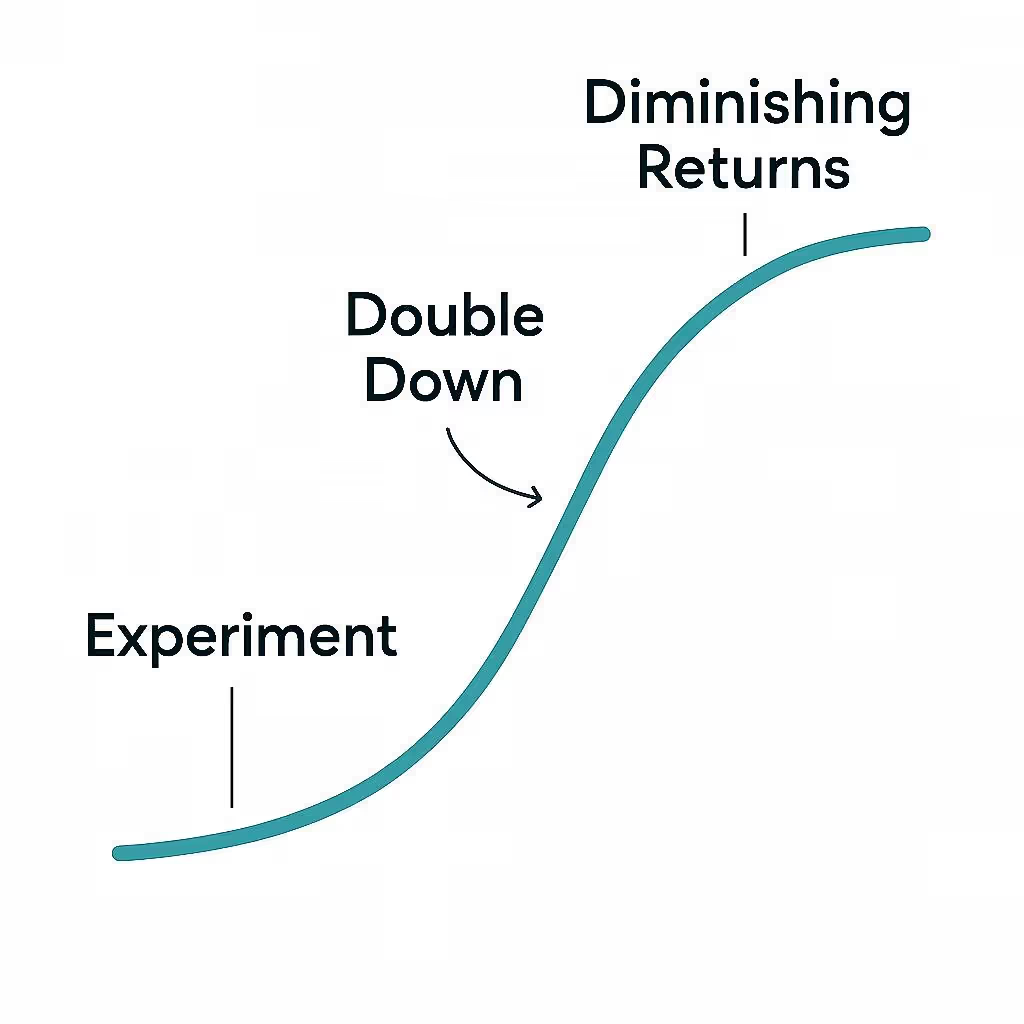
Once you have a certain format, tone, hook, etc. that’s working for you, make 80% of your content follow this exact approach, while saving 20% of your content for continued experimentation.
Many successful creators thrive by delivering the same proven style again and again. Look at these videos from creator Kane Kalloway on YouTube. Similar thumbnails, similar video length, similar video formats.

Another important note in this same spirit: make sure you gain traction on ONE platform before you try to show up everywhere.
That being said, when you’re in the “experiment” stage, make sure you’re trying different platforms, too. Don’t insist on creating YouTube content if it’s not gaining traction. Your videos might be stronger as Reels or TikToks. Again, you won’t know until you try.
The Takeaway
This is by no means an exhaustive guide on how to make great content (but for deep, tactical guidance on content marketing, our Growth Program 2.0 can help).
This is merely a way to help you decide whether a focused content creation effort is worth it for you, and to show you a couple high-level tips to keep you out of the tricky content quagmire if/when you do take the plunge.
If you’re going to commit, commit fully. And don’t be too precious with your approach or channel until you’ve got something that’s clearly working for you.
So experiment, double down, and repeat, until you're finally making content to your heart's content.
Gil Templeton
Demand Curve Staff Writer
Should You Take the Content Creation Plunge?
Insight from Gil Templeton — Demand Curve Staff Writer

Is It Time To Revisit Your Tagline?
Insight from Gil Templeton — Demand Curve Staff Writer
For all the changes in marketing and branding over the last several decades, the merits and tenets of a strong tagline remain largely unchanged in my book.
Your tagline should convey the greatest value you offer in a way that’s clear, differentiated, and emotionally resonant with your target…which can be a tall order to pack into five-ish words or fewer. That’s why it usually takes careful consideration and lots of iteration to get to a winner.
A good tagline is becoming more valuable as a way to differentiate in the increasingly competitive small business space. It can help you be a consistent, focused signal among the growing noise in your category.
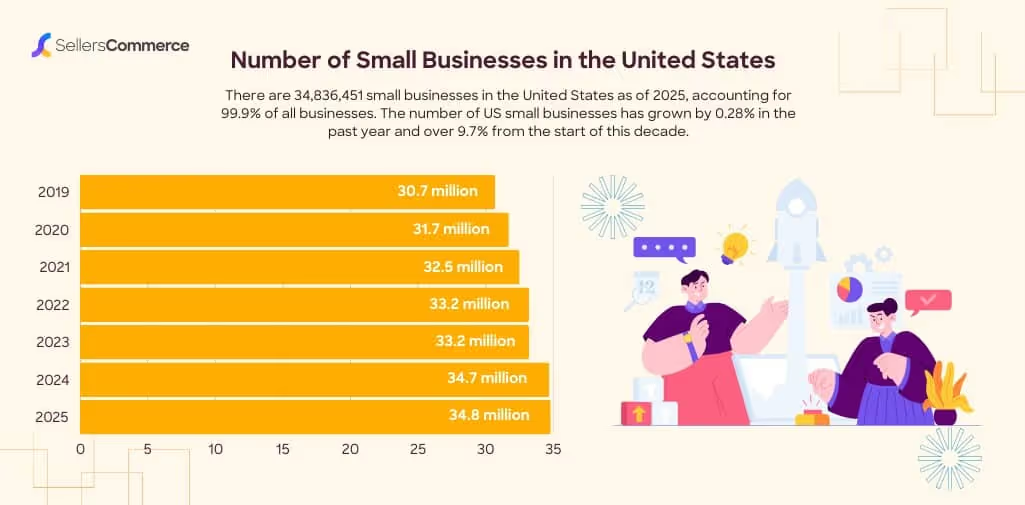
For startups and smaller businesses, I’d urge you to lock down on one consistent tagline across messaging efforts. Some household brand names (who pay for lots of TV ads) might use short-lived campaign lines or wrap lines for a campaign or quarter. But for lesser-known companies with smaller marketing budgets, diverting focus tends to dilute your message.
There aren’t exactly hard-and-fast “rules” for when to use a tagline, but think of it like your company’s shortest boilerplate message. In those instances where you’re making a first impression or leaving people with one key takeaway, you can default to your tagline.
You can use your tagline in your:
- Hero logo lockup
- Ad campaigns
- Web headers and meta descriptions
- Signage at a trade show or conference
- Email signatures
- Social bios
- Product packaging
- Branded swag
- Loading screens or video intros
- Pitch decks
- Business cards or letterhead
How to Assess Your Current Tagline
If you already have a tagline, check yours against this basic criteria to see if you have a winner, or if you need to reconsider. This is an admittedly subjective topic, and there are outliers that might work well, but these three questions are here to serve as your sounding board and keep you honest.
1. Is your tagline clear?
This doesn’t mean it has to describe your company or call out your industry, but it should convey what you make possible, what you can make go away, or the shift someone feels after using you.
It should be focused and specific. Ask yourself (or better yet, ask someone else) “Does this convey the general gist of the value we provide?”
Taglines for a meal kit service:
Clear example: Solve dinner in 15 minutes.
Unclear example: Redefining how people eat at home.
Takeaway: The clear example conveys the benefit (saving time) and lets readers gather that it’s a meal kit/prep service. The unclear example is a grandiose nothing-burger that requires more context for any clear takeaway outside of “food.”
2. Does it differentiate the company?
This doesn’t have to be (and usually isn’t) an explicit claim, but it should either convey your unique POV or hint at what makes you unique inside the competitive set.
Ask if your closest competitor could credibly use your same line. If so, it’s probably not defensible. Differentiated taglines highlight a well-defined stance, benefit, or use case.
Taglines for a plant-based snack brand:
Differentiated example: Crave junk. Eat plants.
Undifferentiated example: Snacks you can feel good about
Takeaway: Differentiation in a tagline does not need to mirror your UVP or be a competitive message. The first example here is differentiated, simply because it takes a stance that feels unique, bold, and conveys their value for a specific use case. The bad tagline could live (and probably does live) across hundreds of brands.
3. Does it stir up an emotion?
The best taglines hit you in the gut. The easiest way to test it is by asking whether it makes a reader feel something beyond sheer understanding or comprehension.
It doesn’t have to make someone “emotional.” But ask yourself: Does it excite? Spark curiosity? Make them feel seen? Create a sense of connection? Provide a sense of relief? Make them proud? If your tagline does something like this, it’s pulling the emotional lever.
Taglines for a farmers’ market collective:
Emotional example: Know the folks feeding you.
Emotionally empty example: Farm-fresh food every week.
Takeaway: The strong example evokes a sense of deeper connection and delivers on that natural human desire. The weak example reduces the product(s) to a commodity with descriptive, emotionally empty copy.
(For more on avoiding descriptive copy and instead answering “What’s in it for me?” to your audience, see a fan-favorite Demand Curve resource here.)
Now, to evaluate your tagline:
Most good taglines can only deliver on one or two of these in spades. So instead of asking, “Does my tagline totally nail all three of these?” ask yourself, “Does it nail at least one of these really well? And do I avoid the common pitfalls of being unclear, undifferentiated, or emotionally flat?”
So if your tagline is clearly violating one of these no-nos (lacking clarity, sounding like anyone else, or being devoid of emotion), you should consider updating it.
In that same spirit, if your tagline doesn’t pull at least one of these three levers in a major way, you might want to try for a new one that does.
Tips for Writing a New Tagline
I’ll caveat things again by saying: there are many iconic and enduring taglines that violate a tip or two below, so think of these like general best practices to help you get to solid ground.
For your starting point, ask yourself what feeling, promise, or change you most want to embed in someone’s head. A tagline’s job is to convey your value in a few memorable words, so begin by exploring the core benefit, belief, or transformation your brand makes possible.
A lot of startups don’t have the luxury of mass brand awareness, so the rules here are slightly different than those for household names. For startups and smaller businesses in need of a hardworking, helpful tagline, follow these general tips when writing yours:
Tip 1: Make it as punchy as possible
As a copywriter who’s written lots of taglines over the last decade, I’ve noticed there’s a natural ceiling at about five words. A tag longer than five words is harder for people to repeat or remember, and it will likely pose issues down the road (your logo lockup, fitting into small spaces, lower recall, etc.).
But this doesn’t necessarily mean, “See what you can do in five words.” Try to get it down to three or four if possible, and judge every word as “guilty until proven innocent” to ensure it’s working hard for you. Your word count and character count are precious here. Make every one count.
To make your tagline as short as possible:
- Remove any qualifier words (really, truly, more, better, innovative, modern, etc.) that aren’t mission-critical.
- Ditch the throat-clearing setup words (“Helping you…”, “Designed to…”, “Making it easier to…”).
- Swap phrases for single words where possible (“Get rid of” → remove; “Move faster with” → accelerate.)
Example A: Payroll Software Company
Too verbose: Simplifying the way you pay employees.
Punchy: Make payroll stupid-simple.
Example B: E-Commerce SaaS
Too verbose: Sell your products across every channel.
Punchy: Sell everywhere.
Tip 2: Be singular
Your tagline should only make one point. You might be tempted to load it with multiple benefits, audiences, or ideas, but that will likely dilute your message.
A great tagline shines a bright spotlight on just one promise or benefit. Be so sharp and focused, the reader instantly knows what to take away.
Example A: Healthcare payment platform
Too scattered: Easier payments for doctors and patients
Singular: Simplify every care payment.
Example B: Fitness App
Too scattered: Track workouts. Count calories. Build confidence.
Singular: Get healthier every day.
Tip 3: Be actionable
There are plenty of great taglines that don’t do this, but using the imperative case and instructing people to do something is generally a strong approach; It’s certainly not THE only way to write a tagline, but it tends to keep you on the right track.
Some all-time classic taglines like “Think Different,” “Open Happiness,” and “Just Do It” embrace this angle to make their point.
You’ll notice I’ve naturally been doing this in my examples (taglines that begin with words like solve, crave, know, make, sell, simplify, get.)
Being actionable can do you several favors:
- It makes your tagline a call-to-action in itself, giving readers something to do or become instead of just giving them an idea to process.
- It puts the customer at the forefront, and shows them what they stand to gain as opposed to a self-important description of your company.
- It forces you to be clear. If you can tell someone what to do in a couple of words, it’s a good sign you’ve boiled down your value to a very focused form.
Example A: Travel-booking platform
Inactionable: Your fastest travel booking solution.
Actionable: Book travel faster.
Example B: Cloud storage SaaS
Inactionable: Better cloud-based file storage.
Actionable: Access files anywhere.
Tip 4: Play the numbers game
Much like naming a brand or writing a killer headline, the process for writing a tagline is largely a numbers game. You should really get a couple hundred options on the page before you whittle the list down to a few favorites to stress-test and consider.
First, go wide. Come at it from every possible angle and get as many types of ideas on the page as possible (aim for 200+). Riff with a partner or coworker for a few marathon sessions. Use LLMs to return tons of options. Keep going and going.
Then, go back through the list and choose 5 to 10 favorites. Rewrite them and rewrite them to ensure the idea is as short, clear, and compelling as possible.
Once you’ve got your final contenders, stress test them across various contexts (logo lockup, ad creative, etc.) to help you pick “the one.”
Then, ask a few trusted customers (or other trusted opinions outside of your company) if they “get it” and if they can repeat it easily.
If so, bag it and tag it. You've got your tagline.
Gil Templeton
Demand Curve Staff Writer

First, Some Background: How AI Rewrote the Rules of Search
Insight from Kevin DePopas, Demand Curve Chief Growth Officer + Gil Templeton, Demand Curve Staff Writer
Before we break down the Loop framework, let's get on the same page about why a new playbook is even necessary.
The core problem is that the traditional inbound marketing funnel (largely built on attracting organic traffic from search) isn't quite flowing like it used to. The evidence is mounting…
- The Rise of Zero-Click Search: Nearly 60% of Google searches now end without a click. Instead of browsing links, people are getting answers directly from generative AI.
- Scattered Customer Attention: Your audience’s attention is now fragmented across a dozen different channels like YouTube, TikTok, Reddit, and podcasts.
- The Declining Power of the Blog: Even HubSpot is now seeing 90% of their leads coming from non-blog sources, with YouTube leads up 100% and newsletter leads up 90%.
This is where the distinction between SEO and AEO becomes critical. Traditional SEO is largely determined by how well your site indexes on a single platform (mostly Google), driven by content quality, technical on-site SEO, and backlinks. AEO is different. LLMs don't merely pull from your website; they synthesize answers from data across multiple surfaces where your brand is mentioned and described.
Here's an example to make this concrete. In the pre-LLM era, getting your product mentioned in a Reddit comment or a YouTube video was great for awareness, but it wouldn't help your "SEO juice" without a direct backlink. In the LLM era, that's no longer true. Since AI models are trained on full video transcripts and entire comment threads, simple brand mentions now impact how you show up in AI answers. As HubSpot puts it, brand mentions are the new backlinks, and things like Reddit posts, YouTube videos, and reviews matter more than ever.
So like it or not, it appears we’re no longer just optimizing for Google's crawlers. We're also optimizing for a swarm of AI models that learn from the entire internet.
The top sources LLMs cite:

Decoding the Loop: A Founder's Translation
Seeing that list of sources can be overwhelming. The idea of managing your brand's presence across Reddit, YouTube, and a dozen other platforms feels like a tall order for most lean startup teams.
This is where HubSpot's Loop Marketing comes into play. It's a framework designed to bring order to this chaos by helping you tell a consistent, compelling story across all the surfaces AI models learn from.

HubSpot's framework is a cycle with four stages. Here's the official definition, and our translation of what it means for your AEO strategy.
1. Express
- HubSpot’s Definition: Define your brand’s unique taste, tone, and point of view before you bring in AI.
- Translation: Nail Down A Unified Message. Before you even think about creating content, it’s smart to decide on the single, consistent message you want AI crawlers to find everywhere. This is because LLMs appear to get more confident when the same story is repeated across multiple trusted surfaces. If your message is fragmented, so is their understanding of your value.
For example, let's say your company is a new AI note-taking app (like Fathom or Fireflies). If your website claims your key differentiator is "seamless integration with project management tools," a YouTube review you sponsored highlights its "superior transcription accuracy," and a Reddit thread praises its "unbeatable price," an LLM sees three different, conflicting signals. AEO experts are urging marketers to pick one core message and stick to it.
2. Tailor
- HubSpot’s Definition: Use AI to make your interactions with customers personal, contextual, and relevant at scale.
- Translation: Plan Your Content for Specific Audiences. This is the strategy phase. Once you have your core message (from the Express stage), “Tailor” is about using AI to identify your key customer segments and plan content that speaks directly to their pain points. The power of AI here is making this level of personalization feasible for a small team, where it might have previously been cost-prohibitive.
Continuing the AI note-taker example...Let's say you've decided your most strategic differentiator is "seamless integration." You analyze your user base and find three main archetypes: startup founders, enterprise sales execs, and growth marketers. The Tailor phase is where you can use AI to help brainstorm, outline, and create laser-focused landing pages, blog posts, Reddit threads, etc. for each of those segments, all reinforcing your chosen core differentiator.
3. Amplify
- HubSpot’s Definition: Diversify your content and distribute it across the channels and surfaces where both humans and bots will find it.
- Translation: Execute Your Plan on the Right Surfaces. If “Tailor” was the strategy, “Amplify” is the execution. This is where you take the content plans you created and deploy them on the high-value surfaces that LLMs are crawling. You’re strategically placing your tailored content where it will have the most impact for AEO.
4. Evolve
- HubSpot’s Definition: Use AI to iterate on your strategy quickly and effectively in real time.
- Translation: Measure and Adapt. This is the crucial feedback loop. Once you’ve amplified your content, you need to track what’s working. For example, if you launched a Reddit AEO strategy, the Evolve stage is where you check back in. Are you seeing an increase in brand mentions? Is your AEO score improving in tools like HubSpot’s AEO grader? This is where you analyze the data and decide whether to double down, pivot to a new surface, or refine your messaging.
This framework is general enough to be executed with any toolset. However, it's clear that HubSpot has intentionally built its product suite to power each stage of this loop, making it worth a look if you're searching for an integrated solution to manage the whole process.
So, What Now? Four AEO Topics We're Thinking About at Demand Curve
Look, we could attempt to give you a 7-step playbook on how to execute an AEO strategy. But frankly, we're learning AEO for the first time too, and it's top of mind considering the recent launch of Growth Program 2.0. So after digging into HubSpot's Loop framework and the broader conversation around AEO, here are the four big takeaways our team is discussing at Demand Curve.
1. Establish A Baseline
Before diving into a new strategy, it’s always smart to know your starting point. You can't improve what you don't measure, and AEO is no different. Since this is new territory for most of us, getting a clear baseline can feel a bit abstract.
To establish a baseline, we started with HubSpot’s free AEO Grader. The tool generates an AEO score out of 100 by scanning a URL, and provides an actionable checklist of recommendations. The score is based on factors that AI models prioritize, like content readability, author authority, and trustworthiness. It provides a quick snapshot of where a site stands before you make any changes.
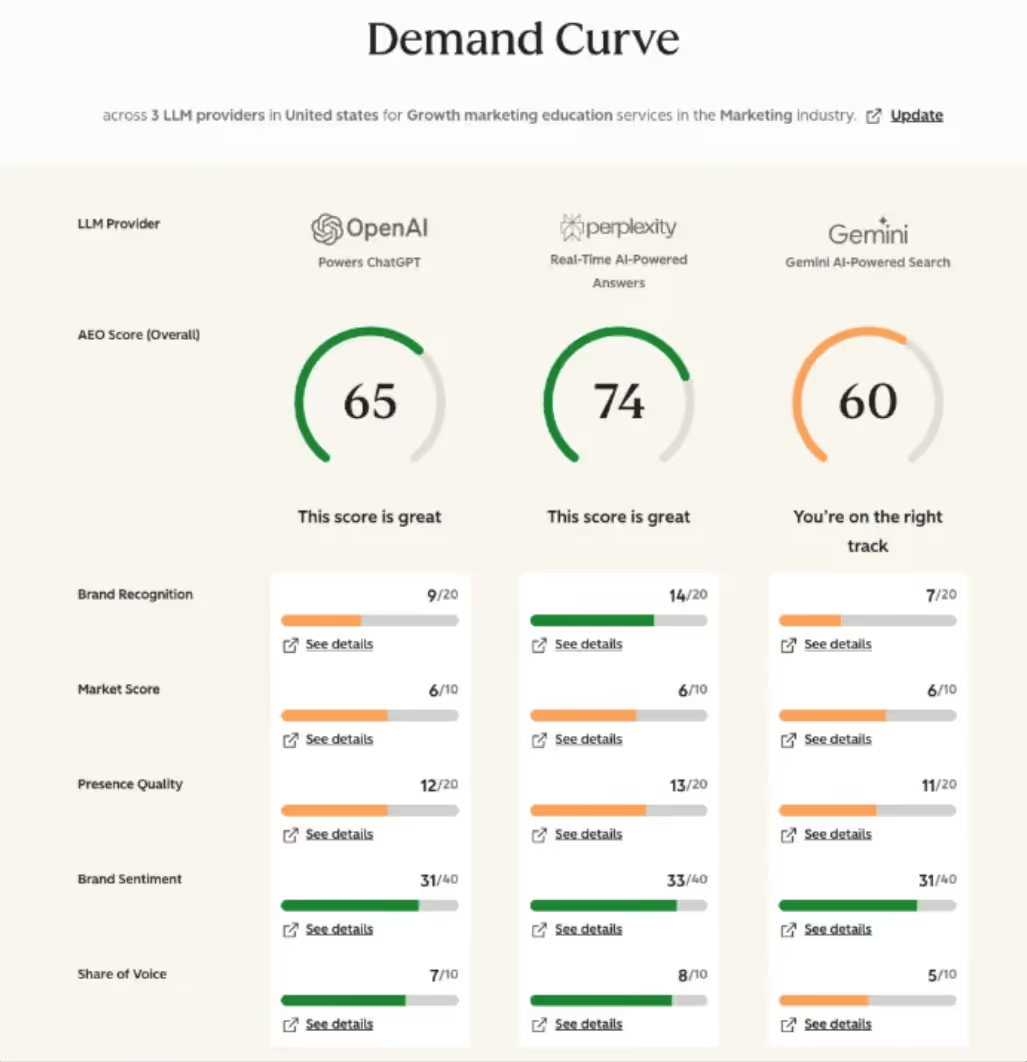
2. Good AEO Starts with Good SEO
The idea of optimizing for a dozen new platforms is daunting, so our next question was, "Do we have to throw out our entire SEO playbook?"
The answer, thankfully, is no. As SEO expert Matt Kenyon explains, ranking in AI search largely boils down to "doing good SEO with a few important nuances." The established fundamentals are more important than ever.
AI models still need to find and understand your content. This means:
- Crawlability is key: AI crawlers like OpenAI’s GPTBot and Google’s crawlers need to be able to access your site. Your robots.txt file must allow them in. If you’re non-technical, it might be worth hiring someone to make sure your site can be crawled.
- Structure matters: A clear hierarchy of headings, bullet points, and tables makes your content easy for both humans and AI to parse. Groundbreaking, right?
- Schema is your friend: Using schema markup to explicitly label your content (e.g., as an article, organization, or product) is critical for helping AI understand exactly what it’s looking at.
The takeaway for us is that strong SEO practices are the foundation for any AEO strategy. So, if you're already doing that, you're in a great starting position.
3. We're Auditing Our Brand's Digital Footprint
HubSpot's framework points out that LLMs synthesize answers from data across multiple surfaces. While a backlink from an aggregator site like G2 or Crunchbase might not carry the same weight as an editorial link in traditional SEO, its role in AEO seems to be different.
LLMs build confidence by seeing the same story repeated across multiple, trusted platforms. This has us thinking about the importance of brand consistency everywhere. We're planning a sprint to audit and align our messaging on platforms like:
- Wikidata (the structured database behind Wikipedia)
- Business directories like G2, Crunchbase, and Google My Business
- Niche industry databases
If an AI model sees Demand Curve described consistently across our website, LinkedIn, G2, and YouTube transcripts, it's more likely to trust that narrative and repeat it in an answer. This makes auditing our "digital footprint" for consistency a new priority.
4. We're Systematizing Outreach for Brand Mentions
The idea that "brand mentions are the new backlinks" is probably the single biggest shift for us. While Demand Curve already has a decent SEO presence from nearly a decade of consistent content creation, our social presence outside of LinkedIn is, well…lacking. An unlinked mention in a Reddit comment or a mention in a creator's YouTube video now appears to be a powerful AEO signal.
With that in mind, our next step is to get more high-quality mentions on the surfaces that AI is trained on. This effort looks a lot like a traditional link-building or digital PR campaign, but the goal is different. We're planning to target creators on YouTube, Reddit, and high-signal newsletters to generate authentic conversation and mentions, whether linked or not.
A key part of this effort is making it easy for creators to talk about us (and make content about us). To that end, we're taking a page from our favorite creator marketing expert and building out media drop kits that give creators everything they need in one place: our core message, stats, unreleased brand assets & videos, curiosity-inducing storylines, etc.
The Bottom Line
Ultimately, HubSpot's Loop framework provides a solid mental model for organizing these efforts. Define your story (Express), tailor it (Tailor), seed it where it matters (Amplify), and measure the impact (Evolve). The inbound traffic playbook is no longer about winning a single algorithm on a single platform (we're looking at you Google). It's about shaping the entire conversation around your brand across the open internet.
The beauty of this approach is that you can execute it with any toolset, making it accessible to most teams. And while you can certainly run this play using your own stack, it’s worth noting HubSpot has built its entire marketing suite around the concept of Loop Marketing. So whether you patch together your own process or give Hubspot’s AI Marketing Suite a shot, it’s probably time to start thinking about your AEO strategy. Because the brands that move quickly will become the default answer in their niche.
Kevin DePopas
Demand Curve Chief Growth Officer
Gil Templeton
Demand Curve Staff Writer
First, Some Background: How AI Rewrote the Rules of Search
Insight from Kevin DePopas, Demand Curve Chief Growth Officer + Gil Templeton, Demand Curve Staff Writer

The Direct Sales Trap
Insight from Gil Templeton — Staff Writer, Demand Curve
Let's start with some math that might look appetizing on paper, but was actually limiting doopoll’s growth.
Right before they joined the Growth Program, enterprise contracts made up 75% of doopoll's revenue. These were great deals for the Welsh startup (multi-year commitments, low churn, high value) but each one required one of the co-founders, Marc or Steve, to personally close it. This meant non-stop meeting prep, flights, and handshakes to make sales.
The other 25% of their revenue came from SMEs paying between £9 and £100 per month. This segment had potential for systematic growth, but the founders had been too busy flying around to meetings to stop and figure it out.
That’s when Marc had the realization they could either keep grinding on big enterprise sales, or they could build a system that sold to the masses while they slept.
They chose the system.
Step 1: Getting Outside Help
In early 2019, Marc did something smart. He admitted he didn't know how to build a growth engine.
He’d read about Gil Akos at Astra going through the Demand Curve Growth Program and spoke with him after reading our guides.

The entire program cost about the same as four days of consultant time, so he joined.
"We were fairly green to this model," Marc wrote.
They set three goals:
1. Find a channel that reliably brings in paying customers.
2. Keep customer acquisition cost below lifetime value.
3. Increase conversion from website visitor to paying customer.
This made sense, but they didn’t know how to do it without wasting months on avoidable mistakes. Enter the Growth Program.
Step 2: The Value Prop Reality Check
So many startups struggle to develop clear, compelling value propositions. This is one of the fundamental building blocks for growth, and it’s why we help founders build the systems to convey value in an effective way.
Strong value propositions can be the difference between stumbling out of the gate and having people beat down your door to buy what you’re selling.
And like so many founders, Marc thought he knew why customers bought doopoll. He’d pitched hundreds of them personally. But when he reviewed his work with his Demand Curve coach (a resource available for VIP Plan subscribers), the feedback was harsh but enlightening.
The final version of the value prop worksheet was “almost unrecognizable from draft 1.”
It became the foundation for the rest of the work. The copy changes, funnel fixes, and pricing decisions later in this story all stemmed from these clarified value propositions.

Step 3: Competitor Intel
Marc spent two full days going deep on analyzing competitors.
He signed up for each one of them, captured full onboarding flows, analyzed ad copy, documented their pricing psychology, and more.
"There were things that were bad and things that I loved about each of them," he wrote.
He said SurveyMonkey's Genius tool was "genuinely something I’m jealous of."
Founders often skip this part because it’s time-consuming, and they think they already know the space. But Marc’s teardown of the competition revealed real gaps and opportunities for growth.
Step 4: Finding What’s Broken
This is where Marc discovered how broken their funnel actually was.
He installed Hotjar to watch user behavior. Then he did a first-time user test on himself.
His painful observation was that users were confused. "It's not obvious that I can create surveys. Our buttons say 'poll' but our marketing says 'survey.'"
Super basic stuff, but it was killing their conversions.
Then he watched Fullstory sessions from people who didn't convert. It was rough. Users clicked around, got lost, and left.
"You have no idea how hard your 'simple' product is to use…until you’ve watched users (who didn't make it) try to use it."
Step 5: Rewriting Everything
Marc started his career as a journalist. He could certainly write, but at the time, he didn’t know how to write copy for an effective landing page.
He drafted a new landing page and sent it to his Demand Curve coach for review. It came back covered in edits.
"It stung," Marc admitted. But the rewrite pulled directly from the refined value props. It might not have won any points for creativity, but it was extremely clear and compelling.
The results were immediate, and they saw conversions jump.


Step 6: The Failed Tattoo Campaign
Before joining the Growth Program, Marc tried cold outreach. It involved sending emails with the subject line:
"I want to work with you so bad I got a {firstName} tattoo on my arm."

The responses were...mixed.
A few loved it. Most ignored it. Others were actively hostile toward it.
When his coach suggested trying cold outreach again, Marc was skeptical. But their approach was going to be different: short, plain-text emails to well-targeted segments.
Results improved. People replied without the backlash, but it still didn’t clear the bar. They didn’t have a repeatable growth engine yet.
Step 7: Turning the Ad Faucet On
Setting up Google Ads and Facebook Ads took 21 days. Then Marc hit "go."
"The rush of seeing a huge stream of people from all over the world was hypnotic and addictive," he wrote.
For 14 days, traffic poured in. They doubled their ad spend to get meaningful data.
Then reality hit: very few actually converted to paying customers.
Marc described it perfectly, "The come-down is a killer."
Step 8: The Power of the Pause
Marc was panicking and burning cash with just a few sales. He asked his Demand Curve coach for help.
His coach’s advice was to turn off the ads. Fix the funnel. Then turn the ads back on.
"Taking that advice was one of the smartest things I've ever done," Marc wrote.
With ads off, he could turn his focus to why people weren't converting.
See the actual email from their Demand Curve coach below.

Step 9: The Freemium Model Breakthrough
Their data revealed the core problem: the 14-day trial didn't match the way people actually used doopoll.
For example, event organizers set up surveys weeks ahead of time, but the 14-day trial ended before they saw any value come to fruition.
Marc switched to freemium:
- Create unlimited surveys: Free
- First 10 responses: Free
- Pay when you see value: £39/month
Within 30 minutes of launching, they got their first conversion. Then another. Then another.
"We used to have a Slack bot that pinged us 'Tuscan Leather' by Drake when someone paid through Stripe," Marc wrote. "We had to turn it off. We were getting too many notifications."

Step 10: The Testing Cycle
Marc developed a systematic approach:
- Form a hypothesis and ship a change
- Run ads for 1–2 weeks to bring in ~200–300 users
- Pause ads
- Measure behavior and conversion
- Plan the next test
He was starting to practice what the Growth Program teaches: sustainable growth comes from stacking small, repeatable improvements, not going all-in on one silver bullet.
Step 11: The Big Swing
For one of their first major A/B tests, they didn't test something minor like CTA button colors. They completely rebuilt the landing page.
Marc stole inspiration from Notion's template gallery approach. "Hands up: we took heavy inspiration from what they did," he admitted.
The test ran for one week. The new page converted at 14%, up from 4%.
That's a 250% improvement from one test.

The Numbers That Matter
After six months (September 2019 to March 2020):
- MRR growth: 800%
- Monthly customer growth: 75% average
- Conversion rate: 4% → 14%
- CAC:LTV ratio: Around 1:1.5-2 (target was 1:3)
- Founder involvement in sales: Zero
But what matters most is this growth came from low-touch acquisition. The founders only talked to customers after they'd already paid. They no longer had to be in the room, selling to large clients only.
Three Lessons from Marc's Journey
Marc shared these three key takeaways from his transformation:
1. Growth is about systems rather than hacks
"A lot of people end up with poor results because they focus on tactics that worked for people they know. Strategy is more important, and a systematic approach to strategy is best of all."
2. Most people don't grow astronomically overnight
"It's usually the accumulation of small gains over time that makes an impact. If you take a systematic approach to growth, you don't need to get hung up on rapid growth figures."
3. Growth for a SaaS project is a whole business project
"Opportunities get missed when growth work isn't driven across teams, including product, marketing, sales, and customer success."
The Lesson For You
A lot of founders will read Marc’s story and go back to grinding out the wins. But grinding harder in a broken model doesn’t fix growth issues.
What worked for Marc (and what works for basically every founder we’ve met) is building a system that compounds. Not a huge heroic pivot or a lucky hack, but rather a steady run of the right changes, stacked week after week.
And that’s exactly what we teach in the Growth Program 2.0: many of those same frameworks Marc used to turn doopoll into a sustainable growth engine.
Gil Templeton
Staff Writer, Demand Curve
No results found. Clear Search.







